

HORROR, FAIRY TALES, AND THE WORLDS IN BETWEEN











HORROR, FAIRY TALES, AND THE WORLDS IN BETWEEN









Dear reader,
As spring comes into full bloom and rising temperatures offer a glimpse of the season ahead, many are beginning to look in earnest at options for this year’s summer holidays. Increasingly, however, warmer weather and growing concerns about the environmental footprint of travel are leading holidaymakers to consider less obvious choices than in previous years. With its pleasant summer climate, strong sustainability credentials, beautiful landscapes, and thriving culinary and cultural scenes, Scandinavia offers an attractive alternative.
In this issue of Scan Magazine, we look at a selection of exhilarating and inspiring summer experiences in and around the cities of Sweden. From Stockholm’s archipelago, listed by National Geographic as one of the best places in the world to visit this year, to Gothenburg’s floating maritime museum and stunning botanical garden – whether you’re into an active, cultural or leisurely holiday, Sweden has something for you.
Norway, of course, also attracts many travellers with its stunning nature and rich history, and this month we focus our lens on the numerous unique places and unforgettable experiences of Kristiansand – a vibrant coastal city with a rich cultural heritage, lively
atmosphere, and easy access to some of southern Norway’s most beautiful landscapes.
Norway is also the home of this month’s cover star, Lea Myren, who is currently starring as the ugly stepsister in the horrifically brilliant adaptation of Cinderella, The Ugly Stepsister. The movie views the story through the eyes of the sister and brings into play a host of highly relevant questions of beauty standards, body perception and patriarchy.
Finally, as always, we present a host of beautiful Scandinavian design, not least in our selection of innovative Danish design and architecture. Outstanding hotels, world-class culinary experiences and historic gems are just a few of the other highlights you will find when flipping the page.
We hope you enjoy reading the magazine as much as we enjoyed creating it.

Signe Hansen, Editor
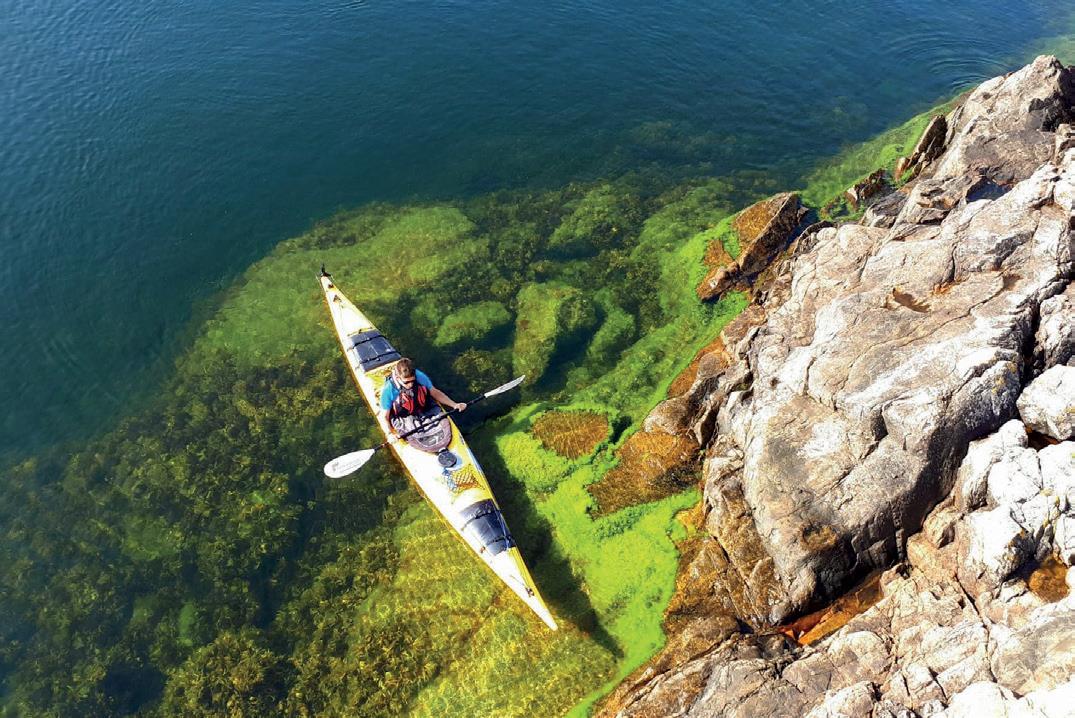
6 Lea Myren – on horror, fairy tales and the worlds in between
From the small screen to the silver screen, Norwegian actress and model Lea Myren is making waves with her debut as Elvira in Den Stygge Stesøsteren (The Ugly Stepsister). This stomach-churning take on the classic Cinderella story flips the familiar tale on its head, offering a dark, thought-provoking exploration of beauty standards, body perception, and patriarchy. Fearless in her performance, Myren is also not afraid to speak her mind, and here you can read her thoughts on horror, fairy tales and everything in between.
10 Danish design innovations, an architectural revolution, and summer fashion
On this month’s design and architecture pages, we explore a number of innovative Danish designers as well as a Swedish underwear icon, and what could be an architectural game-changer. And our Fashion Diary brings tips on staying effortlessly chic as the days get warmer.
32 Summer salad, Danish smørrebrød, and a rapidly evolving beer world
Katharina Kjeldgaard, Scan Magazine’s popular plant-based food blogger, revels in spring with a delicious salad of sautéed asparagus. Meanwhile, beer sommelier Malin Norman reflects on the challenges of keeping up with a rapidly evolving beer world, and in our special feature, we look into a new green trend in Danish smørrebrød. 28
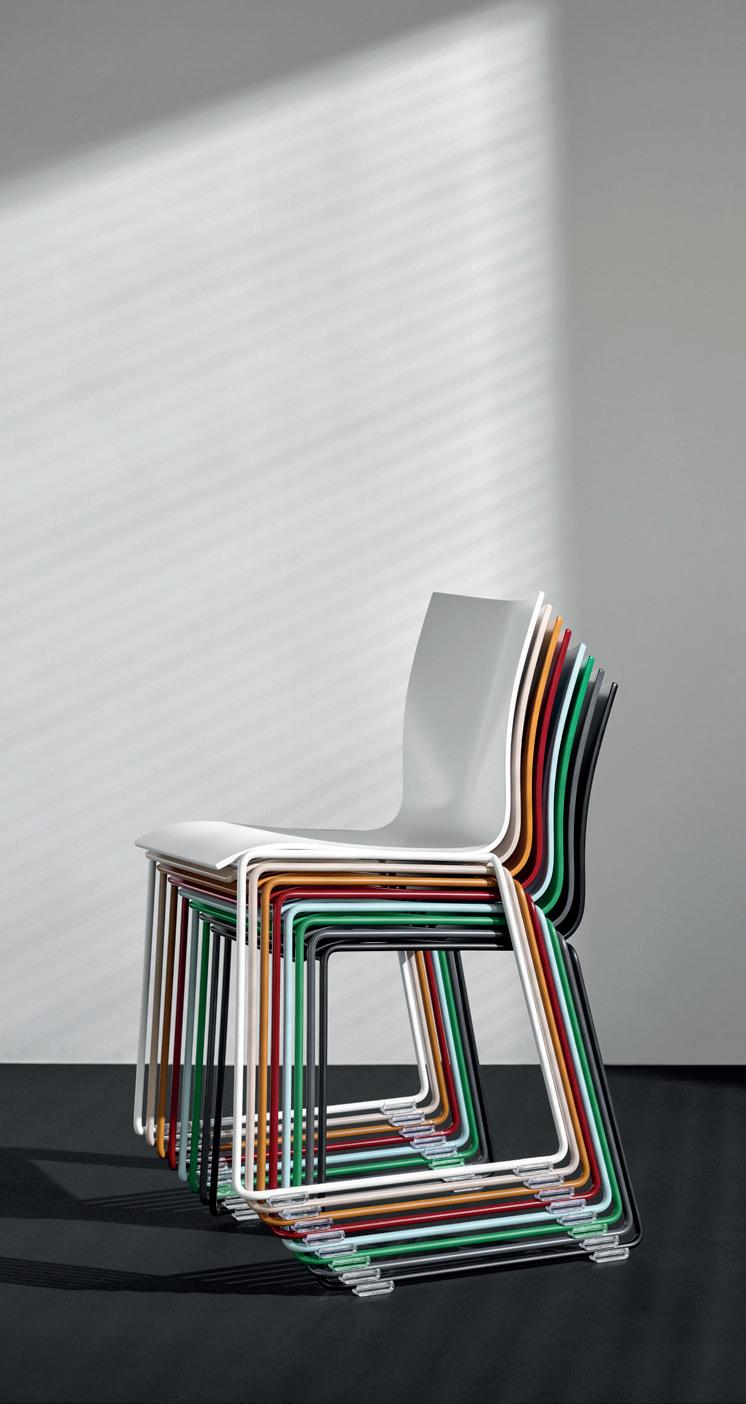
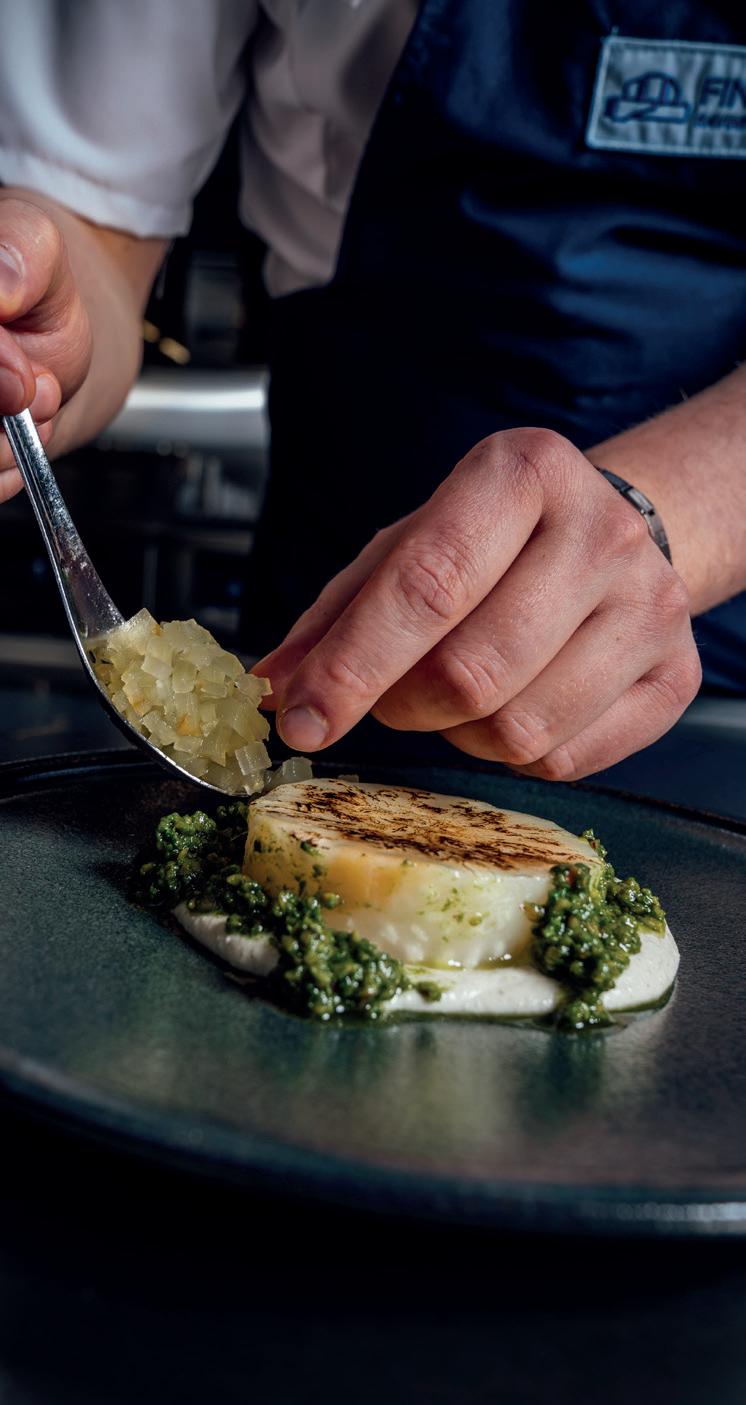
38 Top summer experiences in Sweden, 2025
In this special theme, we journey through Sweden’s vibrant summer offerings, from Stockholm’s breathtaking archipelago, recently named one of the world’s top destinations by National Geographic, to Gothenburg’s stunning botanical garden, one of the largest in Europe. Along the way, we explore the maritime wonders of Maritiman, the world’s largest floating museum, the contemporary exhibitions at Liljevalchs, and much more.
52 Visit Kristiansand
In this theme, we turn our focus to Kristiansand, a vibrant coastal city known for its rich cultural heritage and lively atmosphere. We explore a diverse selection of highlights like the chic Club 21 Rooftop Bar, offering sweeping city views, the historic Fullriggeren Sørlandet, one of the world's oldest full-rigged ships still in operation, and the upcoming Tall Ships Races 2025. On these pages and in Kristiansand, you will find something for all of the family.
90 The best new events and music in Scandinavia
Where to go? What to see? It’s all happening here in this month’s Culture Calendar of the best arts events in the Nordics. Our music columnist Karl Batterbee picks out the best new tunes in the region, our film and TV expert looks at the latest exciting developments in Scandinavian film and television, and Swedish illustrator Maria Smedstad questions if she has grown too soft for the North.
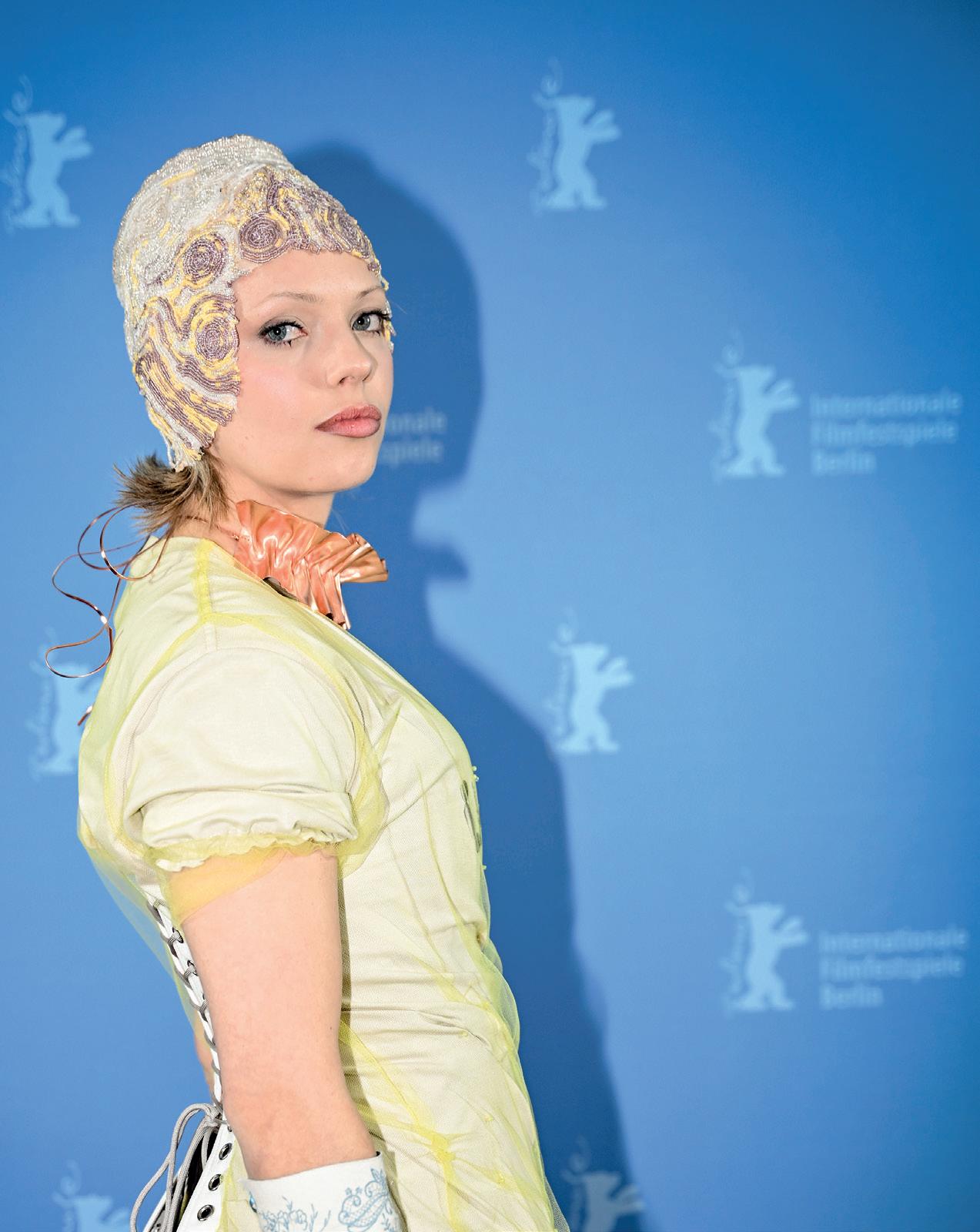
Norwegian actress and model Lea Myren makes a brilliant debut as Elvira in Den Stygge Stesøsteren (The Ugly Stepsister), a stomachchurning take on one of our childhood favourites. Watch out, though, this film is most certainly not for children.
By Celina Tran
Interpretations or remakes of fairy tales are hardly uncommon, and with the influx over the last few years, some might even argue that they are getting a bit old now. Den Stygge Stesøsteren by Norwegian writer and director Emilie Blichfeldt, however, is anything but. Its Sundance Film Festival debut not only drew in raving reviews, it also saw audiences vomiting and running for the exits. Not too bad for a first screening.
Told through the eyes of Elvira, Cinderella’s (Thea Sofie Loch Næss) ugly stepsister, the film takes us on the grotesque and vicious journey of a young girl who’s willing to do anything to win over Prince Charming (Isac Calmroth). Whoever fills the shoes of this Brothers Grimm fairy tale character must possess an unflinching brilliance – the kind that thrives in the realm of body horror. Enter Lea Mathilde Skar-Myren, nearly 24, lover of good music and yoga.
Oslo girl takes on the silver screen
With bleach blonde brows, two wide-set doll eyes and an easy-going coolness to her, Myren is not what we would expect of a wicked, ugly stepsister. In fact, talking to her feels a bit like chatting to one of your long-distance girlfriends over FaceTime. “Oh, that’s incredible, what do you write? And how’s Dublin?” she asks, diving right into friendly chatter.
Film is only one of her fortes. The first thing she tells about herself is that she loves art, everything from painting and sculpting to acting, and not only on the screen. In 2020, she graduated from her drama studies at Hartvig Nissen Videregående Skole in Oslo, then later took her studies to Paris, where she tried her hand at physical theatre. Her acting career, however, began long before she started drama school.
Before the bloody and ruthless metamorphosis of Cinderella’s ugly stepsister,
Myren first emerged on the TV screen in NRK’s children show Superia. But she is, perhaps, best known for playing Maya, the lead in Jenter, the show that set off her career. Since, she has appeared in sitcoms and coming-of-age shows like Blank, Side om Side, Kids in Crime, and more.
“I started my acting career quite young with Jenter, a show that changed my life. It opened so many doors and gave me great opportunities. It did, however, also mean that I entered the spotlight quite early on, which I found challenging and a little embarrassing in my early teens, though I suppose teenagers find everything embarrassing,” she chuckles.
Not wanting to be branded as Maya forever, Myren took a short break from acting for a few years before returning to the industry in High School. “Acting is definitely my biggest passion, so it was natural to fall back into it,” she says. “I’ve also

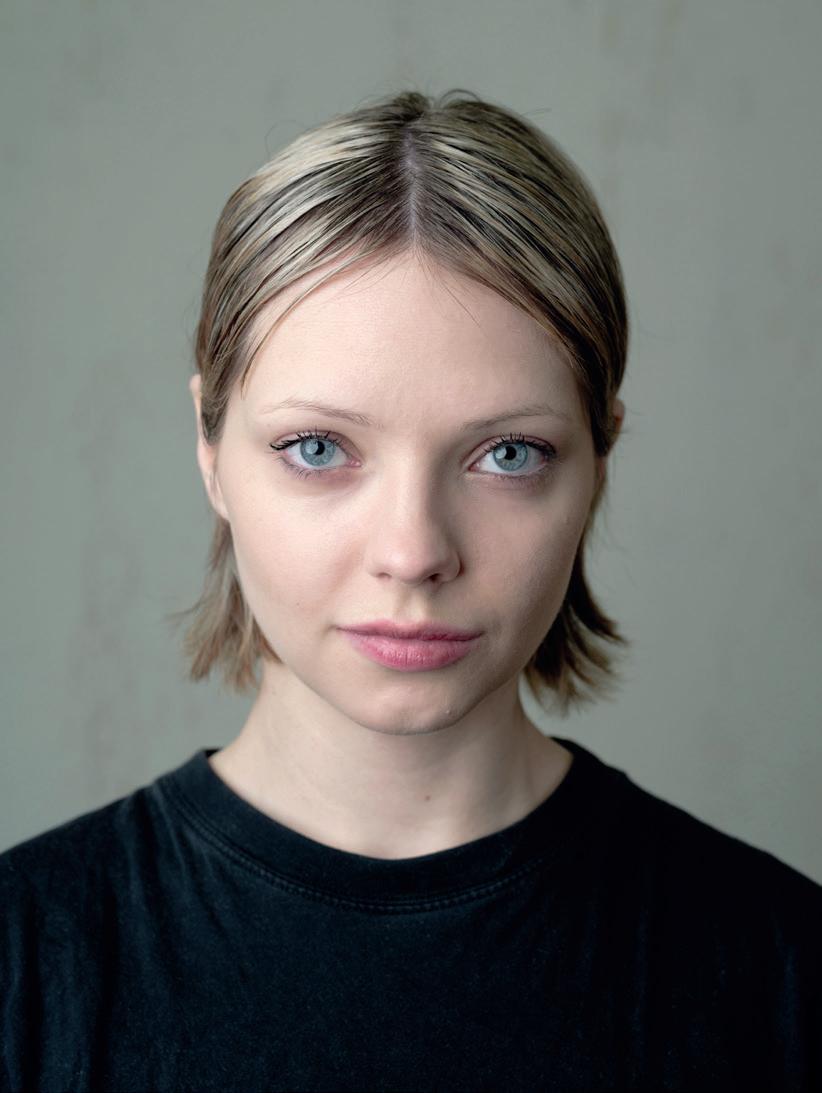
been very lucky to have been given the right roles at the right times, and then, of course, the role of Elvira came along.”
Most actors would consider Elvira a dream role due to the challenges along her journey, including the vast physical transformations and the emotionally evoking scenes. Myren is inclined to agree. “Elvira is everything and nothing; she takes things to extremes, allowing me to scream and get bloody. I love getting into the filth and dirt as an actress, so for my debut feature, this was a dream come true.”
In the fairy tale land of Den Stygge Stesøsteren, beauty is a bloody business. When an invitation to the ball is sent out and Elvira realises that this is her shot at winning the prince’s heart, she will do anything it takes. There is, however, a problem: Elvira is considered a bit of an ugly duckling. As well as setting out on a body-altering journey to becoming beautiful, she needs to ensure that her stunning stepsister Agnes (Cinderella) won’t get in her way.
Blichfeldt’s movie grabs the opportunity to shed light on body image and beauty
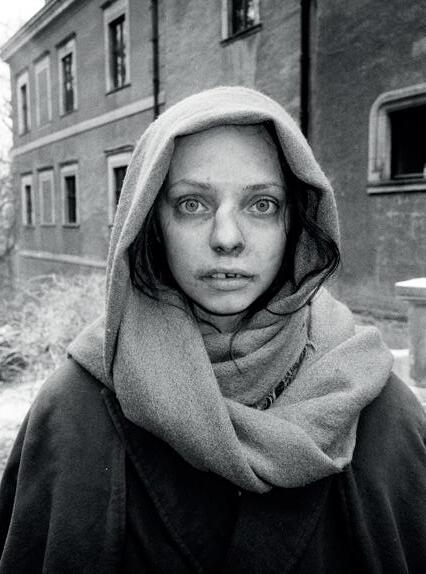
expectations, in a harrowing and humorous way. While Elvira’s character makes a mound out of a molehill, her struggles reflect very real problems of many young women.
“The stepsister, both in the original fairy tale and the Disney movies, has long been a symbol of all that is bad and wicked. In reality, though, she’s just another victim of a patriarchy,” says Myren. “Elvira is an innocent, insecure girl who only wants to be loved. That’s not to say she doesn’t do horrible things to get there, but it’s the process of trying to fit in that slowly but surely damages her.”
And the damage is not only psychological, but also physical. The movie plays on teeth-grinding body horror with dragged-out, grotesque images that will send your stomach turning. Not only does the stepsister undergo (historically accurate) medical procedures to attain beauty, but like in the original fairy tale, she also goes as far as chopping her toes off to fit into Cinderella’s slippers.
“It’s easy to laugh at the horror aspect because it only shows the extreme, but it’s also important to remember that this is truly how messed up our society is. People do cut themselves up, remove and put things into their bodies. We take pills, throw up, chop off fat, and so on –there are so many grotesque ways for
women in particular to become beautiful, all in order to fit in.”
The young actress criticises the role of both the entertainment industry and social media for setting and promoting these standards. In her view, young people are constantly exposed to videos about how to get thinner, botox and more, which pushes a narrative about an ideal body or face.
“Our bodies and minds are so delicate when we’re young, so I find the system we live in dangerous. In a world where large companies reign and the beauty industry has so much power, it’s easy to capitalise on people’s insecurities and to sell beauty as a payment for love,” she says. “I hope that Den Stygge Stesøsteren can inspire kinder conversations about body, weight and beauty ideals, especially for young people. We shouldn’t give up the power we hold over our own bodies.”
Beyond the message, Myren describes the feature as an incredible piece made by a team of strong women. And if the movie calls to you, but you’re skittish, don’t let the Sundance puke party scare you off. “The horror elements are built up over time in an almost Cronenberg-esque style, so you will see it coming and have plenty of time to close your eyes and ears. It is worth a watch though. Elvira is a character that can mean so much

to so many, and despite everything, she is actually lovable.”
With the success of Den Stygge Stesøsteren, Myren has just signed with a new management in the US, with her eyes wandering to other parts of the world too. While it is impossible to know what comes next, the future is undoubtedly exciting, perhaps horrifically so.
The Ugly Stepsister will be in US cinemas from 18 April and in UK cinemas from 25 April.
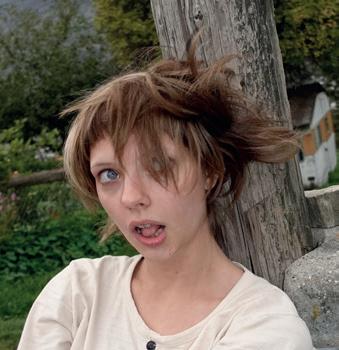
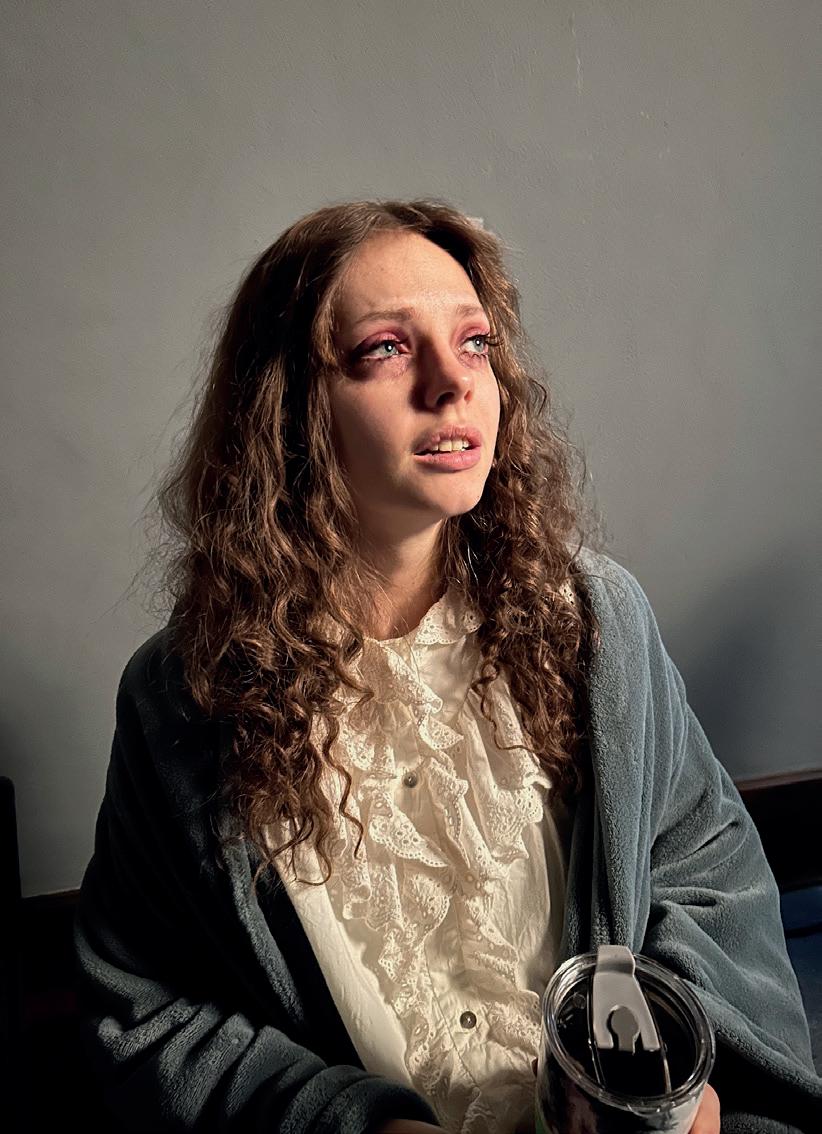
As May blossoms and the seasons shift, we finally get a taste of the sun. Now is the time to use light layers – cotton, cashmere, a flowy crepe, perhaps? And while the weather is bright and warm, make sure to show off those beautiful accessories too.
By Celina Tran | Press photos
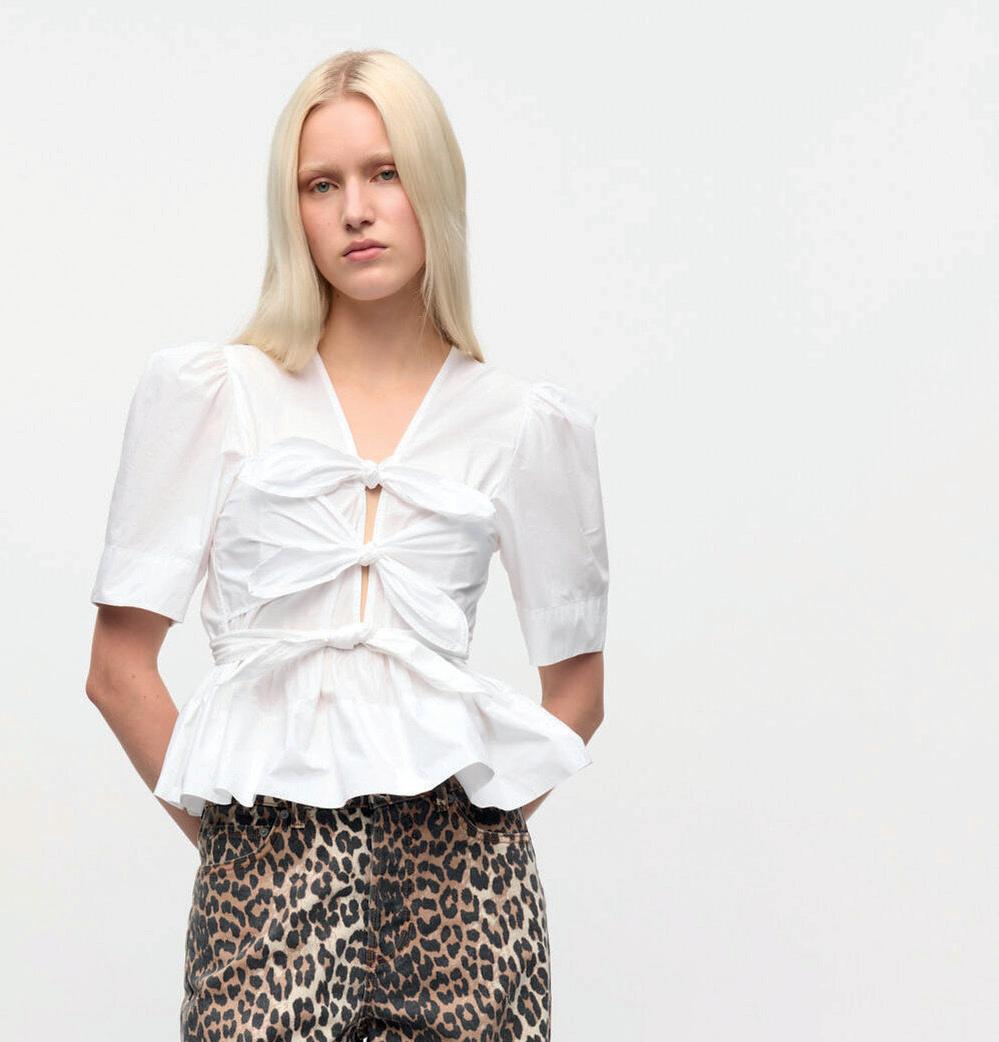
GANNI – Washed stretch cotton tie strap blouse in white
‘Tis the season for all things cotton! This beautiful cotton blouse from GANNI is not only light, but also unique with its V-neckline, puffed sleeves, and three tie bands at the front. Pair with linen trousers for a relaxed but elevated Mediterranean look, or perhaps a pair of jeans for something more casual. If wearing it to an event, throw on a maxi skirt with some fun patterns! It’s the perfect capsule wardrobe piece. Washed stretch cotton tie strap blouse in white, 225 EUR www.ganni.com
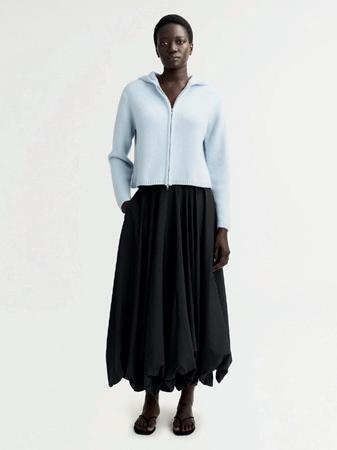
Soft Goat – Chunky hoodie in light blue
The wonderful thing about cashmere is its ability to keep you warm while breathing. This 100 per cent cashmere zip-up from Soft Goat works as a chunky top layer, and adds a pop of colour to an otherwise minimalistic Scandinavian palette. Like other Soft Goat pieces, it’s designed in Stockholm and made from high-quality OEKO-TEX® certified yarns, meaning that considerable ethical and environmental thought has been put into the sourcing of the yarn. Chunky hoodie in light blue, 520 EUR www.softgoat.com
ANNELE – Lavender Jelly earrings
Annele’s adorable earrings look like a cluster of grapes made of jelly, adding a bit of subtle whimsy to any minimalistic look. Made of 18k gold-plated 925 silver sterling and glass beads, the earrings come in a range of colours for those who like to collect. If you want a full set, Annele also has a jelly necklace that goes hand in hand with the earrings. Lavender Jelly earrings, 150 EUR www.annele.world
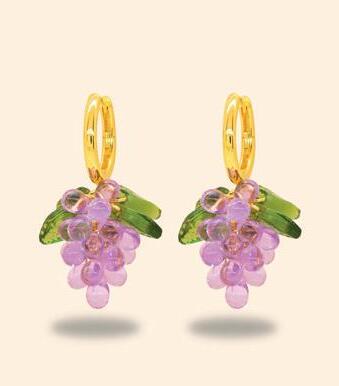
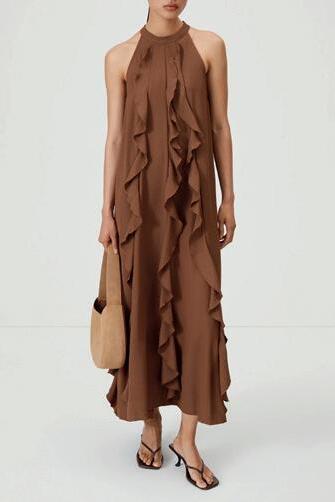
Stylein – Marcella dress in earth
Founded in 2001 by Swedish designer Elin Alemdar, Stylein works with Scandinavian minimalism and fine, high-quality fabrics. The Marcella dress is made from a brown matte crepe and features decorative frills that add a flowy elegance to the silhouette.
Marcella Dress in earth, 3,500 SEK www.stylein.com
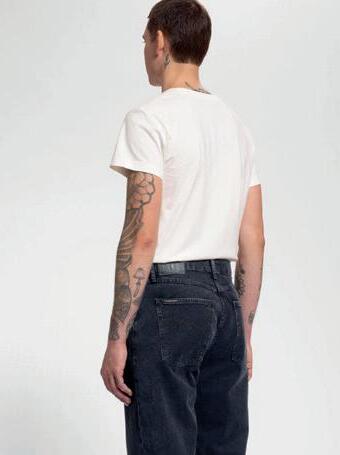
Nudie Jeans – Tuff Tony black vintage jeans
With tote bag and tee season, we should also remember to give those vintage jeans another round in the sun. Tuff Tonys from Nudie Jeans are a loose-fit pair of cold-cast jeans. With a black wash and marbled texture, they give a cool, vintage-like look. A solid pair can be worn with literally anything, but why not accessorize a monochromatic black outfit with some silver jewellery and sunglasses for an urban look?
Tuff Tony black vintage jeans, 160 EUR www.nudiejeans.com
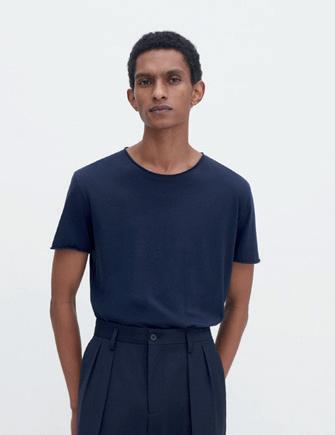

ARKET – Long sleeved t-shirt in white and blue
Another wardrobe staple, this striped long-sleeve shirt is made from 100 per cent Regenerative Organic Certified® (ROC) cotton, which is grown without chemical fertilizers and pesticides. ARKET’s crew-neck shirt has a relaxed fit and a classic look for any spring or summer day. Pair with an oversized leather jacket, sunglasses, and a pair of straightleg jeans.
Long sleeved t-shirt in white and blue, 49 EUR www.arket.com
With the warmer seasons here, there’s no safer choice than a classic T-shirt in organic cotton. Filippa K’s roll neck tee is available in a wide range of colours, but this navy one is a necessary stable in anyone’s wardrobe and can be worn year-round as an undershirt or as its own piece.
Roll neck tee in navy, 60 EUR www.filippa-k.com
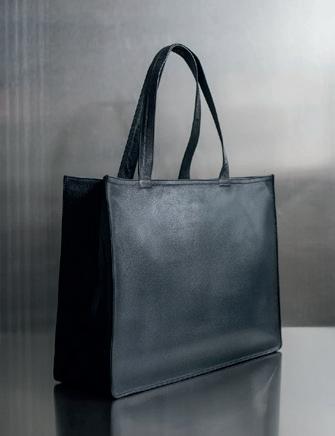
A Day’s March – Leather tote bag by Deadwood
The leather tote bag from A Day’s March is part of a collaboration with Stockholm-based Deadwood. It’s a simple, sturdy and refined bag that uses upcycled bovine leather and includes an inner pocket with a zip for small, valuable belongings. With a unisex and simplistic design, it’s an easy go-to for a range of occasions, like a casual city stroll or a work event.
Leather tote bag by Deadwood, 320 EUR www.adaysmarch.com
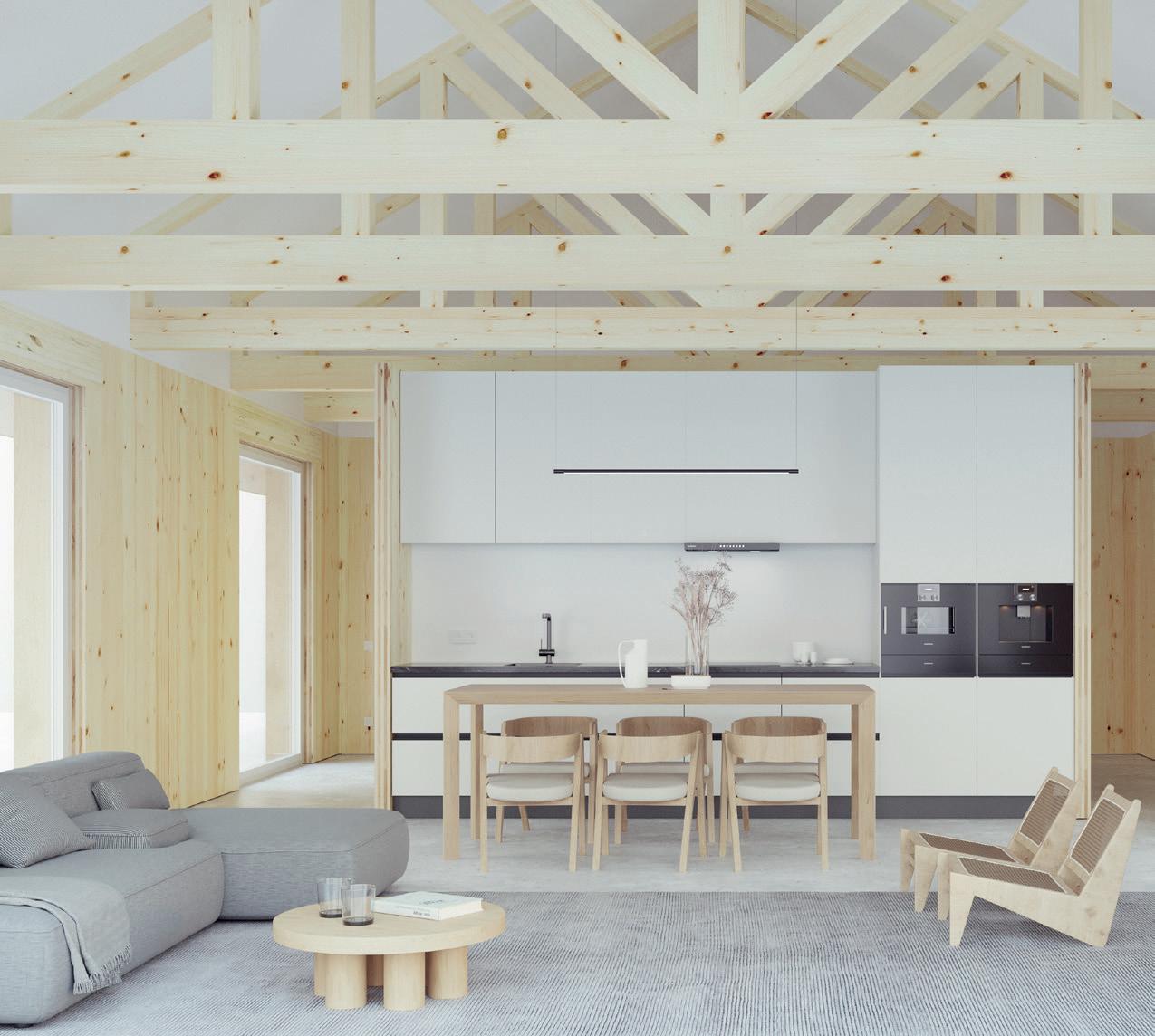
Click together a home that your grandkids will love you for
Whether you are a homeowner or an architect looking for a more sustainable, efficient, and accessible way to build, the Klik-Klik wall system may be the answer. Developed by the Danish/Latvian CLT Factory, this modular and directly reusable wall system offers a new patented solution to timber construction – one that responds not just to climate concerns but also makes building your own house more than just a dream.
By Signe Hansen | Photos: CLT Factory
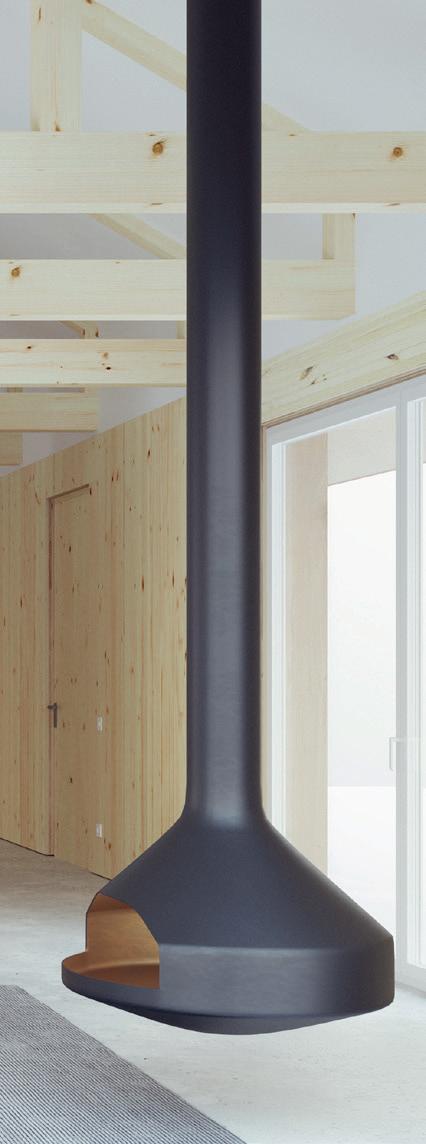
At its core, Klik-Klik is a prefabricated wall system made from cross-laminated timber (CLT) with patented joints that click together, eliminating the need for screws or nails and minimising waste. It is robust enough to meet static and load-bearing requirements and simple enough to be assembled by two people in a day or two.
“We have by far the world’s fastest way to build the basic structure of a house — the load-bearing part – while at the same time finishing the interior surface,” says Peter Frandsen, CLT Factory’s CEO of process & quality management, Scandinavia. “If you compare it to constructing with plaster walls, you would first have to cut and install the loadbearing piles, then the plasterboard is inserted – studs, frames, screwed in – then isolation is added and another plasterboard layer is added on the other side. Once it's done, you just call the painter to paint, trim and spackle. When we put up our elements, we install them right then and there – and when we do, the wall is finished, we don’t go back to it. There's nothing faster than this.”
More than that, the Klik-Kilk system is designed to be disassembled and reused, bringing circular economy principles into practice and cementing the sustainable merits of constructions made in responsibly sourced timber, a renewable and carbon-negative building material.
Launched in 2024, the Klik-Klik system is still young but has already gained recognition. For the last two years, it has received the Sustainable Building Awards from the British BUILD Magazine. Crucially, the system has also been granted
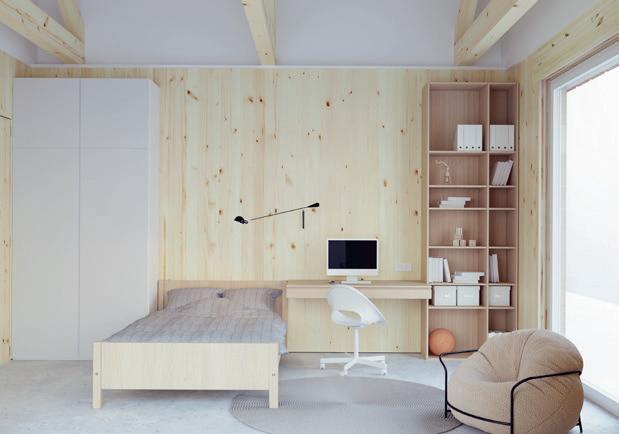
technical approval from ETA Denmark, verifying that it meets current national standards for use in construction. "KlikKlik is a developing company, but this is for real," says Frandsen. "The system is already out there, in use, and approved."
A solution rooted in practice
Frandsen, a trained carpenter, and his Latvian CLT Factory partner Eriks Meinarts developed the Klik-Klik system in collaboration with university scientists and engineers, as well as traditional cabinetmakers and Janis Straupe, a famous woodwork artist. "I was working with CLT for years, but it was always largescale – hotels, schools, office buildings," Frandsen explains. “I kept thinking: how do we bring this material into the hands of ordinary builders, carpenters, and homeowners?"
Inspired by Japanese Buddhist woodwork, the answer that emerged was to develop a system of standardised CLT panels that fit together like a puzzle. While this may sound simple, getting it just right was a long journey including numerous designs, redesigns, technical tests and patent applications. One of the key strengths of the final system is, however, its simplicity. "We wanted to make it like Lego," says Frandsen. "Something you can understand and work with right out of the box, assemble and disassemble. There’s no need for cranes or specialist tools, and the panels can be installed on-site."
Manufactured in Europe, the panels come in 16 variations, colour-coded and delivered with clear assembly instructions.

Built to minimise waste, last, and be reused
Klik-Klik is not just a system built for speed – it is built for longevity and flexibility. CLT has a natural lifespan of over 100 years, provided it is protected from moisture and direct sun exposure. But unlike traditional building materials, Klik-Klik is also designed for disassembly.
"If your needs change in 30 years, you can take it apart and use the panels again," Frandsen says. " You can turn a row of senior housing into a kindergarten or a set of family homes without discarding the materials. That’s the power of this system."
Another ecological strength of the system is its dedication to minimising waste. “This is about making something strong, yes, but also something that fits into an economy where nothing is wasted,” Frandsen adds. “That’s the future we’re working toward. Every offcut from production is
used – we even make our transport pallets from the excess top sills that come out of our panels, so when you’re using our
system and you come down to the pellets, you can disassemble the pellets and use them in your house production."
A team of two can assemble the load-bearing walls of a house in one day.

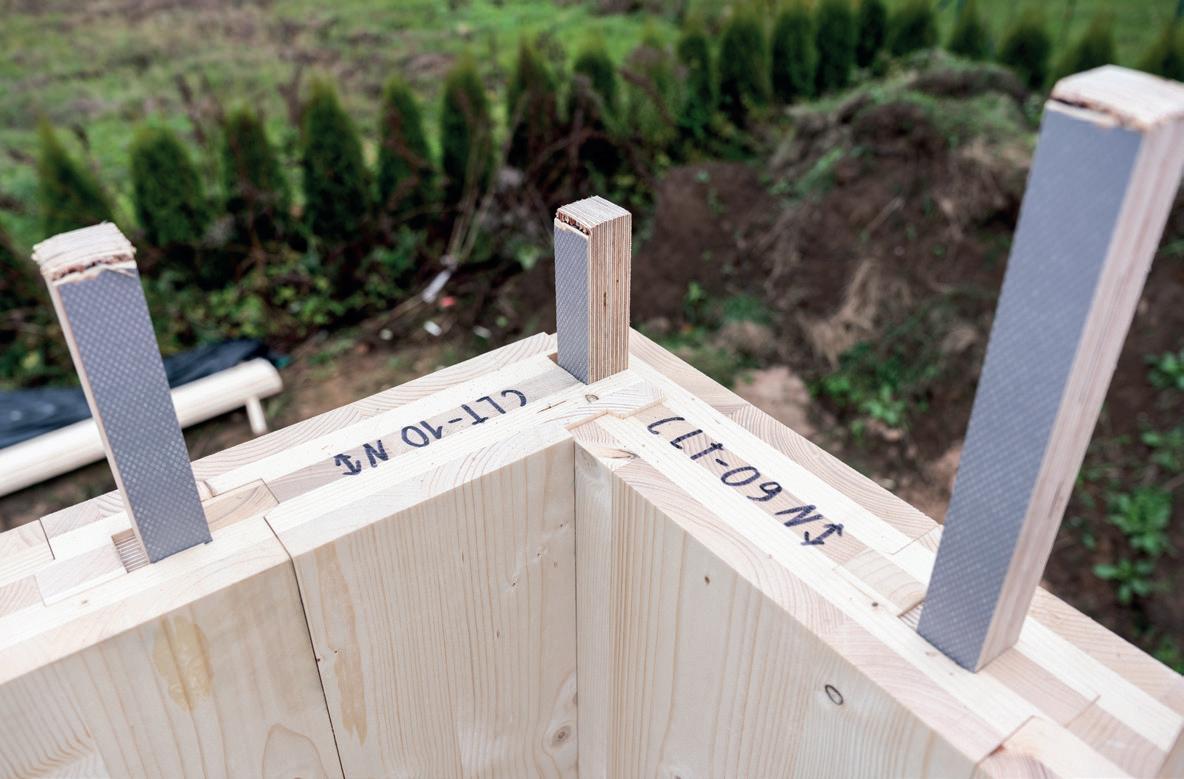
Klik-Klik may have been created and launched in Northern Europe, but one of the system's earliest customers came from further afield, from South Korea. "One of the first things that happened after we launched our homepage was that we received an email from South Korea. A developer asked, can you send this to me in South Korea? I said, sure – just send us your drawings."
After a quick exchange, two Klik Klik homes were produced and shipped across the globe. Today, they stand in South Korea as a quiet but powerful statement of the system's global potential. "It just shows the reach that this kind of thinking can have," Frandsen adds. "If you make something simple, useful, and sustainable, people will find you."
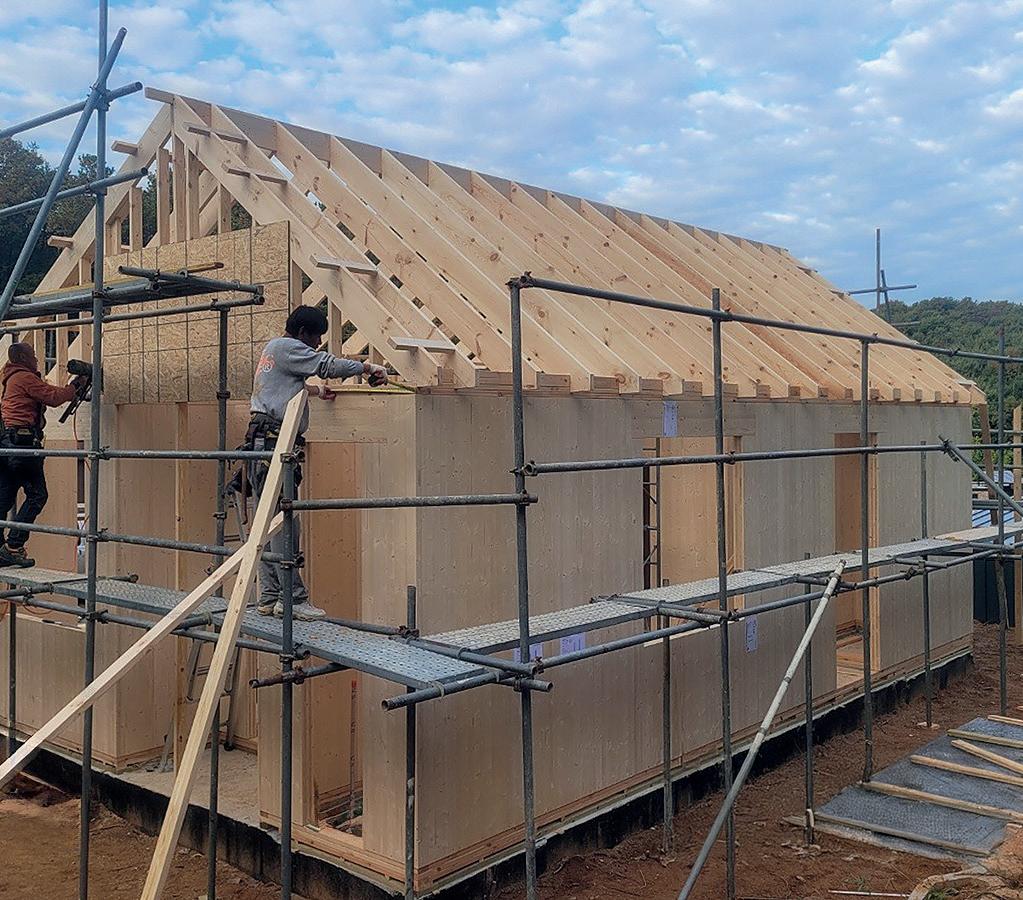
The Klik-Klik system at a glance
• Made from cross-laminated timber (CLT)
• Patented screw-free joint system
• Panels available in 16 standard types
• Designed for zero waste production
• Reusable and modular
• Compatible with electrical installations
• Suitable for residential and light commercial use
• Easy to design with the Klik-Klik wall systems online application
This idea of creating environmentally sound constructions is central to CLT Factory’s ethos. In fact, the company has started using a slogan in its marketing that captures this long view: "Your grandkids will love you." As Frandsen puts it; "Because you didn’t just build something for yourself. You built something they can use, too. It’s like Lego in that way, too; it will last for generations. And that’s how it should be – we should be able to use the things again and again and again. Otherwise, there will be nothing left for our grandchildren.”
Since its development, Klik-Klik has been used in residential and light commercial projects in northern Europe. A 200-square-metre home in Sweden was built over two days using the system, while in the Netherlands, a cluster of holiday homes now stands as a testament to CLT's versatility.
“The exceptional Klik-Klik walls system, featuring CLT panels, offers not only a rapid and efficient construction solution but also seamlessly blends visual aesthetics with sustainable practices, creating a harmonious combination... Our initial experience with the Klik-Klik elements has revealed its immense potential and inherent advantages.”
Frandsen, too, is keen to ensure that despite the patented engineering behind Klik-Klik, the intended users are not just architects or developers, but the builders and carpenters who construct everyday
homes. "We don’t design for Gaudi architects," he says with a grin. "We’re talking to the people who build homes for families. Architects who sit on trains with rolled-up drawings. People solving real problems."
To make planning and ordering as simple as building, CLT Factory offers a user-friendly 3D application that allows customers to design their projects digitally before committing. Whether you are an architect, builder, or homeowner, you can use the tool to draw your layout, select wall elements, and visualise the structure in real time. The online application provides a clear overview of the
materials needed and generates a corresponding price quote based on your design. “The idea is that you can sit at home with your partner, enjoy a glass of wine and sketch your summer house extension,” says Frandsen. “It should be that accessible.”
This accessibility ethos extends to pricing as well. While Frandsen is cautious about making sweeping claims on cost, he notes that savings can be significant when factoring in speed, waste reduction, and the elimination of separate finishing work. "We don’t want to get into debates about cost per square metre," he says. "But when people see the whole picture, the value is clear."
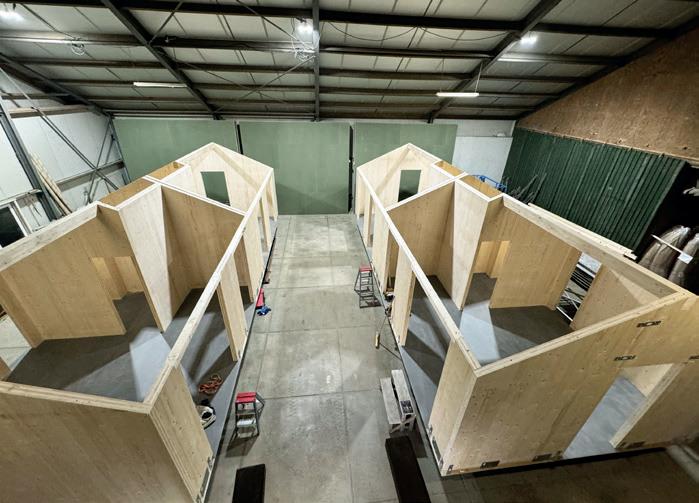

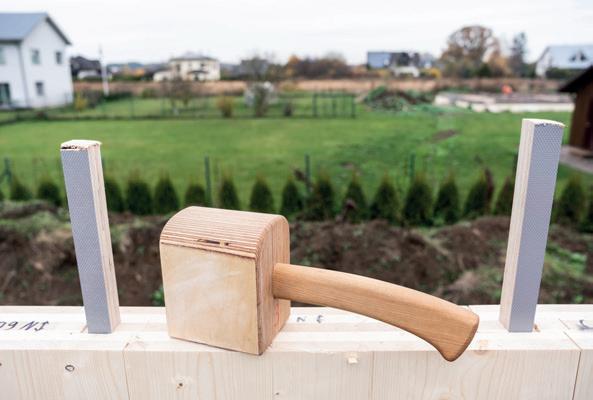
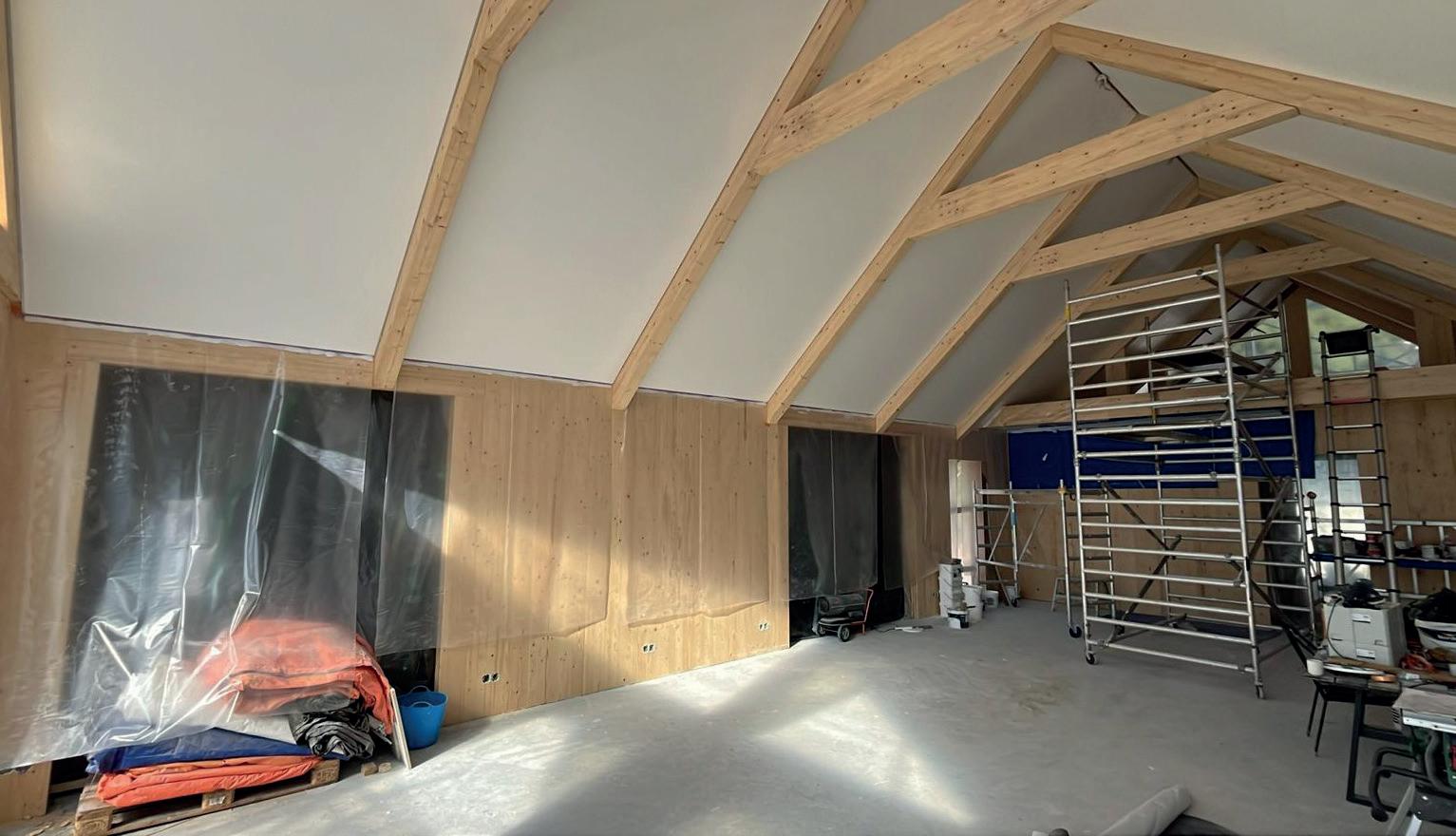
A building deposit system
Klik-Klik’s reusability places it firmly within a circular building model. The CLT is sourced from certified suppliers across Europe and cut using CNC technology to precise tolerances, ensuring minimal material loss.
Even electrical installations are designed with reuse in mind. The system’s Element #16 features a dedicated cable

channel that allows users to install and later retrieve wiring without damaging the structure. "It’s another layer of circular thinking," says Frandsen. "When you reuse the wall, you can reuse the wiring too."
Due to its durability and easy disassembly, Frandsen is also anticipating that the Kilk-Klik system will pave the way for a future where buildings will come with their own form of deposit system. Working in partnership with STARK, one of Europe’s leading building suppliers, CLT Factory is exploring a return system inspired by the Danish bottle deposit model.
“We’ll be the first timber wall system with a deposit return system,” Frandsen explains. “If someone comes to STARK in 30 years with a Klik-Klik element they bought today, the idea is that they could ask, how much will you pay me for this?”
Confident of the product’s worth, the CLT Factory continues to refine the KlikKlik system, with plans to expand the range of panel types and further devel-
op the app that lets users visualise their designs in 3D.
"We’re not trying to reinvent architecture," Frandsen concludes. "We're just making it easier to build something solid, beautiful, and lasting. And if your grandkids thank you one day, well, that’s a bonus."
www.klikklikwalls.com
• CLT Factory is a group of companies located in Denmark and Latvia
• CLT Factory builds houses, apartments, social buildings, and all kinds of constructions in accordance with local regulations and standards.
• The management of CLT Factory has been involved in timber construction for more than 40 years.
• The company also has a sales representative in Germany and the Netherlands.
• The Klik-Klik wall system is exclusively distributed through STARK in Denmark or directly from the website.
As nature is in full bloom, we’ve selected six stylish and highly functional plant holders to help you bring the warmth and energy of summer inside, in the form of a winning mixture of greenery and Scandi design. In truth, some of these pots are so beautiful, the plant will serve mainly as an excuse to include them on your shopping list. Inspired by the rising temperatures, many of our favourites combine classic Scandinavian minimalism with a touch of Southern tactility and colour.
By Signe Hansen | Press photos
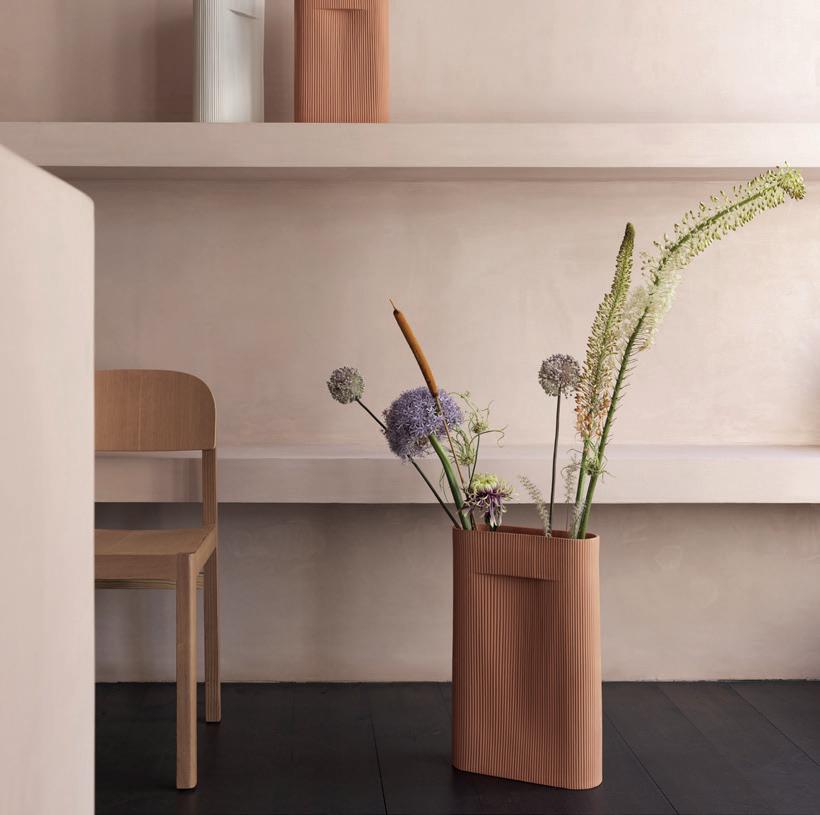
Ridge vase and planter, Kaksikko
The stunning Ridge vase and planter designed by Kaksikko, a Helsinki-based design studio, is the perfect example of a plant holder that not only serves to bring a bit of summer inside but also doubles as a sculptural element on its own. Available from Muuto in glass, terracotta and off-white earthenware, the Ridge family combines an artistic aesthetic with typical Scandinavian functionality – its characteristic dent doubles to create a striking exterior, allowing flowers to stand upright and serving as a subtle handle for easy movement between rooms. We’re in love with the large (H 48.5 cm) terracotta vase version, which, like the stone plant box, gives a subtle nod to the warmer parts of Europe. As a matter of fact, the vase is inspired by the doorways of Paris. The Ridge planter also comes in a striking moss green. From 489 DKK www.muuto.com
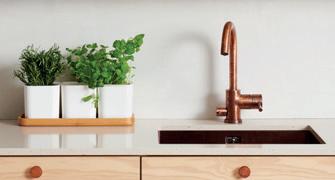
Eden self-watering herb pot set, Orthex
Inherently Scandinavian, the Eden self-watering herb pots are minimalistic, highly functional and sustainable. Created in bioplastic made of sugarcane, you get all the benefits of conventional plastic combined with a fully renewable raw material. The pot set is from Orthex, a Nordic producer of household products – including an extensive line of plant care items such as flowerpots and watering cans. Notedly, though Orthex Group, today, has customers in 40 countries and on four continents, the company still produces its products in its original locations in Gnosjö and Tingsryd in Sweden and Lohja in Finland. For plant novices, the Eden self-watering range provides an affordable and almost fail-proof start to your green venture.
From 299 SEK www.orthexgroup.com
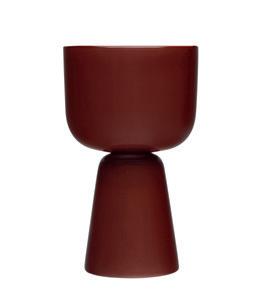
Nappula plant pot, Matti Klenell
The Finnish design giant Iittala is renowned for its inherently Scandinavian designs, many of which are so characteristic, they seem to have developed a universally recognised personality. The Nappula plant pot is another example of this. Creating it, designer Matti Klenell took inspiration from a peculiarly shaped table with ‘swollen’ feet at the Iittala Glass Museum, and the pot adds a touch of playfulness to the classic Scandinavian minimalism. Available in several versions. From 55 GBP www.Iittala.com
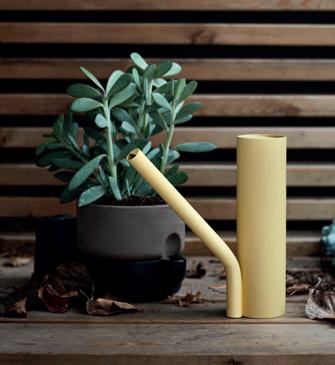
Grab watering can, Stine Aas
If plants could choose their own accessories, surely they would wrap their branches around the Grab watering can designed by Bergen-based designer Stine Aas. Stylish, yet oddly endearing, and highly functional, Grab will fit right into any chic space, whether an urban garden, a balcony or a hallway table. The can is produced by the Norwegian design studio NOTHERN, and available in dark green, light yellow and deep plum. Thanks to its sleek, handheld shape, the can is simple to handle, quick to fill, and, we find, easy to love.
1.290 NOK www.northern.no
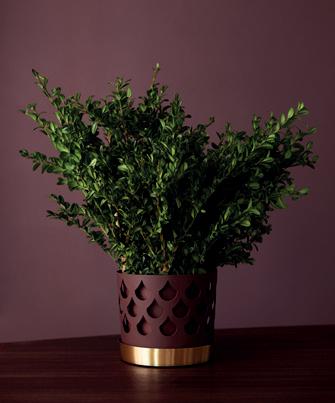
Trio square dark red flower pot, Ania Pauser
Maybe the rise in temperatures is leading our gaze towards plant holders that ooze of Southern Europe, or Scandinavian minimalists have taken a liking to the combination of pure lines with warm colours and rich tactile materials. Either way, the Trio square dark red flower pot is another example of how well this combination works, especially when paired with a living green plant. Designed for KLONG by Swedish Ania Pauser, the pot plays with patterns and colours to create depth and shadow in a way that immediately captures the eye. It’s available in three sizes, two patterns, and several colours. The inner and outer pots are made of stainless steel, and the tray is made of brass.
From 56.50 EUR www.klong.com
Stone plant box with shelf, Trine Andersen
Mixing a generous splash of Southern Europe’s tactile luxury with Scandinavian minimalism, the newly released Ferm Living stone plant box with shelf offers a luxurious update to the classic plant box in metal. Made from premium French stone, it’s an elegant piece that can be used both indoors and outdoors, offering endless possibilities not just for plants, but also books, or decorative objects. Originally designed by Trine Andersen, the founder of Copenhagen-based Ferm Living, the plant box series has become a favourite for those who love to combine greenery and design.
5.899 DKK
www.fermliving.dk
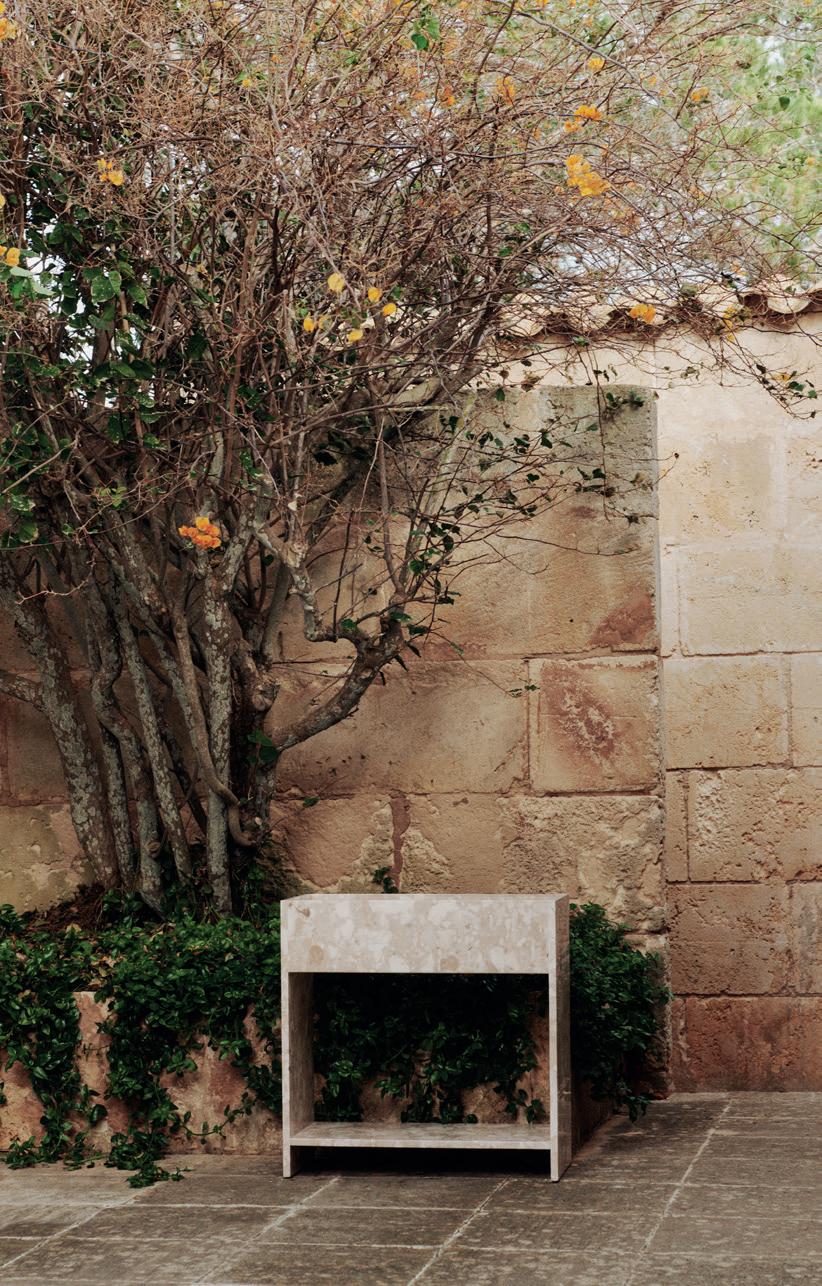

Just in time for summer, premium lifestyle brand Ron Dorff has released its new limited edition beachwear collection WANTED in collaboration with American photographer and style guru Douglas Friedman.
By Malin Norman | Photos:
Douglas Friedman for Ron Dorff
Founded in 2010, lifestyle brand Ron Dorff fuses Swedish design and functionality with French elegance. Its award-winning collections offer a stylish upgrade to iconic menswear from the past – perfect to wear at the gym, at home or at work.
“Combining functionality with style, Ron Dorff elevates menswear staples across sportswear, loungewear, underwear and swimwear,” says Claus Lindorff, founder and artistic director. “The result is a range of premium, desirable pieces with an athletic heritage that perform flawlessly.”
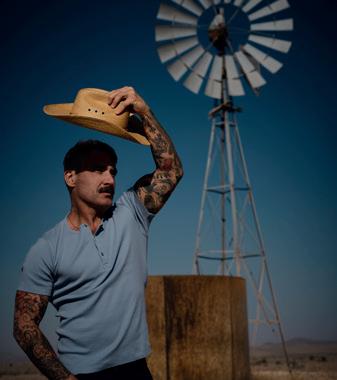
Named one of the best swimwear brands in the world for men by Vogue and one of the best underwear brands for men by GQ, Ron Dorff also counts celebrities from the world of sport and film as fans, including Tom Daley, Orlando Bloom and Neil Patrick Harris.
WANTED, in collaboration with Douglas Friedman
Ron Dorff’s new limited edition beachwear collection WANTED was designed in collaboration with acclaimed American photographer and style guru Douglas Friedman, who is best known for his sleek interior and lifestyle photography.
The collaboration originated in Friedman’s love for Ron Dorff and its functional, minimalist approach to sportswear. The 30-piece collection features swim-
wear staples such as swim shorts, swim briefs and swim trunks, but also t-shirts, bandanas, socks, and sweatshirts for that full beach silhouette. The pieces are designed in classic Far West checks and stripes with some clever prints that carry multiple interpretations, such as WANTED and COW BOY.
Friedman was inspired by his ranch retreat in Marfa, Texas – an unforgiving and beautiful landscape. “I love the idea of a swimwear collection taking inspiration from a place that has never seen a pool, let alone the sea. It’s daring and a fullon Friedman signature,” says Lindorff. “It’s been a fantastic collaboration, with Douglas starring in front of as well as behind the camera.”
New exclusive travel collaboration in the pipeline
Inspired by chic men’s sportswear of the 70s and 80s, Ron Dorff uses no logos on the garments. Instead, all pieces are discretely signed by a pair of black-lacquered eyelets, a reflection of the two O’s in the brand’s name. True to Scandinavian minimalism, where everything serves a purpose.
“Our philosophy leads us in every step of our work, from designing to manufacturing each piece. Essential designs with impeccable fit. Perfect garments with an athletic heritage that perform flawlessly
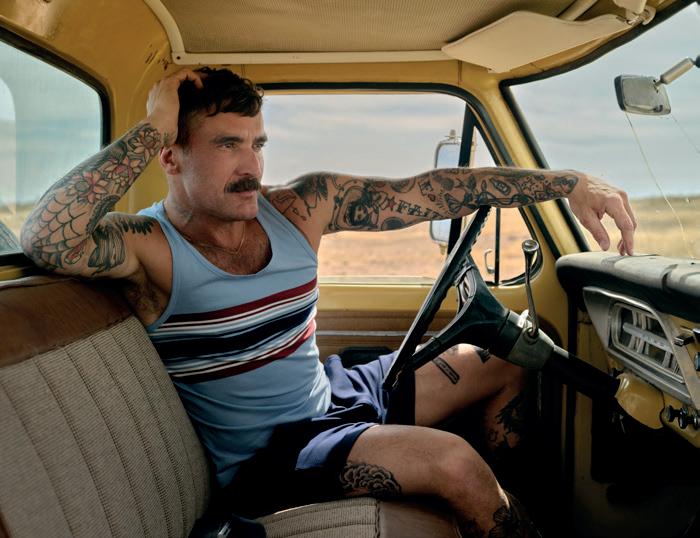
in any occasion,” adds Lindorff. “We give the utmost attention to every detail and always with an uncompromising eye for fabrics and construction.”
Another high-profile collaboration is in the pipeline, this time with a French luxury luggage brand, due to launch early next year, including light-weight luggage, travel accessories and a capsule collection of luxurious travel wear. “We all hate those complementary one-sized polyester pyjamas handed out on longhaul flights and I thought we should of-

fer our globetrotting clientèle something that you’re only feeling comfortable in but also look great in when walking up and down that aisle,” Smiles Lindorff.
www.rondorff.com
Facebook: rondorffofficial Instagram: @rondorff

WANTED collection is available as of the end of April, exclusively in
stores in Paris, London, New York and Los Angeles, in pop-up stores in Dallas and Mykonos, and on rondorff.com
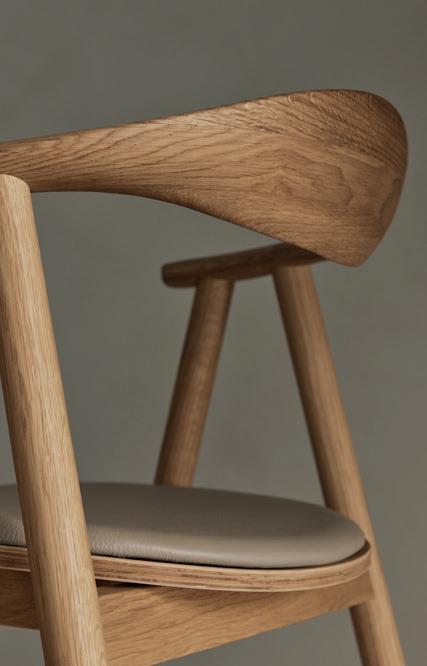
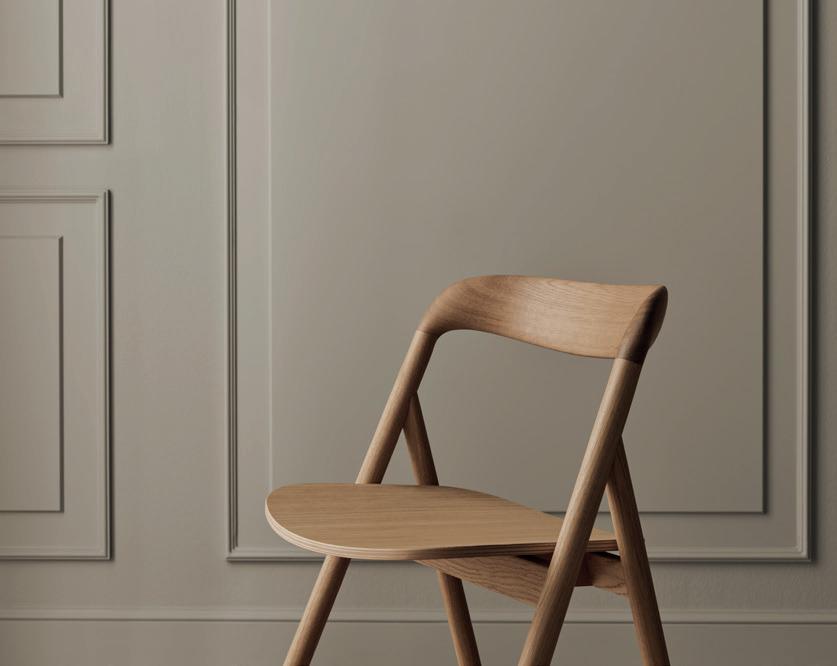
Danish designer Henrik Sørig Thomsen has spent nearly three decades shaping products that marry innovation with classic minimalism. With a background in industrial design, he has moved from industry-defining electronics to universal furniture designs, creating pieces that are tactile, sustainable, and quietly expressive – inviting empathy, not just admiration.
By Signe Hansen | Photos: Sørig Design
“There’s a kind of sympathy that a piece of furniture should evoke. If you don’t feel anything for it, you shouldn’t live with it,” says Henrik Sørig Thomsen, founder of Sørig Design Studio. Along with his focus on functionality and innovation, it is this belief that forms the backbone of his work. From the sculptural, minimalistic elegance of his popular Swing chair to the nature-inspired, understated look of the new Fenri chair, Sørig’s furniture transcends function.
With clients including the major Danish design furniture chain Bolia, as well as the British Joined + Jointed and the Italian seating specialist Softline, Sørig’s tactile and intuitive approach has a proven human appeal across borders.
Sørig’s path into the design world began when he graduated as an industrial designer from the Danish School of Design in Copenhagen in 1995. “There were some scouts from Bang & Olufsen there,

and after I finished, they called and asked if I could design something. I said yes of course, and it just took off from there.”
His early collaboration with Bang & Olufsen would lead to numerous highly successful electronical designs. One of the personal highlights was designing the BeoCom 6000 telephone, a design innovation born from a simple idea conceived on fishing trip. “At the time, everyone was frustrated by the technical challenge of menu navigation with limited buttons,” Sørig explains. “But one day, while I was out fishing, I just had it. The tactile feel of a fishing reel gave me the idea for a wheel-based interface, with the tactile feel and clicking sound of the fishing reel. It went on the phone, and it was a huge success.” He jokingly adds; “We reinvented the wheel.”
The phone was later mentioned in a feature in the business magazine Fast Company. In the feature, an Apple insider states that when trying to find the right interface for the soon-to-be-launched
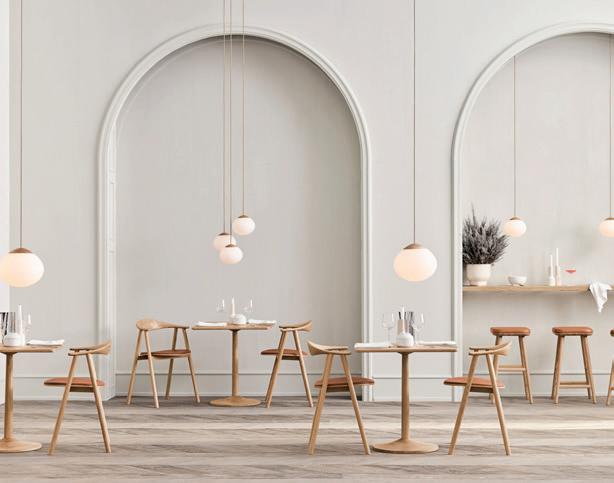
iPod, Apple marketing SVP Phil Schiller, who had seen the wheel on the BeoCom 6000, stated; “Well, we should do that.”
“I’m pretty proud of that,” says Sørig. “This is what it’s all about, doing something new, taking a leap forward.”
When Sørig first decided to shift his focus from electronics to furniture design, he struggled to get his foot inside the right door. But with the increasing focus on sustainability, his inherently material conscious designs soon gained the interest of Bolia, a forerunner in the documentation of sustainable features in furniture. “When the design world started focusing on sustainability, that’s when I hit my stride,” says Sørig. “I’ve always preferred natural materials –wool, wood, glass – and I like the idea that things can be repaired, not just replaced.”
This ability to blend innovation with tactile familiarity and sustainability remains central to Sørig’s approach. In his furniture, this means taking the body into account – not just in terms of ergonomics, but empathy. “I look at the body, sense what feels good, and try to make things simple and functional, even down to how easy they are to clean,” he explains. “But it should never feel like a machine.
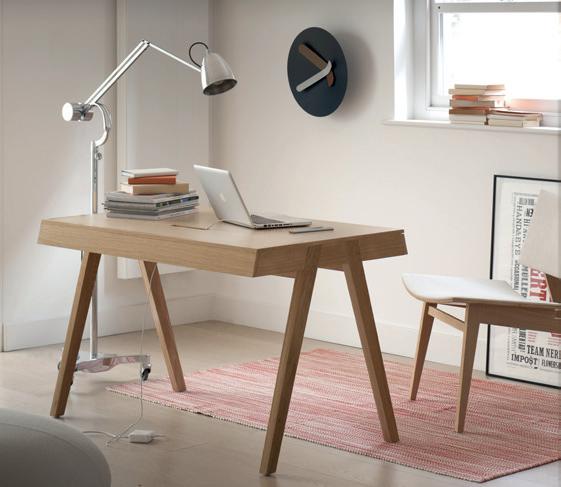
It needs to be something you want to be around, in your living room, every day.”
This philosophy comes to life in pieces like Karm. Designed for the Italian brand Softline, it is a minimalistic chair with precise joins and softened edges. It is also visible in Swing, a chair that pays homage to the Danish master Hans J. Wegner, but with a new empathic interpretation. “We managed to use a new laminated joinery combined with new technology, aiming for top quality and at the same time obtaining a fair price level,” says Sørig.
On top of its pure minimalistic aesthetic, the innovative design also provides the chair with an inherently sustainable profile, documented by Bolia’s low CO2 certification.
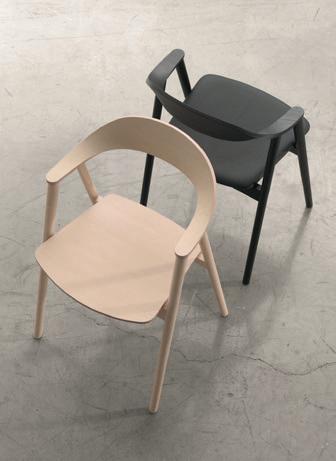
Sørig’s Home Station desk further showcases his ability to combine classical designs with innovation. Inspired by vintage English school desks, the desk updates the format for modern living with clean cable solutions and a compact footprint tailored to the home office. The table and the chair Wood III are now produced and sold by Joined + Jointed, a UK-based company.
Through every new idea and collaboration, Sørig always returns to one core principle: music. “At design school, a teacher – musician Peter Bastian – came in and told us to forget everything we’d learned. Then he played the saxophone. We didn’t understand it then, but that lesson stuck with me. There has to be music in the design. If not, what’s the point?”
www.soerig-design.dk




Eliminating microplastics, imitating the natural feeding processes, and promoting intimacy, the innovative baby bottle from Danish design studio Caramma is redefining the experience of bottle feeding.
By Signe Hansen
Inspired by close observation and personal experience, the award-winning Caramma support bottle is designed to bridge the gap between breastfeeding and bottle feeding.
"It’s the first bottle in the world designed for use in all-natural breastfeeding positions – you can use it in bed with your baby on your belly, promoting connection and the release of oxytocin," explains designer Rie Maktabi, co-founder of Caramma. "Moreover, our bottle features a slow, natural flow and a patented vent system that mimics the mammary glands, allowing the baby to set the pace and experience the natural feeling of fullness."
With an innovative air-free anti-colic system, the bottle also supports a happy stomach and is crafted to be free from microplastics, ensuring safety and health for your baby both in the short and long term.
The idea for Caramma first emerged when Maktabi and her co-founder, Monika Havnø, worked with midwives and
families to define the requirements for birth rooms. When Maktabi, soon to become a mother herself, realised that although nearly all mothers hoped to breastfeed, only 10 per cent continued beyond six months, she set out to find the best available baby bottle. Their discovery puzzled them – no existing bottle
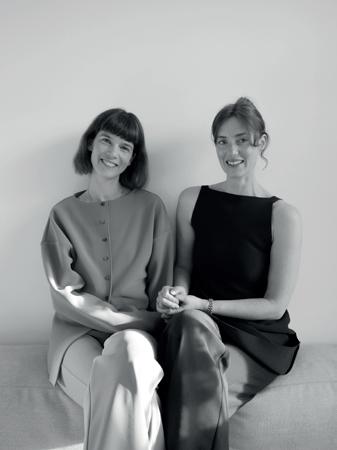
came even close to replicating the mechanics of natural breastfeeding. “No bottle on the market resembled a breast at all,” Maktabi recalls.
Spurred on by this realisation, Maktabi and Havnø undertook an extensive co-design process that lasted nearly two years and included two technical patents. The result is a bottle which, with its unique soft shape, mimics the breast's feel to seamlessly integrate into a breastfeeding routine, allowing parents to switch between breast and bottle feeding with minimal confusion for the baby.
Sustainability was also a key focus for the two designers. The bottle is made from food-safe silicone, free from harmful microplastics. The impact of Caramma has already been recognised, as the product recently won a prestigious Danish Design Award in 2024. The award highlights the industry's acknowledgement of the need for innovation in parental care and it just so happens that the two designers have more innovations underway. "We just have one rule,” says Maktabi. “It has to be innovative; otherwise, the world doesn’t need another baby product.”
www.caramma.com
Instagram: @caramma__official


In the world of Scandinavian minimalism, Nanna Wistoft stands out as a colourful rebel. Based in Copenhagen, Wistoft has gained recognition for her bold blend of elegance, vibrant colours, and unique designs, all without formal training. For those who crave originality and authenticity, her interior design studio, Nanna Wistoft Design, makes dream homes a reality.
By Signe Hansen
Before entering the design world, Wistoft spent over a decade as a lawyer specialising in intellectual property rights. However, her interest in design dates back to her 20s when she worked as a fashion stylist in New York. When she decided to pursue her dream of creating her own home, she was determined to take on the challenge herself. “I did everything myself, design wise,” she explains, recalling her decision to forgo hiring an architect and instead managing the design process herself, with only a building constructor’s assistance in the technical aspects.
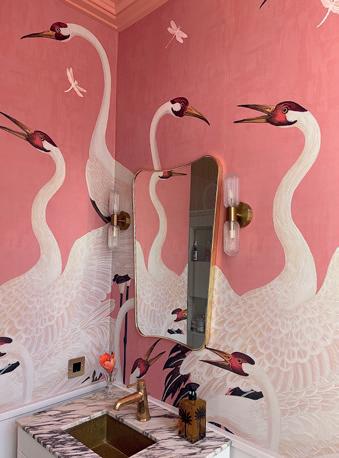
Wistoft’s work garnered attention through her Instagram account. Family and friends were impressed as was the Danish design magazine Bo Bedre, which published a 12-page spread on her house. This exposure resulted in requests from couples hoping for Wistoft’s help in creating their own dream homes.
In the five years since launching her design business, Wistoft has worked on numerous projects in and around Copenhagen. Unlike many designers who come in at later stages or focus solely on styling, Wistoft takes a comprehensive approach, and prefers to get involved from the very beginning of each project. She emphasises a cohesive vision, prioritising consistent colour palettes, custom-made furniture, and carefully chosen accessories.
“What sets me apart is my holistic view,” she says. “I can be involved in everything – from layout and room division to materials, colours, and atmosphere.” Wistoft meticulously plans every aspect of a project, from kitchens and wallpapers to lighting and doorknobs. Her designs combine classic elegance with ‘wow’ elements that create surprise and conversation, such as individually sourced vintage Italian lamps and chandeliers.
Although Wistoft brings numerous ideas to the table, her process always begins by understanding her clients and their homes. “When I visit a house, I look at its architectural style. I respect its history and elements," she says. She avoids discarding defining features just to follow trends. “Trends inspire me, but I don't let myself be dictated by them. I ask: who is the client, and what do they love?”
To guide design choices, Wistoft creates mood boards and presentations tailored to each client. This collaborative process demands trust and understanding, and in the process, some former clients have become close friends. “It’s an intense collaboration,” she notes. “It doesn’t work if there is a lack of trust. Trust is essential.”
Client testimonials reveal that Wistoft not only realises their dreams but also helps

shape them. Many clients express astonishment at her bold suggestions, which they initially doubted but ultimately cherished as standout features in their homes. Her use of colour and luxurious textiles is a defining aspect of her work, and Wistoft is passionate about sourcing unique materials, often selecting richly veined marble from Italy for her designs. “I love items that tell a story. A home should feel alive and unique. It’s important to make it personal. Our homes should be sanctuaries, reflecting who we are,” she explains.
Wistoft recognises the role of a home in providing comfort and mental well-being. “The world outside can be stressful, and our homes are crucial to our mental health," she says. She believes in tai-
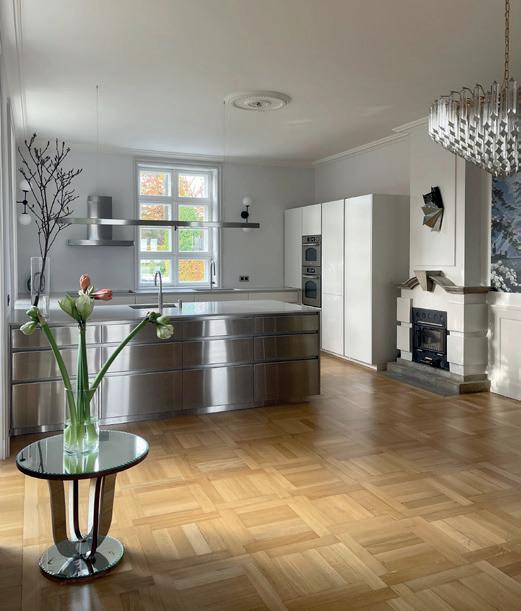
lored solutions for each client, as individual preferences vary widely. “I have never designed two kitchens that are alike,” she states.
Her attention to detail also extends to practical matters, such as the building and renovation process. "One of the things that is essential in this industry is to know who and where to call when you need something. We have worked hard to become well-connected in all matters related to artisans and the interior. As for the contractors, we have chosen to work with only the best and the most experienced. Those we trust in relation to everything from fair pricing, keeping deadlines, having the right approach and being very detail-oriented," Wistoft explains.
Indeed, Wistoft’s dedication to detail and quality is evident in every nook and corner of her projects. “Every house and every client is different. We always walk the extra mile to find the perfect solution for every project. We aim for happiness – we use design to create joy," she concludes.
While creating joy for her clients, Wistoft herself is looking for the next big challenge, one day, she says, she dreams of designing a hotel.
www.nannawistoft.com Instagram: @nanna_wistoft_design
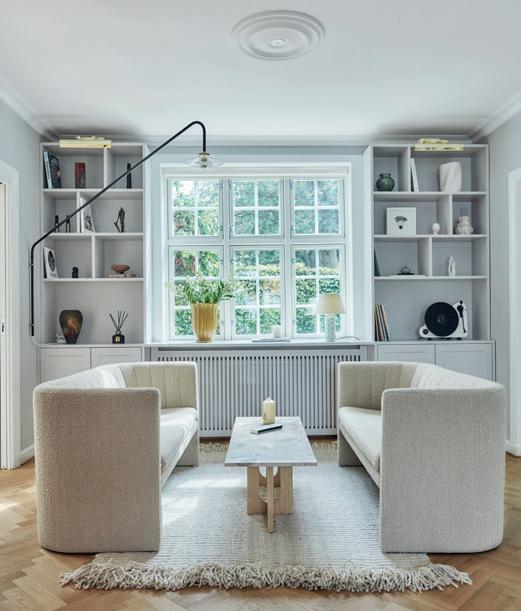
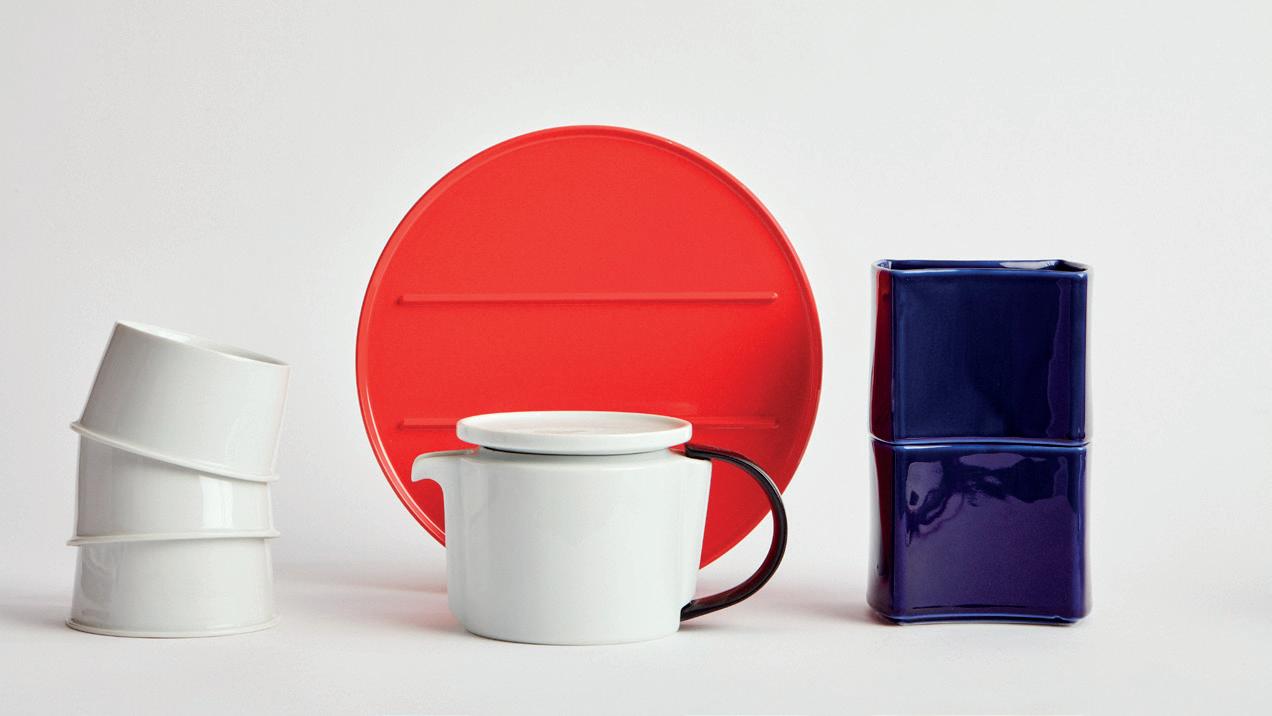
Known for his iconic Stelton EM77 thermos jug and a relatively quiet, user-focused approach to design, Erik Magnussen created everyday objects that are still admired – and used – decades later. With a deep respect for function, form, and the users, his work continues to shape how we think about design today.
By Heidi Kokborg
Erik Magnussen (1940-2014) never worked from a large studio. He did not have a team of assistants, nor did he aim to be in the spotlight. Instead, he worked largely solo; thinking, refining, and prototyping until the idea was resolved. “He wasn’t interested in fame. He preferred being at the factories, talking to the people who made his designs. That’s where he felt at home,” say Jonna and Magnus Magnussen, wife and son of Erik Magnussen.
Born into a creative family, Erik Magnussen was surrounded by both art and engineering. His grandfather was a respected art dealer, while his father was an engineer. It was a blend that would shape his career – technical rigour paired with artistic instinct.
Erik Magnussen did not believe in creating products just for the sake of creating products. “He always asked: can this be justified? There needed to be a reason to add something new to the world. If a product didn’t improve what already existed, he simply wouldn’t make it. A chair had to offer more than another chair. A cup needed to solve a real problem,” says Magnus Magnussen.
His iconic Stelton thermos jug is a perfect example. Designed in the 1970s, it opens and closes automatically and has been updated over the years to reflect technical innovations. Its clean, graphic shape is instantly recognisable. “That is one of Erik’s trademarks. He made
things look so obvious – as if it should be like that.”
Another standout is the HANK tableware series, created for use in public institutions like DSB (Danish State Railways). The mix of durable porcelain with plastic handles and colour-coded accessories not only communicated function but became a commercial success. Its graphic, modern feel appealed to public institutions and private users alike.
“He saw himself as an average consumer. He designed for people like himself, and believed that good design should be affordable, accessible, and able to last through generations,” explains Jonna Magnussen.
Ingenuity with a touch of artistry
Although Erik Magnussen was educated as a ceramist at the School of Applied Arts and Design, his creative path expanded rapidly. After his early work in ceramics, he worked with Torben Ørskov,
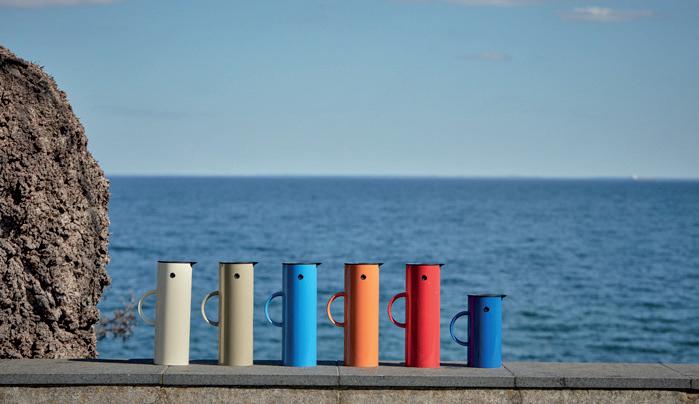
one of Denmark's most significant design merchants from the 1950s. This resulted in a series of furniture designs – including a chair held together without screws, where the fabric acted as a structural element. Later, he developed modular furniture systems in Malaysia that could be shipped flat-packed, assembled without tools, and transported efficiently.
“His ideas were often ahead of their time. He was a bit obsessed with solving problems – sometimes down to the shipping and storage. It wasn’t just about designing a beautiful chair. It was about designing a better chair, from start to finish.”
Many of Erik Magnussen’s designs were crafted through model-making rather than sketching and drawing. Ideas developed in his head before his hands got to work. He was known to build full prototypes himself – refining as he went, challenging every joint and connection.

“There were rarely unnecessary details. Aesthetics emerged from smart thinking. Nothing was just decorative,” says Jonna Magnussen.
A full-circle approach
Erik Magnussen’s design thinking was not limited to the product alone. He was involved in catalogues, graphics, exhibition stands, and packaging. He collaborated with skilled craftsmen and manufacturers, valuing their input as part of the creative process. “He didn’t want to just hand something off, but rather wanted to be a part of it from start to finish,” says Magnus Magnussen.
In that sense, his work somehow echoed the Gesamtkunstwerk tradition: not in its romanticism, but in its totality. Whether designing porcelain door signs that avoided glare in direct sunlight (a door sign that has just been relaunched) or a chair that could be assembled in six in-

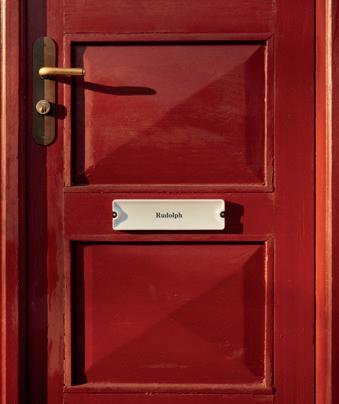
tuitive parts, his work was always intelligent, inventive, and user-driven.
Erik Magnussen also believed in tolerant design – objects that could fit naturally into many kinds of environments, across styles and incomes. “He did not see the point in designing for an elite. Design should be lived in. It should feel good to use, not just to look at,” add Jonna and Magnus Magnussen.
While some designers and artists chase trends, Erik Magnussen chased improvements. He was not interested in creating showrooms and galleries, but in making life better. Even today, many of his products are still in production and are used and appreciated daily by customers worldwide.
www.erikmagnussen.com
Facebook: Erik Magnussen Design Instagram: @erikmagnussendesign

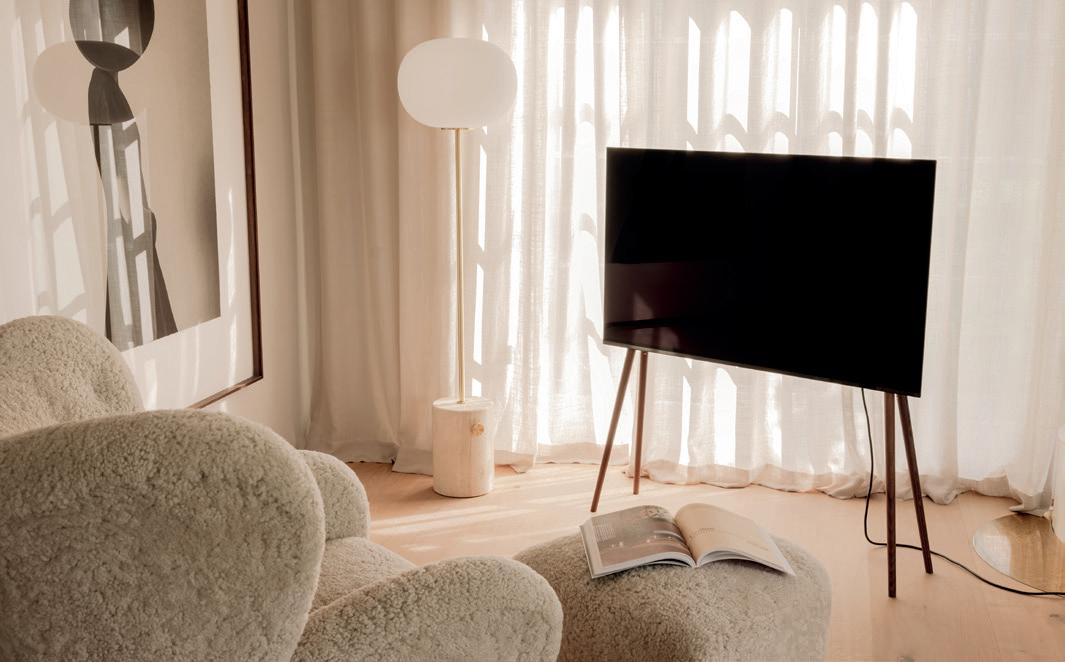
What began in a quiet corner of the Estonian countryside has grown into a globally recognised design brand rooted in simplicity, quality, and purpose. JALG was never just about TV stands – it was about creating something meaningful.
By Malin Norman | Photos: JALG
The story of JALG began in 2016, in a modest workshop where the scent of wood mingled with big ideas. Back then, pieces were made by hand alongside an almost 80-year-old artisan, who shaped each TV stand from reclaimed materials gathered from historic manors and old parklands. Those early designs laid the foundation for what the company stands for today: timeless products, sustainable practices, and a deep respect for craftsmanship.
At the heart of JALG is the partnership between two Estonian creatives, Veiko Kallas and Argo Männiste. Veiko brings a masterful understanding of wood, enriched by a background in interiors and photography. Argo, a seasoned product designer with international acclaim, brings innovation and a forward-thinking approach. Their collaboration defines
the design language; minimal, purposeful, and elegantly discreet.
“While our production has grown over the years, and we now export to more than 40 countries around the world, our values remain unchanged,” assures Veiko. “Every TV stand is still carefully
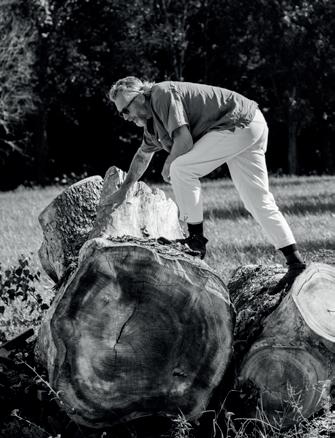
crafted to fit into your home – not just as a piece of furniture, but as something that reflects who you are and blends seamlessly into your lifestyle.”
Craft-driven philosophy with intention
The JALG collection is influenced by the mid-century era and reflect Japanese aesthetics. Made from sustainably sourced wood, the TV stands feature clean lines, subtle details, and a paireddown look that also echoes the essence of Nordic living – where form follows function, and simplicity meets elegance.
Beyond aesthetics, functionality is key. Each TV stand includes smart cable management and an intuitive assembly, staying true to the Scandinavian principle that beauty and practicality should go hand in hand. "In my opinion, good design is functional, timeless, comprehensible and, of course, aesthetically pleasing,” reiterates Veiko
The products feel like a natural extension of their environment. As proof of its success, JALG has recently won the furni-
ture category at the Red Dot Award 2024, which recognises outstanding industrial design and highlights the teams behind the concept.
Scandinavian minimalism meets Parisian chic
The duo’s work has also been featured in prestigious contemporary projects around the world, including a recent collaboration with FESTEN Architecture for the newly redesigned Hotel Balzac in Paris.
This five-star boutique hotel just off the Champs-Élysées is a landmark of Parisian refinement, reimagined with a warm, modern sensibility by the acclaimed French team. In every suite, JALG’s TV stands are paired with soft lighting, custom furnishings, and carefully curated textures, demonstrating how technology can be integrated into luxury establishments without disrupting visual harmony.
Supported by clean visuals and sophisticated interiors, the brand’s presence at Hotel Balzac is a testament to its growing influence in global design circles, and its

relevance within the world of boutique architecture and contemporary living.
Playful look for a modern-day lifestyle
For a playful element, the acrylic line adds a pop of colour. Argo explains; “The acrylic range is inspired by the Spage Age in the 1950s, which is often typified by futuristic elements and the use of plastic
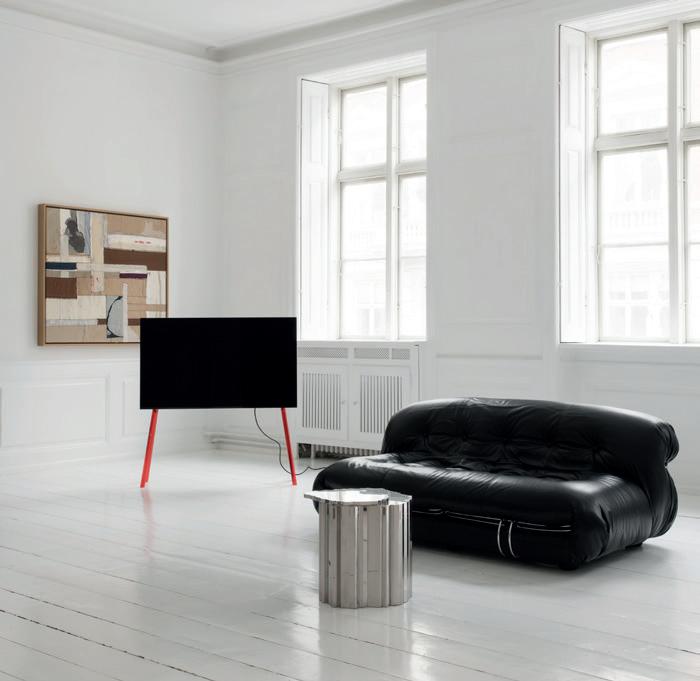
or fiberglass – providing an interesting contrast to traditional interior design.”
Clearly, this is not just about decoration – it is about intention. The brand continues to attract interior architects and design lovers seeking pieces that are both grounded in tradition and suited for modern life. Whether placed in a private home or a Parisian suite, JALG’s furniture brings understated design to spaces that demand both elegance and ease.
JALG exports to over 40 countries and has partners in markets such as Denmark, Japan, South Korea, and the UK. Explore the full collection and sign up for the newsletter for stories, product launches, and behind-the-scenes craftsmanship.
www.jalg.me
Facebook: jalgTVstand
Instagram: @jalgtvstand

Every JALG TV stand is made with purpose. The wooden collection features a palette of material, tone and textural finishes:
Oak Natural Oil Wax – Classic and warm, celebrating the wood’s grain.
Oak YakiSugi – A deep, charred black, using a traditional Japanese woodburning technique.
Walnut and Birch Natural Varnish –A lustrous finish that enhances the richness of the wood.
Birch White and Black – Crisp and contemporary, perfect for minimalist interiors.
This salad with sautéed asparagus, browned lemon butter, toasted pumpkin seeds, parmesan cheese, and grated lemon zest is both easy and delicious. It’s a fresh and vibrant side dish that pairs well with a range of main courses.
By Katharina Kjeldgaard
Tip: You can also use other kinds of seeds such as toasted pine nuts or sunflower seeds.
Amount: 4 people
Easy to make
Time: 20 minutes
Ingredients:
400 g asparagus
2 ½ tbsp olive oil
1 ½ tsp flaky salt
25 g butter
Instructions:
½ lemon (both zest and juice)
½ tsp freshly ground pepper
100 ml pumpkin seeds
25 g Parmesan cheese
1. Begin by preparing and washing the asparagus. You can either snap off the tough white ends at the bottom or trim them off with a knife.
2. Sauté the green asparagus in a pan with two tablespoons of olive oil and 1/2 teaspoon of flaky salt. Cook for about 10 minutes over a medium heat, or until they start to look grilled.
3. Meanwhile, you can prepare the roasted pumpkin seeds and the lemon butter. First, for the pumpkin seeds: place them in a small pan along with 1/2 tablespoon of olive oil and 1 teaspoon of flaky salt. Sauté until they begin to turn golden, then transfer onto a plate.
4. Now for the butter. Finely grate the zest from the half lemon using a grater and set it aside. Melt the butter in a small saucepan. Using a silver-coloured pan is recommended so you can easily monitor the butter’s colour. It should brown, but not burn. Melt the butter over a medium heat and keep an eye on it. Remove from the heat when it begins to turn light brown, which should take about 3-5 minutes after the butter has fully melted.
5. Remove the butter from the heat and add the juice from 1/2 lemon, along with freshly ground pepper. Stir well.
6. Now it’s time to assemble the salad. Start by arranging the asparagus on a serving platter. Then drizzle over the browned lemon butter and top with the pumpkin seeds, cheese, and lemon zest.


Katharina Kjeldgaard is a Danish food blogger, influencer and cookbook author from Copenhagen., Her blog is one of the most-read vegetarian food blogs in Denmark, always focused on locally sourced ingredients, full of delicious recipes and never boring. She has three little kids and loves going to markets, being in nature - and cooking with all kinds of vegetables and legumes.
Blog: beetrootbakery.dk Instagram: @Beetrootbakery
By Malin Norman
Much like big cities such as New York and Tokyo, the beer world never sleeps. This might give rise to a feeling of missing out; on the best-rated beer bars, the most hyped new beer releases, and the coolest beer festivals. Staying in the loop can be exhausting, but here’s a tip; embrace your own beer journey.
Untappd can be one such source of stress, at least it used to be for me. This is the world’s largest platform for searching and rating beers – a bit like having your own beer tracker. It’s incredibly popular with millions of users around the world. Some of my friends have rated more than 8,000 different beers here, which is equally insane and impressive!
At one point, years ago, I started using Untappd but soon deleted it and got rid of any notion of ever being able to track all the beers I try. Having judged an absurd amount of beers blind in competitions and tasted beers in bars, at festivals and in bottle shares, my Untappd experience was bound to fail – I just couldn’t keep up! It might be a great platform, but not for me.
Travelling can also be overwhelming, and I don’t mean the travel itself but rather what not to miss at the destination. As part of my beer sommelier certification, ten years ago now, I went on a mission to build a portfolio with brewery visits around the world. The list grew longer, but I still haven’t been to some of the classics that people rave about. I have stumbled upon some wonderful places though, unplanned and random, and these are my most cherished moments.
With experience comes wisdom (if we’re lucky) and what I’ve come to realise is that there’s no point in trying to do it all – in fact, it’s impossible. You see, the beer world never sleeps. Instead of feeling bewildered by the never-ending activity and places to visit, just enjoy the journey
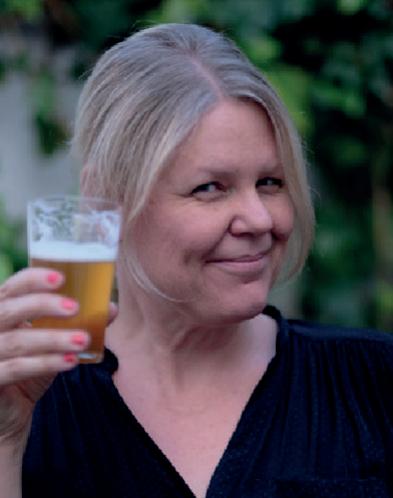
and devour your own beery moments (that others are missing out on).
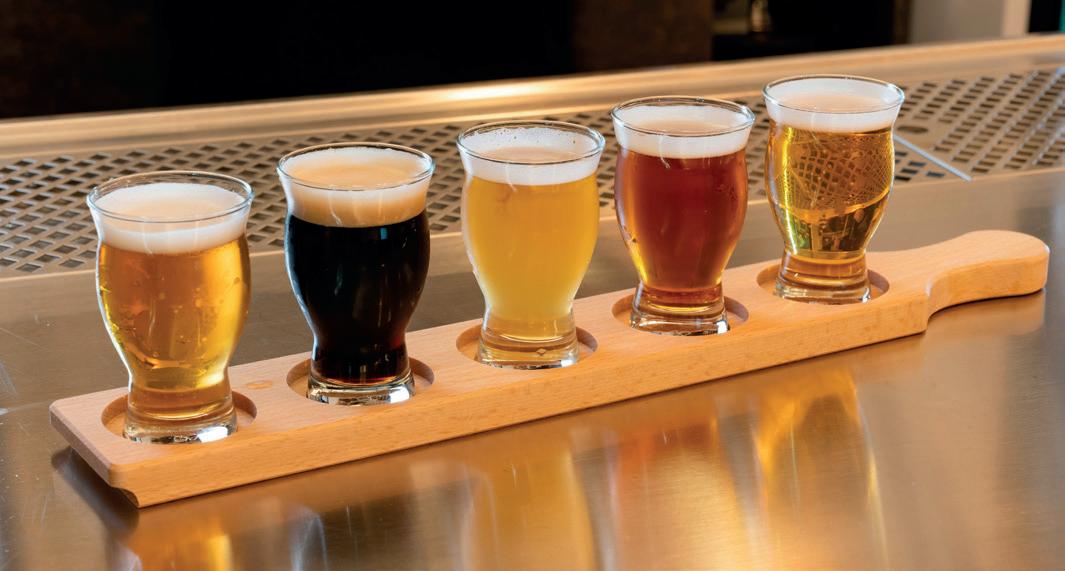

Smørrebrød, the classic open-faced rye sandwich stacked with savoury toppings, remains Denmark’s most popular lunch dish. However, with the Danes looking to cut food waste and make their meals more sustainable, smørrebrød is becoming greener and more eco-friendly.
By Teja Lele
Lunch in Denmark is synonymous with smørrebrød, an open-faced sandwich piled high with toppings. The Scandinavian country’s unofficial national dish can be as simple as a slice of buttered bread. But the bread, dense and sour Danish rye, is typically a sturdy, flavourful base for layers of fixings, including marinated herring, pickles, matured cheese, and aromatic herbs.
Historians trace the first mention of the word smørrebrød to the turn of the 18th century. The dish harks back to Denmark’s agrarian past when farmers (or their wives) would pack rye bread and leftovers from the previous night’s dinner for lunch. By the late 19th century, squares of buttered dense rye topped with meat, fish or eggs, paired with Danish beer or aquavit, were available in many Copenhagen restaurants.
In 1888, Oskar Davidsen opened a wine bar in Copenhagen. His wife, Petra, began serving smørrebrød to hungry customers, and their establishment soon offered no less than 177 varieties. All the toppings were layered on the nutritious, filling, and tasty rugbrød, which the Danes have eaten for more than 1,000 years.

“The Danes love rugbrød. Rye grows best in our soil, and the whole grain provides the calories we need for the weather,” says Guxi Maria Abel, on a food tour of Torvehallerne, one of Copenhagen’s most popular food markets.
Smørrebrød was the lunch of the working class during the industrial revolution, and was appropriated by the upper class with lavish toppings, says Abel, adding that the working class would typically top rye bread with pork liver pâté and pickled beetroot, fat balls with salt, or ham and mustard.
The Danes still love their meat. Nearly six million follow an animal-based diet, with an average Dane consuming nearly three times the recommended amount of red meat.
The Danish government is, however, nudging its citizens to eat more plantbased food. It has allocated almost €100 million to ensure Denmark's leading position in the production and development of plant-based foods, eventually
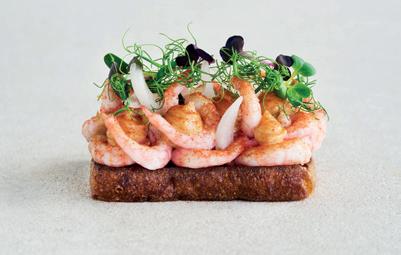
improving overall health and fighting climate change.
Smørrebrød, the go-to Danish lunch, saw a decline in its popularity in the 1980s and 1990s, but has seen a resurgence in recent times. The green shift is also seen in the open-faced sandwich, with many restaurants offering vegetarian options and a cauliflower-based mayo.
Adam Aamann, the chef credited with bringing the sandwich back to the table with his upscale eateries, agrees that smorrebrod is going more and more green. “The sandwich is traditionally made with meat or fish, but there are many more vegetarian options now,” he says.
Aamann feels that people would not have gone for the vegetarian options ten years ago. But tastes and choices are changing across Denmark. “A lot of plant-based meals are available in cities, which gives us the chance to be creative,” he says.
Getting creative
Aamann uses pickled, green, and marinated vegetables, and innovates with the toppings. “Options include potato with pickled red onions, the beetroot tartare, which combines three different beets with brown butter emulsion, and half-fried cauliflower with truffle mayo,” he says.
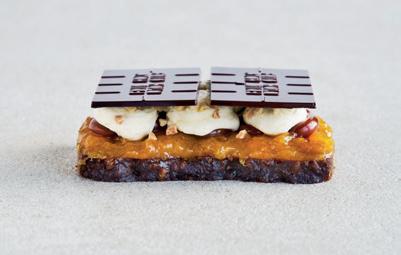
Food historian Nina Bauer agrees that while Denmark’s food culture is centred on meat, there is now a strong focus on eating sustainably. “It's more a question of more vegetables joining the meat on the plate or people eating vegetarian more days per week,” she says.
She adds that there have always been some vegetarian types of smørrebrød, most famously with potato or tomato. “Smørrebrød with potatoes, onions, chives, and mayo is a classic. But a lot of other plant-based or vegetable-forward alternatives are available now,” she says.
Sustainable ideas
In modern times, with the Danes looking to cut food waste and make their meals more sustainable, smørrebrød has also become an eco-friendly lunch option.
Ida Davidsen, great-granddaughter of Oscar Davidson and ambassador of smørrebrød, famously said the dish functions as a vehicle for leftovers, “the way pasta sometimes does for the Italians and crepes sometimes do for the French.” Her century-old restaurant now offers a menu with more than 280 varieties of open-faced sandwiches.
Bauer says a lot of the classical smørrebrød served in restaurants in the late 19th

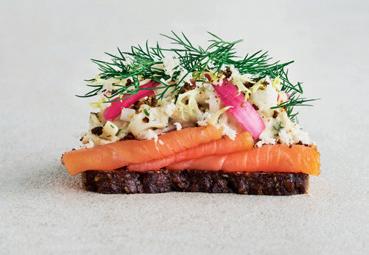
century were cold versions of popular dinner dishes served on rye bread. “Homemade smørrebrød that people made for their lunch boxes were based on leftovers and cold cuts. It's part of the DNA of smørrebrød that you take inspiration from hot dishes and leftovers,” she says.
A work of art
The Danish food philosophy is rooted in a respect for nature and an appreciation for fresh, local produce, with a popular saying stating that “what grows together, goes together.” The farm-to-table movement, now synonymous with Danish cooking, is visible in the modern smørrebrød, which uses fresh ingredients that are in season and complement each other.
Aamann believes that smørrebrød, earlier focused on quantity, is now about quality, with chefs using the rye bread to find and showcase their style. He chooses to let his sandwiches and flavours take their cue from the season.
“In Denmark, our long winter season makes us tired of root vegetables. In spring and summer, we look for new vegetables, flavoursome herbs, and fresher tastes,” he says.
Smørrebrød, a complex, layered pyramid of toppings, textures, and tastes, is more than an open sandwich. It comprises four elements: bread, fat, toppings, and garnishes. But in a country known for understatement and simplicity, chefs believe that when done right, the topping should be in complete harmony with the other three elements, not compete for attention.
R. W. Apple, Jr. said it all: “Leave it to the Danes, those past masters of form and colour, to turn sandwiches into still life.”
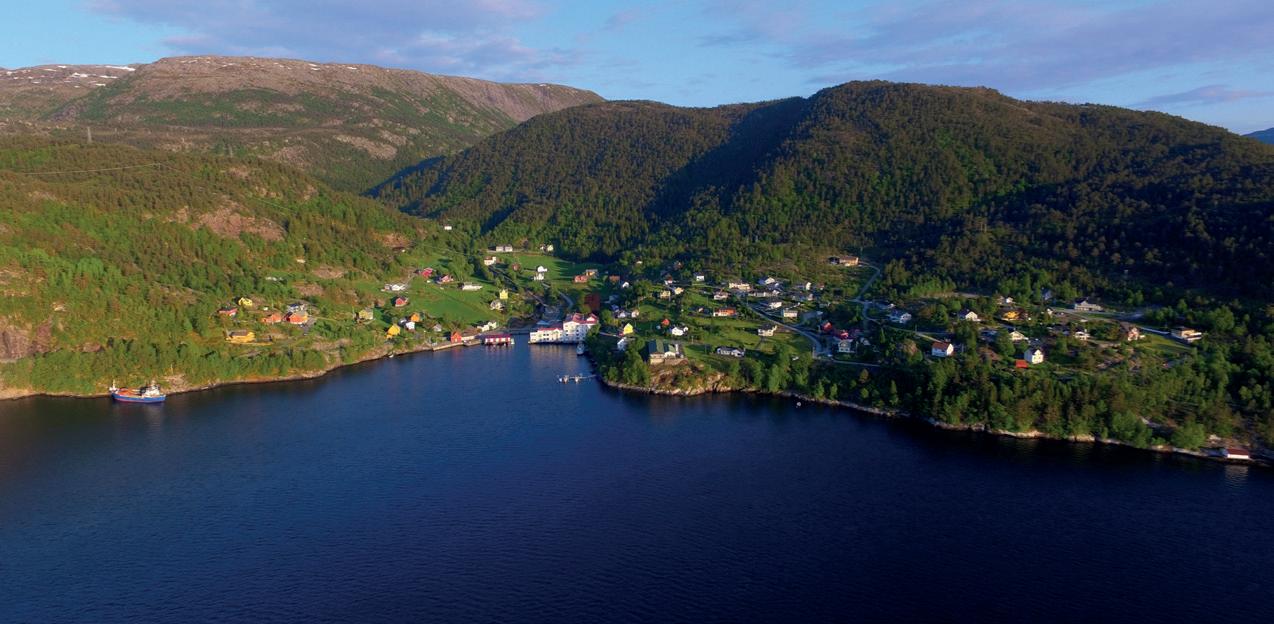
Carrying on a proud legacy dating back to 1866, Tøsse Mølle is rich in history and tradition. Nestled deep in the stunning Osterfjord near Bergen, the mill has produced high-quality oats for five generations and has now taken on a new challenge – an exciting venture into the world of craft beer.
By Maria Sødal Vole | Photos: Tøsse Mølle
Boasting a fantastic location at the innermost part of the beautiful Osterfjord, Tøsse Mølle is surrounded by majestic mountains and unspoiled nature. This hidden gem on the lush, green island of Osterøy has long been known as one of Norway’s best oat producers and is now gaining a reputation for its award-winning artisanal beers.
With a fascinating industrial history, the mill has produced first-rate oats for almost 160 years. As the owner and manager of Tøsse Mølle, Per Helge Svensson is a fifth-generation miller. His great-great-grandfather established the mill in 1866 after identifying the local water supply as a fantastic natural resource for grain production. “Maintaining production in the mill for all these years has required a lot of passion and hard work. We take pride in what we do here,” Svensson says.
The crystal-clear water from the towering mountains of Osterøy has powered
the mill for five generations. The tightknit team uses a traditional drying method to produce top-notch oats, and Tøsse Mølle is Norway’s only pure oat mill, where only oat products are made.
“We often say it’s the old way of doing it, and we believe in our process – it’s what keeps customers coming back again and again,” Svensson says. “A lot of people say that after trying our oats, they can’t go back to store-bought alternatives.”
With the operations rooted in proud craftsmanship and appreciation of quality grain, oats from Tøsse Mølle are known for their rich, nutty flavour and hearty texture. Cartons of the high-quality oats can be purchased online or bought directly from the mill at Osterøy.
The old mill is now the site of an exciting new artisanal brewery, producing what may be Norway’s best craft beer. Launching its first beer in 2024, Tøsse Brygghus brews on-site using its own oats and the pristine mountain water that is well-suited to brewing.
The team comprises some of Norway’s top experts in the field, including Kjetil

Jikiun, a renowned pioneer in craft beer, and the skilled local brewer Andreas Elvik Litland.
“Quality is paramount – we’re fortunate to have easy access to the best natural ingredients to create high-quality beer,” Svensson says. “The use of oats in all the beers is our signature. We believe it gives the beer great taste, depth of flavour and a round, smooth mouthfeel.”
Tøsse Brygghus has already become a welcome and celebrated addition to the craft beer scene. In fact, the IPA Steinmalt and the versatile all-rounder Møllepils both won awards at the Korea International Beer Award 2025.
The team is committed to honouring the industrial heritage of the mill while creating innovation and quality products for the future. Breathing new life into the old mill, the brewery represents an interesting fusion of past and present, celebrating local ingredients and traditions.
“We wanted to create new activity in the mill, and beer production was the natural choice because we’re in the perfect position to use the pure, unfiltered water from the local mountains and our own premium oats,” says Svensson.
The brewery offers eight to nine distinct beer varieties along with alcohol-free options, and the team is constantly work-
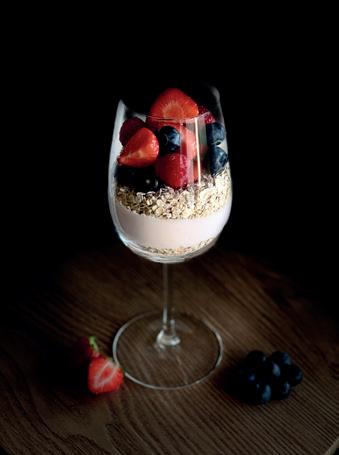

ing on new developments. The beer can be purchased from the retail monopoly Vinmonopolet and certain local shops, as well as specialty shops around Norway.
An ideal venue for unique experiences Located just 50 minutes from Bergen by boat or car, Osterøy is a fantastic destination for day trips or weekend getaways. Tøsse Mølle welcomes visitors looking to explore the local history and nature, discover the history of the mill, and enjoy a taste of excellent craft beer.
The brewery’s beer tasting experience is popular both among locals and visitors from further afield. It includes a walk around the brewery and a tasting board
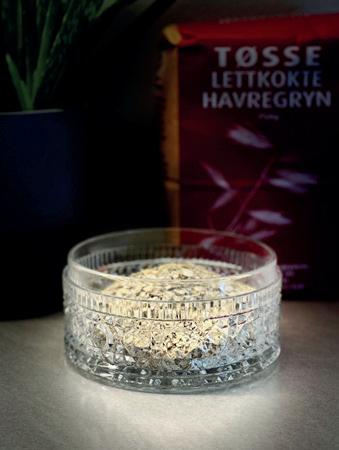
with several beer varieties, served with local cured meats from a traditional goat farm in Tyssefjella, where the goats are fed with oat flour from the mill.
The team puts on several big events every year, attracting numerous visitors, and the spring celebration will take place on 10 May. “We really enjoy planning fun events and concerts that get people excited to come to this unique venue,” says Svensson. “Our events are always popular and sell out every time!”
The brewery offers tailor-made experiences for groups of between 5- 60 people, hosting celebrations, team-building and other special events. The team can also facilitate overnight stays in a historic local hotel and guided tours in the beautiful natural scenery.
www.tossemolle.no
www.tossebrygghus.no
Facebook: Tøsse Brygghus
Instagram: @tossebrygghus
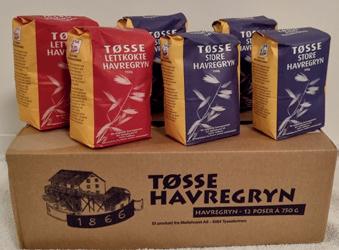

With more and more travellers seeking to get away from the southern summer heat and unsustainable patterns of mass tourism, Sweden does, with its many original offers, rich cultural scene and striking historic structures, offer an undeniably attractive summer getaway. All easily accessible from the rest of Europe.
By Signe Hansen

Traditionally, most travellers have chosen to visit Sweden for skiing in winter or in summer by the lakes/sea, but within cities and towns also hides a host of cultural, historic and natural gems. Together with the country’s stunning landscape, a growing number of cultural hubs and a booming culinary scene are making it a favourite destination not just for travellers looking for outdoor adventures, but also for couples on romantic getaways,
single travellers searching for cultural stimulation, and families on the lookout for educational and child-friendly offers.
In this special theme, we journey through Sweden’s vibrant summer offerings, from Stockholm’s breathtaking archipelago - recently named one of the world’s top destinations by National Geographic - to Gothenburg’s stunning botanical garden, one of the largest in Europe. Along the
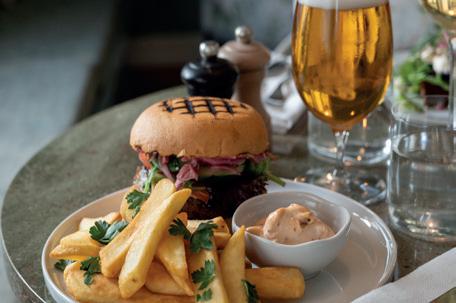

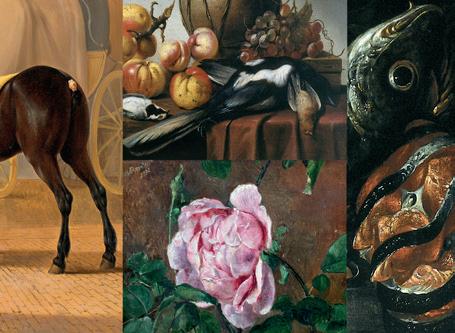
way, we explore the maritime wonders of Maritiman, the world’s largest floating museum; the contemporary exhibitions at Liljevalchs and Skissernas Museum; and the historic charm of Hovdala Castle. For a relaxing retreat, we also stop by Villa Baro, where nature, culture, and leisure meet in perfect harmony.
Indeed, with an enchanting combination of art, architecture, history, unforgettable accommodation, and stunning nature – a summer holiday in Sweden is sure to astonish and inspire you. As times are changing and culture, history, and sustainable tourism are becoming the most sought-after attractions, there is no better place to look to for your next holiday than Sweden.
www.visitsweden.com
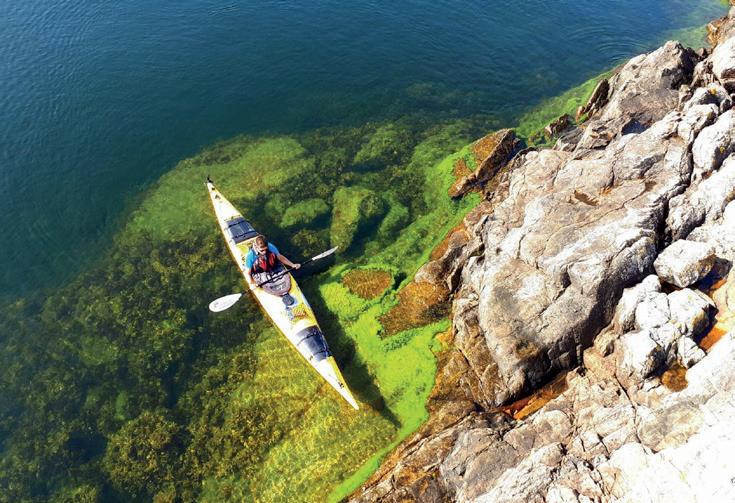
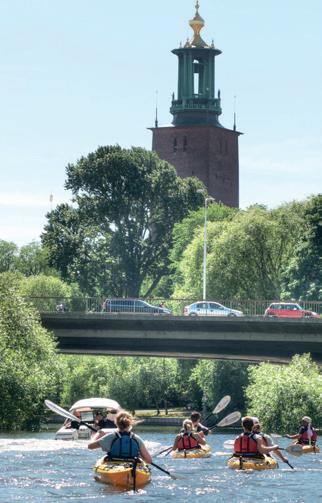
Stockholm Adventures offers a fully packed schedule of guided tours and tailored activities in and around Stockholm. Take the opportunity to explore the archipelago, listed as one of the best places in the world to visit this year.
By Malin Norman | Photos: Stockholm Adventures
One of the highlights for locals and visitors in the Swedish capital is the archipelago, home to around 30,000 islands and islets, where you can hike the newly opened Stockholm Archipelago Trail – a 270-kilometre route that covers many of the islands. National Geographic has listed Stockholm Archipelago as one of the 25 best places in the world to travel to in 2025, and TIME has included Stockholm
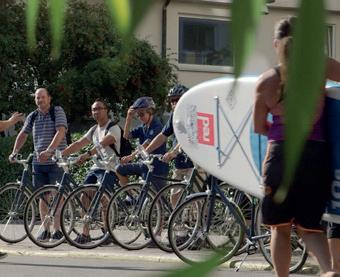
Archipelago Trail in its list of the world’s greatest places of 2025.
Stockholm Adventures has a wide range of things to do in the archipelago, including multi-activity packages with kayak, boat and hiking tours. “The wildlife, rugged scenery and serenity of the archipelago will blow you away. It really is a very special place,” says founder Joakim Malm.
Among other popular activities in Stockholm and its surroundings are wildlife safaris, offering small-group experiences to get up close with nature and spot moose, wild boars, deer, and birds. And one of the best ways to see the city and its locals is a bike tour, according to Malm; “You can discover a mix of modern and historical architecture, grand public squares, winding cobbled alleys, and lively areas with cafés, bars and restaurants.”
In addition to the existing programme, Stockholm Adventures is continuously updating activities, tours and courses. Malm adds: “We put great emphasis on using only high-quality equipment and delicious food from local producers, and of course with outstanding hospitality and careful consideration for you and the environment in mind every step of the way.”
www.stockholmadventures.com
Facebook: StockholmAdventure Instagram: @stockholmadventures

All tours are offered in English, and Stockholm Adventures has bike tours in German, Dutch and French.
“Give it the time it deserves.”
Tripadvisor
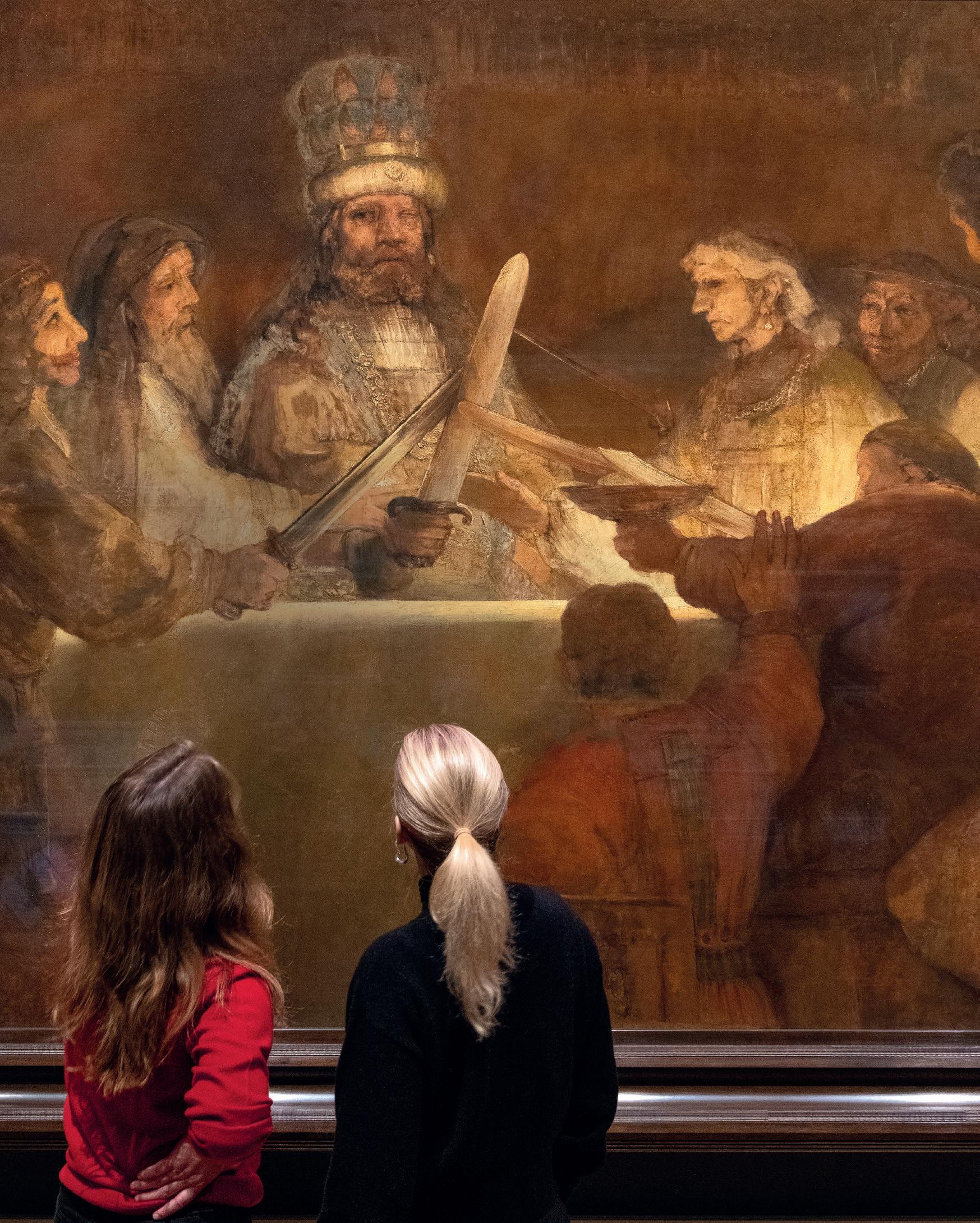
“Best art museum in the city.”
Tripadvisor
“A special place. Try not to miss it. Beautiful building too.”
Tripadvisor
Enjoy a visit to one of Stockholm’s most beloved destinations, in the heart of the city. Marvel at masterpieces of fine art and design in a stunning historical setting. Afterwards, enjoy a classic Swedish fika or seasonal lunch in the museum’s restaurant. Free admission under the age of 20 and every Thursday night, free for all.
nationalmuseum.se facebook.com/nationalmuseumswe instagram.com/nationalmuseumswe
Nationalmuseum collaborates with Svenska Dagbladet, The WineAgency, Nationalmusei Vänner and American Friends of Nationalmuseum.
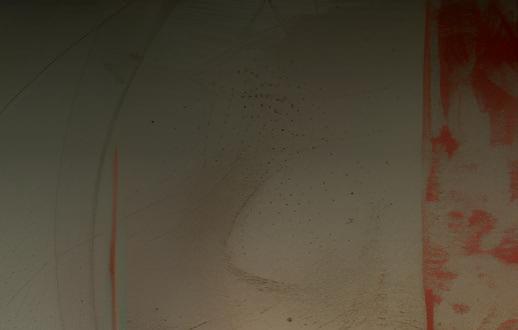


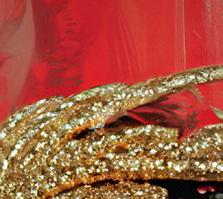


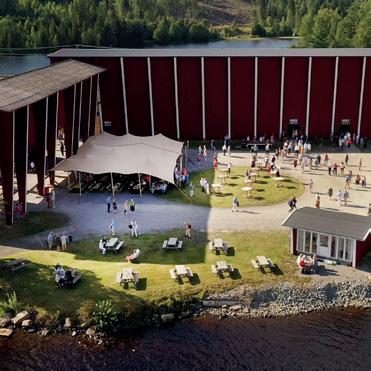
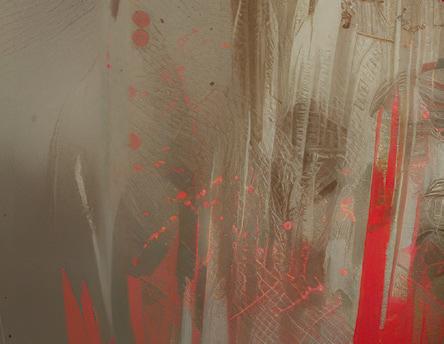


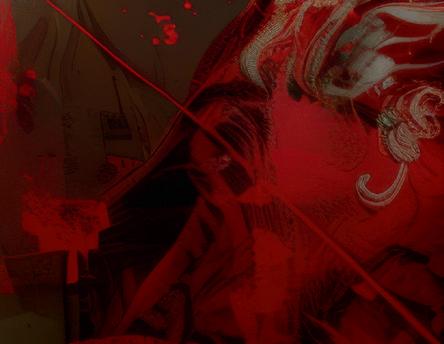

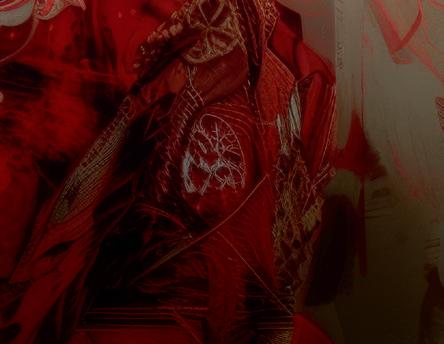


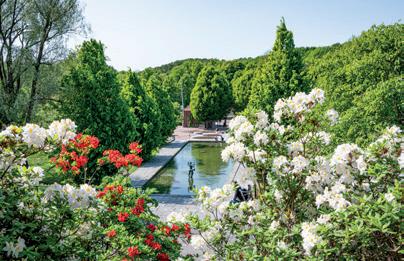

The gardens are expanding to cater to growing interest. Design image: Cobe
On a mission to restore the future of plants, Gothenburg Botanical Garden showcases over 100 years of biodiversity, balance and beauty. Situated in the heart of the city, the green oasis is a popular attraction for curious visitors of all ages – and is growing steadily with a stunning new visitor centre and additional glasshouses in the works.
By Emma Roedin | Photos: GBG Botaniska
Botanical gardens differ from 'standard' gardens as they have documented collections of living plants for research, preservation and educational purposes. And as the natural habitats for plants change, botanical gardens are becoming increasingly important worldwide to help protect endangered species. "Our job is simply to preserve, educate and research the diversity of the plant world," says Maria Arlmark Björn, head of communication.
This summer, visitors can, among other things, look forward to an abundance of flowering bulb plants. In fact, this garden has one of the world's most impressive collections of bulbs and tubers and has been home to the alpine onion since the 1920s. Visitors are also sure to enjoy the Alpine House, the garden's latest glasshouse, which perfectly embodies the institution's overall mission.
With a vast playing field of 185 acres, Gothenburg Botanical Garden boasts 20,000 plant species and hybrids from over 130 countries – one of the largest collections of its kind in Europe. Add Rock Garden, a spectacular waterfall, a lush herb garden, a calming Japanese valley and a multifaceted programme of events and exhibitions to this, and you
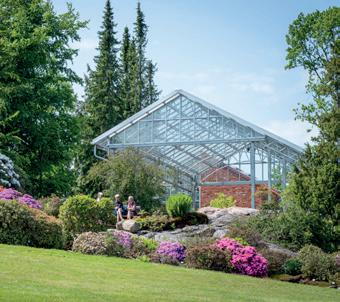
will see why botany and horticulture enthusiasts leave full of praise.
"People come here to enjoy plants from all corners of the planet in beautifully composed sections," says Arlmark Björn. "As it stands, we have over 600,000 visitors to the garden every year, which actually makes us one of Gothenburg's biggest attractions." However, it is not all about pretty views and serene surroundings; over the years, the garden has become an essential supporting body to scientific research.
Gothenburg Botanical Garden also plays an important educational role as a place for children to learn about nature and how to respect it. To offer a more attractive visitor experience year-round and to continue to develop both in species conservation, research and public education, additional greenhouses and a new visitor centre are being built and are expected to open in 2030. Until then, the garden, with all its botanical brilliance, is open as usual and ready to impress.
www.botaniska.se
Facebook: goteborgs.botaniska.tradgard


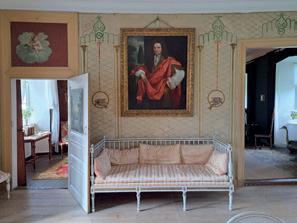

This summer promises exciting Medieval knights, fascinating storytelling, and a visit from Antikrundan, the Swedish version of Antiques Roadshow, at Hovdala Castle.
By Malin Norman
Outside Hässleholm, between forest and fields, lies Hovdala Castle. The beautiful whitewashed buildings, their surrounding park and lush garden, hide many secrets and unknown destinies. “Hovdala Castle is a magical place,“ says Magnus Metz, who manages the castle. “Apart from stunning nature, it’s a culturally and historically interesting destination. The estate is located in a region that, for hundreds of years, faced conflict between Denmark and Sweden. On the castle gate, you can still see bullet holes as a reminder of these troubled times.”
Some of the fascinating stories are about the Ehrenborg family, who lived at the castle from 1665 to 1981. “For instance, Mikael Ehrenborg was fascinated by the scientific advances of the Enlightenment era,” explains Metz. “From his military service in Europe, he brought back books on the universe, mathematics, scientific methodology, humanism and law. It was assumed that he built a library on the estate, but thanks to recent discoveries, it looks more like the octagonal ruin was intended as an observatory.”
Medieval knights and storytelling evenings
One of the biggest events at Hovdala Castle is the Medieval Days on 30-31 May, with the Swedish championship in jousting, as well as activities, entertainment, and a market. “Every year, we have up to 14,000 visitors during these two days,” smiles Metz. “A highlight is also the traditional midsummer celebration on 20 June, which attracts some 6,000 visitors.”
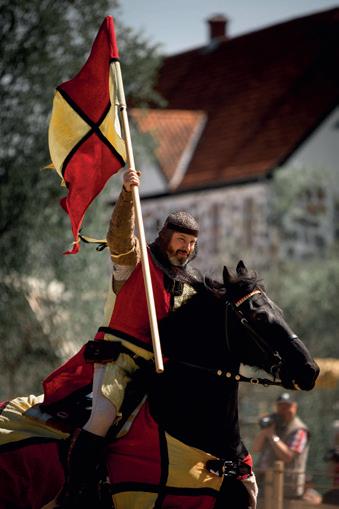
This summer, Hovdala Castle offers a series of storytelling evenings. Archaeologist and author Bo Knarrström will talk about the Snapphane peasant rebel movement in the 17th century, whilst research archivist Mathias Strandberg will present historical and current dialects in the region of Skåne. Criminal lawyers and authors Lena Ebervall and Per E Samuelson will share stories on Swedish law scandals, and author and journalist Anna Larsdotter will talk about women in the history of war.
Hovdala Castle will also host the Swedish version of BBC’s Antiques Roadshow on 22 August. “We’re proud to welcome Antikrundan , one of Sweden’s most successful TV programmes, and look forward to sharing this beautiful place with the whole nation,” confirms Metz. And the castle offers much more: courses in craftsmanship, concerts and opera, exhibitions and guided tours. The restaurant and café are both popular, and nearby Rallarhustruns Hotell & Bistro and Tostarps Pensionat are great alternatives for those who want to stay the night.
www.hassleholm.se
Facebook: hovdalaslott
Instagram: @hovdalaslott
At Maritiman, visitors can learn about life at sea in a playful and exciting way, without leaving the dock. Climb into a real submarine, get on board a massive destroyer, or play with the mascots Tim and Virvelina.
The floating maritime museum Maritiman is moored at Packhuskajen in central Gothenburg. Its collection of ships, boats and barges are all floating on the river Göta Älv, and the museum is part of the city’s cultural heritage. “Maritiman represents Swedish maritime history, both military and civilian,” says Johannes Olsson, visitor experience manager. “For more than 35 years, we have been displaying the living conditions at sea and the experience of being in the navy.”
The destroyer Småland is particularly popular. The largest vessel on display, she is as long as a football field and eight floors high. And this year, the monitor Sölve celebrates its 150th anniversary with an exhibition about its long life as a military ship and oil barge, and what life onboard looked like.

Many take the opportunity to climb into the submarine Nordkaparen, where the periscope is the only contact with daylight and the outside world. “We encourage visitors to explore,” says Olsson. “This is not an ordinary museum on land; you can actually enter most of our vessels and feel what it was like to live and work on board.”
Mascot Tim conducts exciting maritime experiments with children, and he
By Malin Norman | Photos: Maritiman
is accompanied by Virvelina, an adventurous character who hides treasures for the young ones to search for. Maritiman also has an excellent programme of events and guided tours, and the Matrosen snack bar provides refreshments so that sea explorers can throw themselves into more discoveries on board with renewed energy.
www.maritiman.se
Facebook: maritiman
Instagram: @maritimangbg


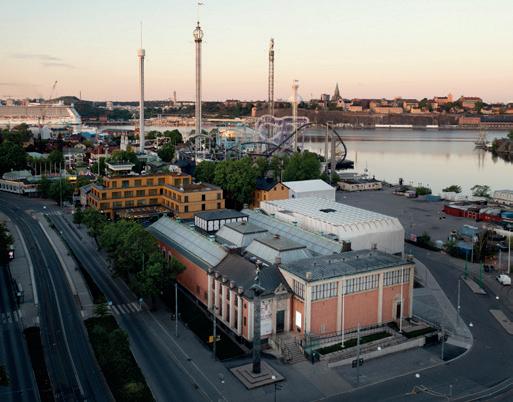
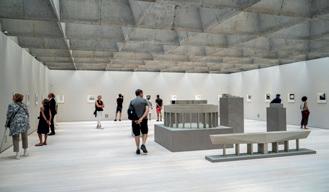


This spring and summer at Liljevalchs promises an immersive and unforgettable art experience, ranging from Sámi crafts and the magic of snow, to unusual birds and the elemental forces of rivers.
By Malin Norman
Liljevalchs first opened its doors in 1916 as the first independent and public art institution for contemporary art in Sweden. In 2021, the new building Liljevalchs+, designed by renowned architect Gert Wingårdh, was added and provides another 2,400 square metres across six floors.
As the country's oldest and largest art space, Liljevalchs has firmly placed Sweden in the international arena. "Our exhibition programme is aimed at a broad and diverse audience as well as those particularly interested in certain artists or art and design trends," says Joanna Sandell Wright, director and artistic director. "Liljevalchs is an immersive experience, where the exhibitions reinforce each other and hopefully provide new and unexpected perspectives."
This spring and summer, Liljevalchs presents Drick Drick by Carola Grahn, one of Scandinavia's leading contemporary artists. Grahn is of southern Sámi descent, and her work often interweaves dark
humour, popular culture references and Sámi traditions to challenge stereotypes and power structures. Opened in March, the exhibition has received an overwhelming response from everyone from art critics to children. "One of our young visitors, a four-year-old girl, told us that it was her biggest art experience so far," smiles Sandell Wright.
A room with snow, an overflowing glass, a joik machine, brooms, and 17 engraved knives are the building blocks of the large-scale, meticulously crafted installations. "Drick Drick is one of the not-tobe-missed art exhibitions in Sweden,"

says Sandell Wright. "Grahn transforms ordinary objects into compelling symbols of personal experience, social critique, and collective memory." Drick Drick is available until 10 August.
On 13 June, Liljevalchs opens the new exhibition Lars Jonsson, invisibilis. "Jonsson is an internationally known ornithologist and the most prominent painter of birds and nature in Sweden," says Sandell Wright. "In this fascinating exhibition, his lifelong artistry alongside many new works are presented. We will have the chance to see how he observes nature and draws birds in the field, and visitors can try drawing birds themselves."
Stockholm's most beautiful art space offers more fascinating exhibitions, such as the award-winning River Biographies by Lundahl & Seitl, a project engaging with the elemental forces of eight rivers, as well as enticing activities and performances. Visitors can easily spend a whole day at Liljevalchs and refuel afterwards at the newly renovated restaurant Blå Porten, with seating both indoors and outdoors, and buy the perfect gift in the shop.
www.liljevalchs.se
Facebook: liljevalchs
Instagram: @liljevalchs
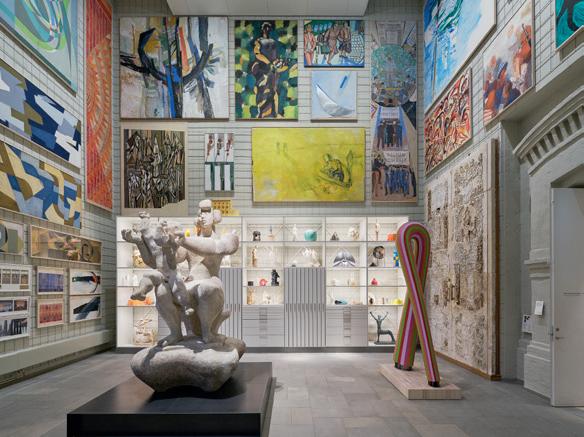
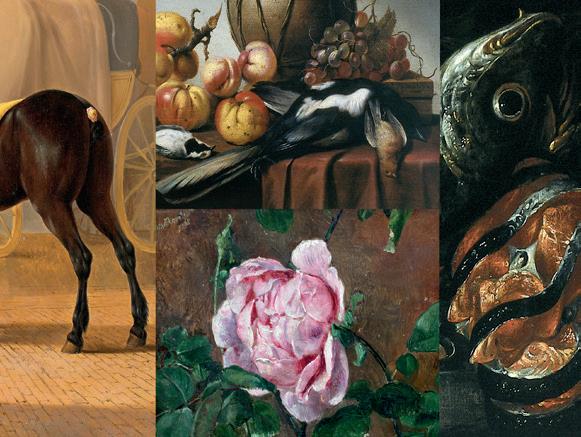
At Skissernas Museum – the Museum of Artistic Process and Public Art – you will discover a new perspective on art. Here, you can learn about and fall in love with the sketches, models, pictures, plans and objects that led to some of the world’s greatest public artworks.
By Malin Norman
Skissernas Museum was founded in 1934 by Ragnar Josephson, a professor of History of Art at Lund University. He wanted to create an archive of the creative process that students could study. The museum is home to the world’s largest collection of creative-process works and public art and includes 30,000 objects from across the globe. “You really need to come and see it for yourself. It’s mindboggling,” says Annie Lindberg, museum director.
Highlights in the International Gallery include works by artists such as Henri Matisse, Sonia Delaunay, Henry Moore, Fernand Léger, Diego Rivera and David Alfaro Siqueiros. The Swedish Gallery displays, for instance, Sigrid Hjertén, Isaac Grünewald and Siri Derkert, as well as contemporary artists such as Linn Fernström, Ann Edholm and Matthias van Arkel.
Both the content and the design of the museum are unique. It feels more like a
creative art studio than an art gallery. “We want visitors to feel inspired by the creative journey. There’s also a space where people can discuss and reflect on public art. We ask questions like who decided what art we see? What do public artworks say about their time? Public art mirrors society, so it’s an important conversation to have,” Lindberg explains.
From 5 June to 2 November, the museum will present artist and researcher EvaMarie Lindahl in the exhibition The Museum Fauna – Lost Tails and Unheard Stories of Resistance. With her artist gaze and using contemporary art as an input, Lindahl examines the history of collecting and highlights individuals and stories hidden in collections at the museum and Lund University.
AnonyMouse, by creators Elin Westerholm and Lupus Nensén, will also be shown this summer, from 27 June to
24 August. A selection of their miniature worlds from Malmö and Lund will be hidden here and there in the exhibition halls for visitors to discover. Sketches and preliminary works from the mice's hiding places will also be on display.
In addition to the exhibitions, a varied programme is available for all ages with guided tours, artist talks, lectures, concerts, creative workshops, and much more. You can also enjoy delicious food on the terrace of the museum's award-winning restaurant, with a view of the Sculpture Park.
www.skissernasmuseum.se
Facebook: skissernasmuseum
Instagram: @skissernasmuseum
Johan Persson
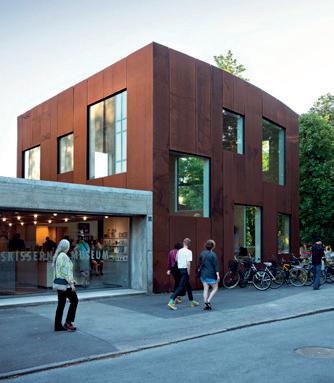
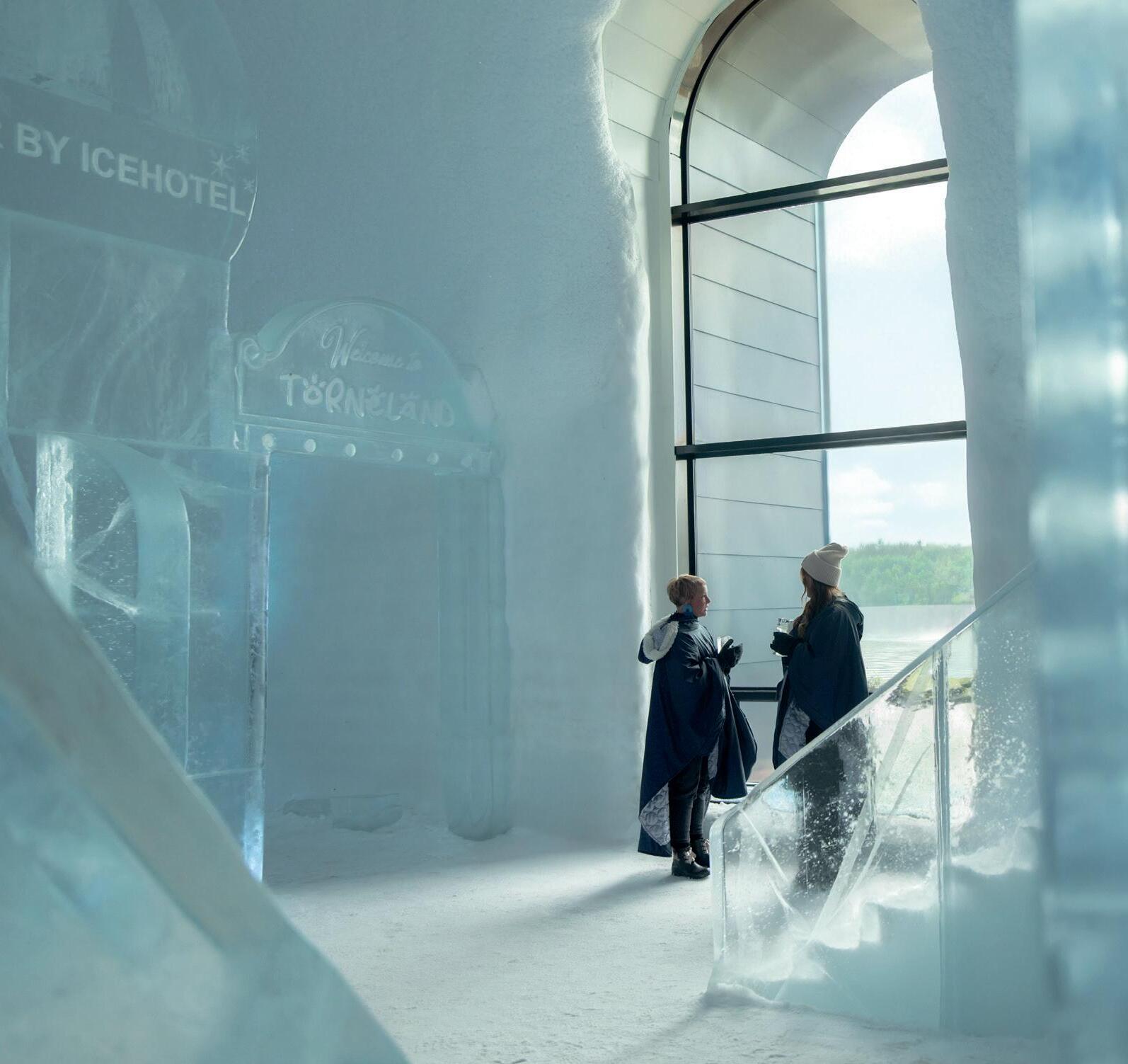
Switch crowds for open landscapes. City walks for fishing trips. Nightlife for days without end. Visit ICEHOTEL in Sweden and experience the Arctic summer with pristine rivers, the midnight sun that never sets and unique crystal-clear ice art in ICEHOTEL 365.
Welcome to ICEHOTEL for a night surrounded by ice art. www.icehotel.com





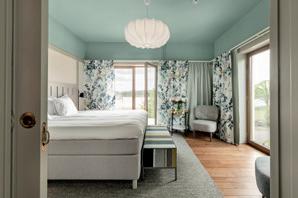
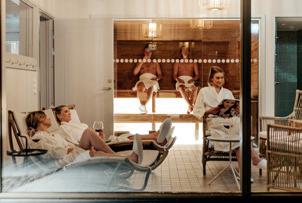
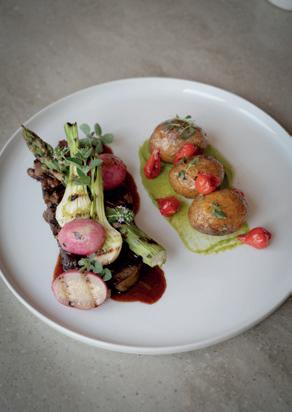
At Villa Baro, all your needs are catered for. A game of golf, a hike on a picturesque trail or a culinary delight in the restaurant awaits you.
By Malin Norman | Photos: Villa Baro
Villa Baro’s story began in the 1760s, with the construction of a country house by the lake Bysjön in southern Sweden. In 1901, the house was relocated across the lake and became a school for practical and creative gardening. A blossoming establishment would follow, before the school became a hotel in 1957. “In 2018, the hotel underwent a substantial renovation, leading to the grand opening of Villa Baro in 2020,” says hotel manager Sabina Lundgren.
Villa Baro also opened a new wing with hotel rooms, lounges, a yoga studio and conference rooms. And only 15 minutes away by foot is Adelwärdska villan, with nine extra double rooms, a kitchen, and
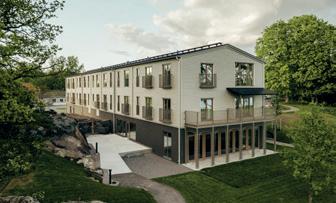
a view reminiscent of an Italian dream destination.
The rural surroundings are full of wildlife, and the hunting is on point. This also means locally sourced meat for the award-winning kitchen. “We have our own beef, venison, crayfish and lamb,” says Mikaela Andersson, food and beverage manager.
Prepared by renowned chefs and kitchen staff, a meal at Villa Baro is a given. “Our goal is to offer experiences that exceed expectations, with top-class hosting and a wide range of activities all year round,” continues Andersson. “And guests can rent the entire building for conferences, weddings or celebrations.”
A visit tends to lead to another. Guests dropping by for lunch often return later for a weekend stay with their partner or friends to experience the magical Scandinavian nature, and of course, some of Sweden’s finest golfing. “The golf course is a point of pride,” adds Lundgren. “It’s a park course and we have one of the most
famous holes in Sweden, called Långa Sjö, along the lake.”
When it is finally time to wrap up after a day of activities, you will feel right at home indoors. The interior decoration is second to none. “No stone has been left unturned,” says Lundgren. “Our architects have decorated the site together with project manager Malin Adelswärd. It’s modern and daring, yet harmonious.”
For the ultimate stay, book the Villa Baro package with a three-course dinner, accommodation and breakfast. Combine with an activity in the beautiful surroundings, relaxation in the wellness area, or try the new outdoor tranquillity pool with a view of the lake.
www.villabaro.se
Facebook: villabaro
Instagram: @villabaro
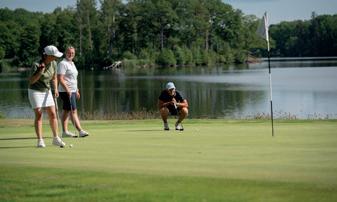
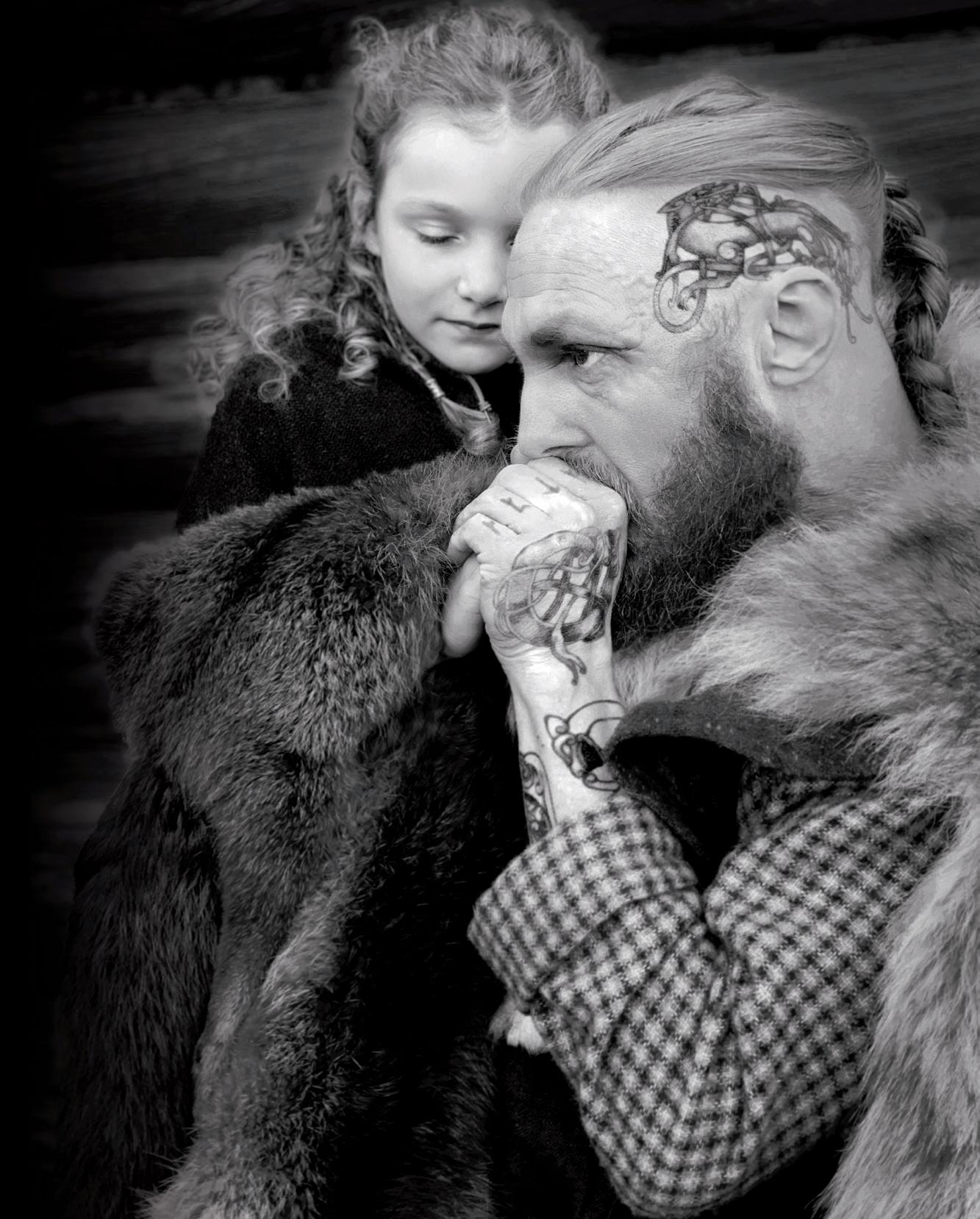

This summer, Kristiansand will once again host The Tall Ships Races. The spectacular event will bring majestic tall ships from around the world to the city's harbour, offering an unforgettable experience. It promises to be a grand celebration blending adventure, coastal history, and cultural exchange into one remarkable festivity.
By Celina Tran
In 1956, the very first Tall Ships sail training race set off from Torbay in the UK to Lisbon in Portugal. The event, which was to be a celebration of the world’s remaining Class A Tall Ships, was such a spectacle that the Sail Training International Committee decided to make it a biennial event to encourage friendly competition and community amongst young seafarers.
“Today, the regatta is an annual event that offers young people the chance to join a crew of sailors and develop their sailing skills through practical training,” says Marianne Osmundsen Tronstad, project manager at Tall Ship Races Kristiansand 2025.
Sail Training International, the non-profit organisation behind the event, owns
the Tall Ships concept, which focuses on training young people from diverse backgrounds aged 15 to 25. These young sailors make up at least 50 per cent of the crew on each ship, providing a unique chance for hands-on sail training.
“Many consider it a life changing experience where new friendships are formed
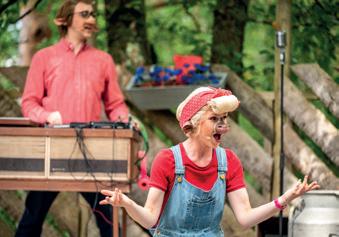
and unforgettable memories are made. The young sailors gain valuable learning and bonding opportunities unlocking hidden strengths and becoming part of something much bigger than themselves. During the sail training adventure, all these young people will be sleeping in hammocks, working, and eating together – all hands on deck,” says Tronstad.
While The Tall Ships Races has been an international tradition since 1956, this will be Kristiansand’s third time hosting the event. The city previously welcomed the race in 2010 and 2015, and aims to be even bigger and better in 2025. Ships come from all over Europe, and beyond –from Mexico to Oman – making the event a truly global affair.
“Being chosen as a host city is an honour, and it brings immense value to our local community. Not only do we get to witness these magnificent ships, but the event also serves as a platform for cultural exchange across the borders,” says assistant project manager Tore Løvland.
A unique experience for all
In 2025, Kristiansand will host a stunning array of ships and also offer rich cultural and artistic experiences. The city’s streets and waterfronts will come alive with music, food, and interactive activities designed to bring the community together.
“One exciting new feature is the midnight concert at Odderøya, where attendees can enjoy world-class music by Sofie Fjellvang and Kristiansand Symphony Orchestra. All while gazing out at the breathtaking views of the southern coastline, the city of Kristiansand, and, weather permitting, even parts of Denmark,” says Løvland.
“The festivities are about more than just the ships; they’re about creating lasting memories for everyone who attends. The night concerts at Odderøya will offer visitors a chance to experience something truly unique – a perfect way to cap off the day’s events.”
There will be events for people of all ages, with ten concerts a day across four stages featuring a range of genres and artists from both Norway and abroad, such as Bjøro Hildebrandt, Arthur Stulien, and Kinsey Rose.
The children’s area will feature a variety of fun and educational family activities where kids can learn about the sea, sailing, paddling, and the environmental impacts faced by the ocean. For children with functional diversities, there will
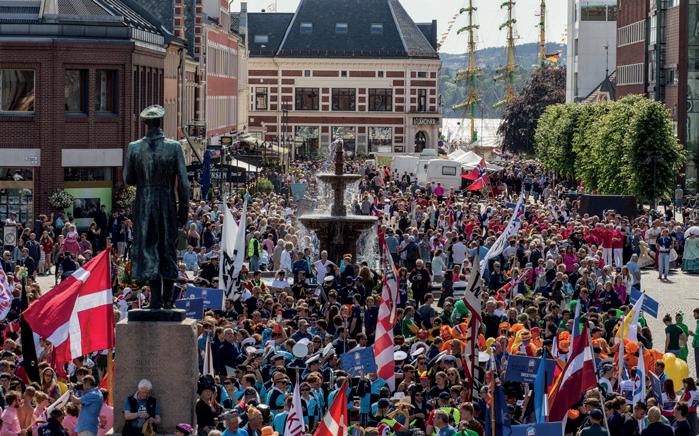
be daily parasailing organised by the Norwegian Association of Disabled.
Of course, the highlight of the event is the stunning Tall Ships Parade, where visitors can witness the sight of over 50 different tall ships sailing out of the harbour.
“There’s something special about watching these majestic ships dock in our harbour, and it’s even more magical to see them sail out again. It’s a connection to our local maritime heritage, international friendships, and a celebration of youth and inclusivity,” says Tronstad. “We’re grateful to all our local partners who make this fabulous event possible.”
The Tall Ships Races Kristiansand will take place from 30 July until 2 August. “We’re delighted to welcome visitors from far

and near to the event of the year!” says Trondstad.
www.tallshipsraceskristiansand.no
Facebook: Tall Ships Races Kristiansand Instagram: @tallshipsraceskristiansand

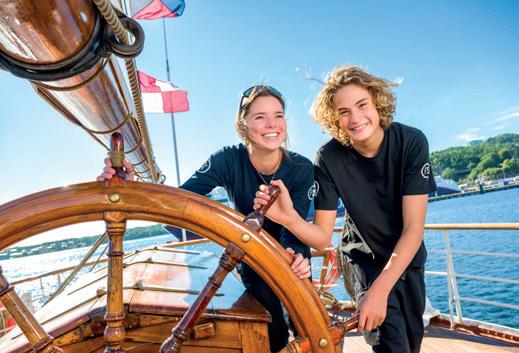



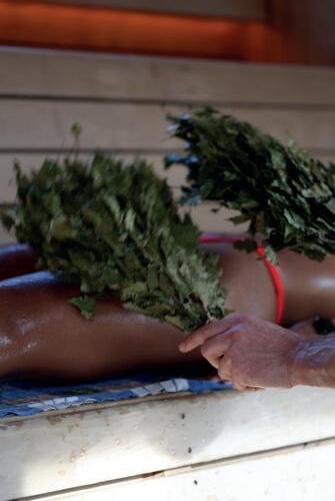
Since opening its doors last year, the floating sauna Blaud has become a roaring success among both locals and visitors in the charming city of Kristiansand. Moored at Odderøya, near the popular Kunstsilo art museum, Blaud combines relaxation and invigorating wellness experiences with breathtaking views.
By Maria Sødal Vole | Photos: Tor André Gjesteland
As Kristiansand’s only floating sauna, Blaud is nestled within beautiful scenery on the city’s tranquil waterfront. The sauna’s sleek wooden interiors and large windows offer fantastic views, making for a warm and inviting space.
Celebrating its first anniversary on 1 June, Blaud has stayed true to its name – Blaud means wet. Guests are invited to enjoy the hot sauna in combination with a bracing dip in the salty waters of Byfjorden in the Skagerrak strait, with a refreshing cold shower available on the float.
An exhilarating experience
The benefits of sea bathing and using a sauna are well-established. Whilst exposure to cold water is known to boost endorphin levels in the body, a sauna session is a natural way to relieve stress and find relaxation.
At Blaud, guests can also enjoy the traditional Aufguss wellness ritual led by the experienced sauna master Pål Rikard Sofus Sævig. With limited availability, the ancient ritual is a multisensory experience involving aromatic oils, hot steam and calming music.
Alongside the mental and physical benefits of saunas and cold-water dips, Blaud builds on principles of social connection. The team believes that facilitating spaces where strangers can meet and connect over a shared experience is invaluable.
“We wanted to build a social sauna, to create an open, airy space with lots of natural light and make it a comfortable and welcoming arena,” says manager Tor André Gjesteland. “We hoped to cultivate an environment where guests can
interact and find it an enjoyable space. I’ve never seen anyone leave in a bad mood – it’s a euphoric experience, and people are usually happy and smiling afterwards!”
Blaud is based on an automated concept where guests can bring their towel, book a preferred time slot online and receive a PIN code for entry to the sauna. It is a seamless process designed to make it as easy as possible to book a session at a convenient time, with opening hours starting at 6.30am for the early birds and ending at 11pm for the night owls.
Along with communal bookings, guests can reserve the entire sauna for private use. The Blaud team is happy to help with any enquiries.
www.blaud.no
Facebook: Blaud
Instagram: @blaud_badstue
TikTok: @blaud_badstue
Discount code for 15 per cent off communal and private sauna: BLAUD5625

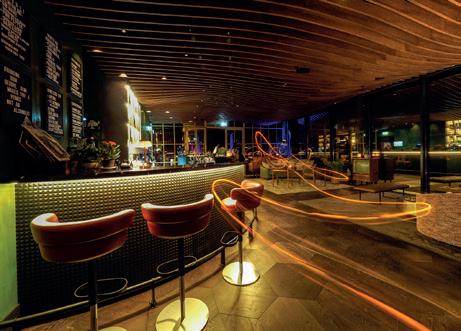

On the 13th floor of the iconic Caledonien Hotel in Kristiansand, a cocktail haven awaits. Club21 is not just a bar with a view, but a year-round place for both locals and visitors to gather, have fun, and enjoy great music.
By Celina Tran | Photos: Marius Jahnsen
Since opening its doors in 2018, Club21 has become a standout on Kristiansand’s hospitality map, not only because it towers over the skyline (in fact, it is among the few exceptions to Kristiansand’s 13-storey building limit, which exists to protect the silhouette of the city’s cathedral), but because it offers an experience unlike any other.
“While this is a bar that specialises in fun and exciting cocktails, Club21 is also a unique social space that offers unparalleled views,” says bar manager Erica Richardsen.
What sets the bar apart in Kristiansand’s nightlife scene is its versatility. On weekdays, it is a lounge ideal for intimate conversations, relaxed business meetings, or solo unwinding. This is the time to dip your toes in the ambitious cocktail
programme, which has everything from timeless classics to daring modern blends. Whatever your poison is, pair it with some funky culinary delights like a brown cheese pizza or a charcuterie board, as well as some live music.

“We’ve had everything from jazz to indiesoul to live pop gigs midweek,” says Richardsen. “Kristiansand has a strong musical undercurrent, and we want to support that by offering more live music experiences throughout the week.”
Come Friday and Saturday, the space is completely transformed. With a make-shift dance floor and a rotating roster of DJs spanning genres, Club21 is essentially turned into a dynamic nightclub. “We want to be a place where everyone feels welcome and can share a sense of connection,” Richardsen says.
Since its establishment, the bar has quickly become a staple in the city’s cultural life, balancing a laid-back charm and a cosmopolitan edge that encourages guests to linger. Whether looking to toast the weekend, try your new favourite drink, or simply soak in the view, Club21 is where Kristiansand comes alive.
www.club21.no
Instagram: @club21caledonien
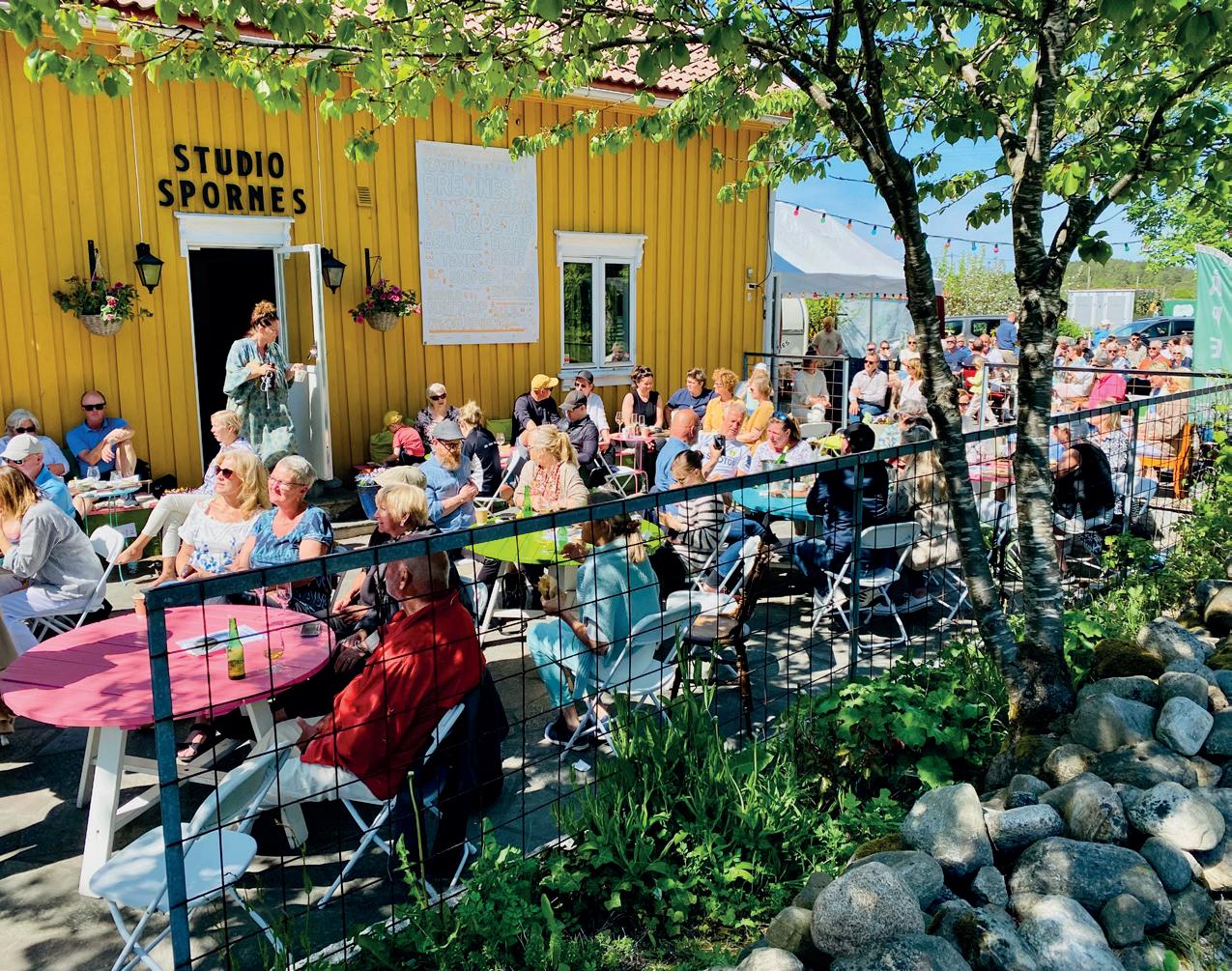
In Arendal, there is a family run business and community driven space where food, music, and nature come together. With two distinct locations and an intimate summer festival to its name, Studio Spornes is redefining what a local cultural hub can be.
By Celina Tran | Photos: Studio Spornes
In the southernmost region of Norway lies a piece of coastal heaven. Arendal, known for its white-painted wooden houses, glittering archipelago, and seaside bliss, is not only the perfect summer getaway, but also home to a family business turned cultural and culinary gem. Founded by Norwegian Jim Stärk drummer Tom Rudi Torjussen, and his wife and sommelier, Mari Dale, Studio Spornes combines nature, intimate cultural experiences and good food and wine.
“We’ve two complementary, yet vastly different locations. Studio Spornes Tromøya is a small café by the sea, while Studio Spornes Tyholmen is a wine bar, bistro, and stage in the heart of Arendal town centre,” says Torjussen.
A homegrown culinary and cultural hub It all started with a house. Not just any house, but a large yellow one on Tromøya, facing directly towards the beautiful Skagerrak. Only a stone's throw away from
Raet National Park, this was the place the couple had dreamed of – rocky outcrops, pebble beaches, crooked pine trees, and that fresh sea air.

“We bought it impulsively when we moved back home from Oslo to Arendal,” says Torjussen. “It’s a large house in the most beautiful surroundings, but it was far too big for just the three of us. We had to fill it with something. Over the years, it has served different purposes, but we knew that we wanted to create a shared space rooted in culture and community.”
Soon enough, Studio Spornes Café opened, quickly becoming a local favourite and a popular stop for local hikers and tourists alike. The café would not only serve delicious pastries, but also evolve to become a space for music and intimate concerts.
“It’s all unfolded naturally from there. We did it on impulse and followed our gut feeling, making changes and adjustments along the way, all in the spirit of creating a space where artists, guests, and café visitors could feel welcome. Many stop by just to taste Mari’s bakery-style cinnamon buns, which have become something of a local legend.”
Still, the couple felt like Arendal was missing a bit of that lively, musical buzz. When the pandemic hit, Mari decided to train as a sommelier. The result was Studio Spornes Tyholmen, a bistro and wine bar in the heart of downtown Arendal, now home to up to 120 events a year.
“We’re Arendal’s largest private culture business, and we have everything from
wine masterclasses to poetry readings and concerts with musicians from all over Norway. There’s always something happening!” says Torjussen.
In addition to the events, Studio Spornes’ curated wine list sets it apart. The selection is built around small producers and rare finds you will not find elsewhere.
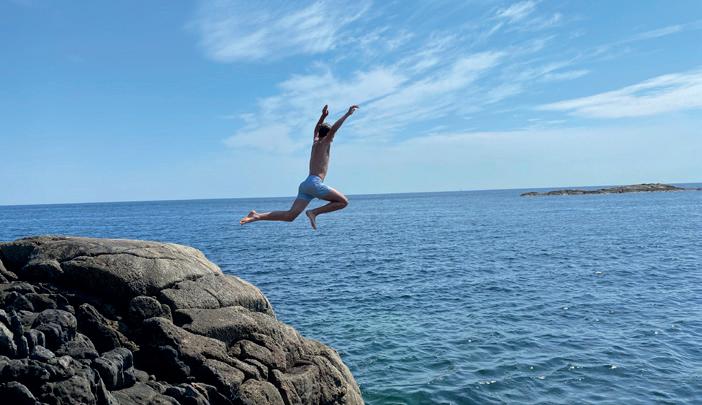
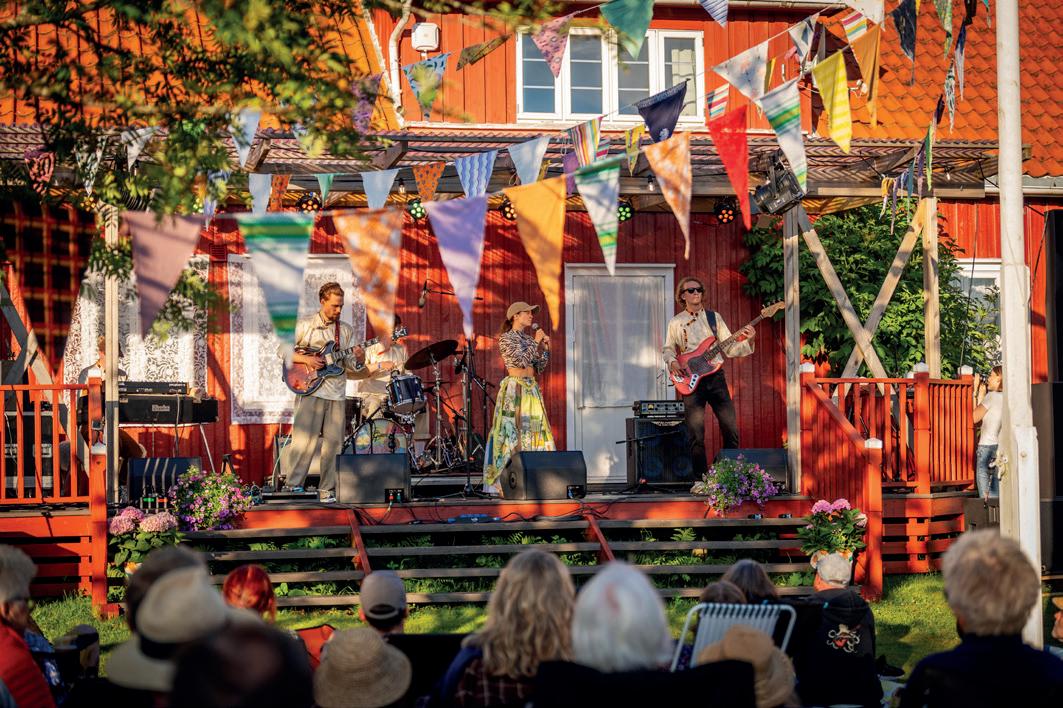
Spornesfestivalen.
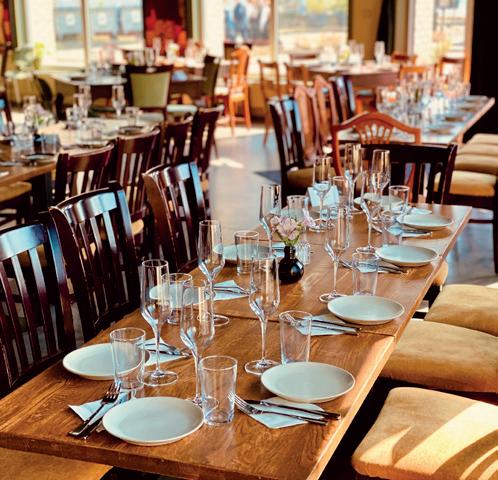

The menu is small and deliberate, featuring dishes inspired by the couple’s travels to Spain and Portugal. Think slowcooked meats, lemony cod with olive oil, and the crowd favourite boeuf bourguignon – all designed to pair seamlessly with the wines.
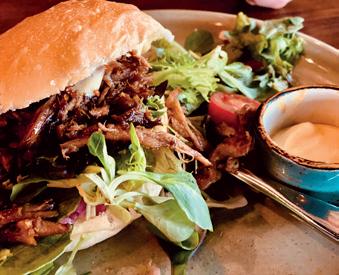
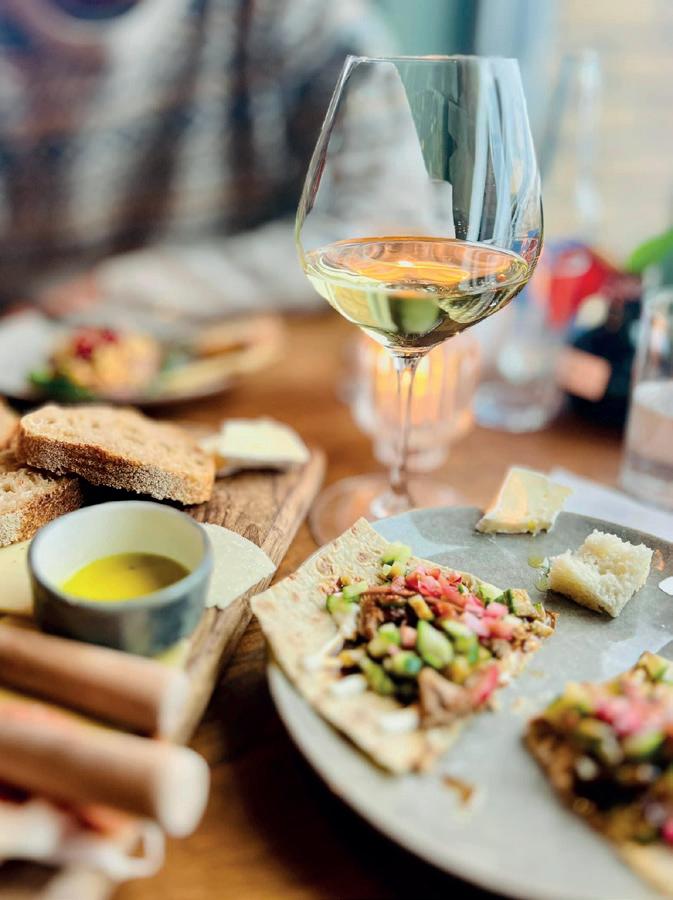
“The wine always comes first, then we build the food around it,” says Torjussen. “We also don’t work with industrial wines or food products. We choose small and family-run producers – people like us, really. It’s about doing things with love and care.”

Sea breeze and sound waves at Spornesfestivalen
Every July, just as the southern Norwegian summer hits its stride, the yellow house on the rugged coast of Tromøya is transformed into a most intimate musical experience: Spornesfestivalen. Unlike larger festivals, Spornesfestivalen is a slow-paced, carefully curated musical weekend with the raw beauty of Skagerrak as its backdrop.
Over the course of three days, festivalgoers can expect a lineup that includes NPTJ rising stars and beloved names from the Norwegian music scene. Previous years have welcomed performers like Sivert Høyem, Jarle Bernhoft, Moddi, and Darling West. This year features

a strong female presence, with performances from talents like Sol Heilo, Josefine Winter, Nora Legrand, and Marthe Wang, as well as a special reunion with Tom’s former band, Jim Stärk.
With limited capacity, a focus on atmosphere and a setting that feels like stepping into a Norwegian postcard, Torjussen describes the festival as an event for people who might have a special interest in music. “It can be difficult to get to the site, but once you make it out here, the experience is different from any other big music event. It’s almost like a secret, cosy festival,” he says.
But it is not just about the music. At Spornesfestivalen, you will eat well, drink well, and feel well. The very same local produce and slow cooking that defines the couple’s bistro and wine bar in Arendal is available for festivalgoers to enjoy. Dishes are cooked on site using regional ingredients and paired with rare, handpicked wines, all served in proper glassware, no plastic in sight.
“We wanted to create something we felt was missing,” Torjussen adds. “A festival that felt like a big garden party where you meet and mingle with the artists.”
In a world of overproduced events and trends, Studio Spornes, its locations and festival offer something refreshingly human. It is built on gut instinct, handcrafted details, and a shared belief that even small things can leave a big impact.
www.studiospornes.no
www.spornesfestivalen.no
Facebook: Studio Spornes
Instagram: @s.p.o.r.n.e.s
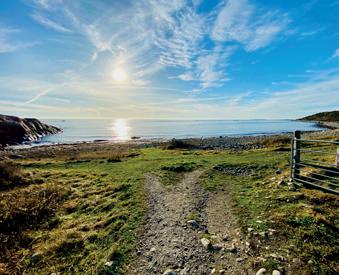


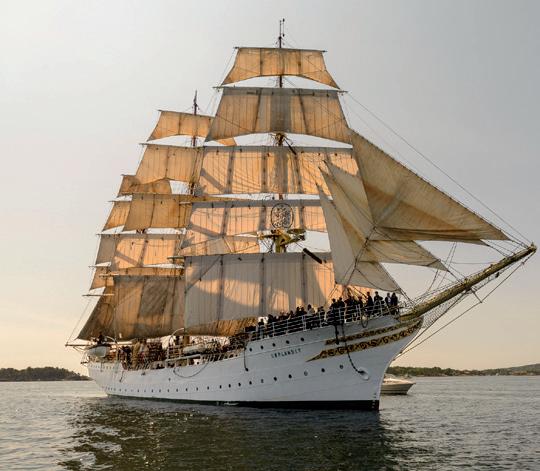


In the heart of Kristiansand’s proud maritime tradition, a white-hulled beauty continues to defy time. Fullriggeren Sørlandet, a floating symbol of Norwegian heritage, is more than just a ship; it is an experience, a school, a sanctuary, and, for those lucky enough to come aboard, a life-altering voyage.
By Celina Tran
Sørlandet was built as a training ship in 1927, and is still fulfilling that role nearly 100 years later, even though what it means to be a training ship has changed.
Built at yard number one in Kristiansand, Sørlandet has been home to over 10,000 young learners since her maiden voyage, and today she is home to an international high school program, A+ World Academy, a floating classroom for students in 11th and 12th grade. Each year, 72 students come aboard not only to study, but to live and work as crew members.

“They sleep, eat, learn and live in a shared space. It’s more than just an education. You spend ten months living in close quarters with 85 people from all over the world, it changes you. You carry that experience for life,” says Knut Arne Gjertsen, administrative director.
The school year spans ten months and includes visits to 15–20 ports across four continents. From climbing the rigging high above the Atlantic to holding lookout duty under starlit skies, every student becomes part of the ship's heartbeat.
Sailing with a purpose
After nearly a century, Fullriggeren Sørlandet Foundation continues its mission to preserve and operate Sørlandet through active use for education, but also to promote interest in traditional Norwegian sailing culture. While the student voyages are at the core of Sørlandet’s mission, the ship’s decks are open to many more. In summer months and
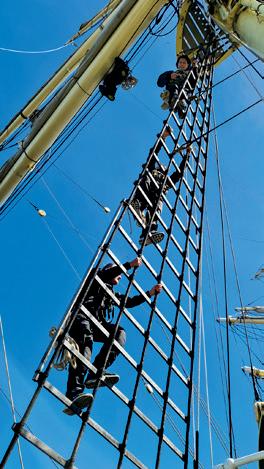
between academic journeys, the ship transforms into a platform for customised experiences.
“It’s available for everything from corporate team-building cruises to university-led educational voyages, and from intimate anniversaries to large social events,” says Gjertsen. “This year we’ll be participating in the Tall Ships Races too!”
A customisable experience, guests can (literally) try their hand at the ropes or simply kick back, look out on the glittering sea, and enjoy a fine dinner on deck.
As the centennial milestone approaches, the foundation prepares a special celebration. After all, it is not every day that the world’s oldest sailing full-rigged ship turns 100! From her iconic 1933 Atlantic crossing to Chicago to her revolutionary inclusion of female cadets in 1980, Sørlandet has often been ahead of her time. “It will be a loud and fun celebration of our maritime and national story,” adds Gjertsen.
www.fullriggeren.no
www.aplusworldacademy.com
Facebook: Fullriggeren Sørlandet
Instagram: @fullriggerensorlandet
By Maria Sødal Vole | Photos: Kristiansand Feriesenter
With a history dating back to the 1960s, Kristiansand Feriesenter is nestled in a picturesque spot within Kristiansand’s scenic archipelago. A perfect destination for summer adventures, Kristiansand is also home to Dyreparken Zoo – the most visited family attraction in the country –and the popular water park Aquarama.
Kristiansand Feriesenter offers a well-situated base for exploring everything the area has to offer. The team is dedicated to planning an exciting summer programme and a wide variety of activities for the whole family, with fun new additions every year.
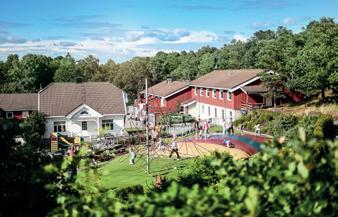
memories,” says manager Kristin Oterholt Vårdal. “We’re happy and grateful to have guests who return again and again.”
The holiday park has plenty of accommodation options to choose from, and top-notch amenities ensure that guests have everything they need for a pleasant stay. “There’s certainly something for everyone – ranging from a spacious
“Our goal is to be kids’ favourite destination, a place where families can enjoy quality time together and create unforgettable Kristiansand Feriesenter is the ideal base for a memorable summer getaway. Located in the beautiful city of Kristiansand, this holiday park is known as a fun-filled family destination surrounded by the idyllic surroundings of Norway’s south coast.
camping site and affordable motel rooms to fully equipped, modern apartments and charming cabins overlooking the water,” says Oterholt Vårdal.
As a Green Key certified destination, Kristiansand Feriesenter is committed to eco-friendly practices. The team aims to provide big experiences while keeping the environmental impact small – sharing the simple joy of quality time together is at the heart of what they do.
www.krsferiesenter.no
Facebook: Kristiansandferiesenter
Instagram: @kristiansandferiesenter

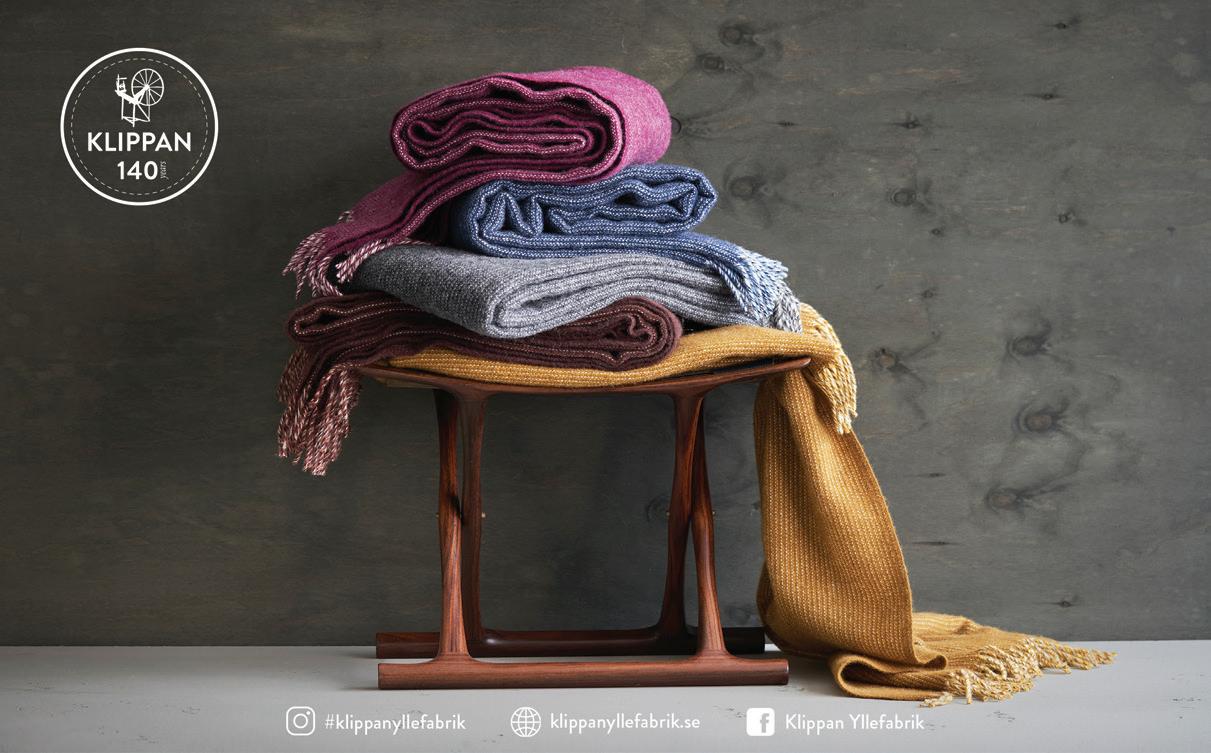

In the Arctic archipelago of Svalbard, where glaciers frame the horizon and the midnight sun hangs high above the mountains in June, one sports club has long brought together people through endurance, community, and a love of the polar landscape. Once again, Svalbard Turn is hosting its annual Spitsbergen Marathon – a race like no other, held on the edge of the world.
By Celina Tran | Photos: Spitsbergen Marathon
The story of Svalbard Turn stretches back nearly a century. While sports were practised informally in Longyearbyen as early as the 1910s, it was not until 1930 that Svalbard Turn was officially founded. It emerged out of a need for community, camaraderie, and healthy recreation among the mining town's early residents – many of whom endured long, dark winters and intense physical labour deep underground.
“Svalbard Turn is a sports club that provides diverse sports activities for our community,” says general manager Elisabeth Leinan Johannessen.

Early on, the club focused on disciplines such as gymnastics, shooting, and skiing, with notable figures like Joakim Lindholm and Einar Sverdrup championing its development. Backed by the mining company Store Norske, which understood the value of physical well-being for its workers, Svalbard Turn quickly became central to life in Longyearbyen.
From its humble beginnings in gathering places like Gammelfæmma to its current home in Svalbardhallen, the club has grown alongside the town. Today, it offers everything from football and volleyball to climbing, swimming, miniature shooting, and chess – even launching a new alpine ski slope in 2024. But perhaps nowhere is its spirit of community and challenge more evident than during the summertime signature event.

The world’s northernmost running adventure
Spitsbergen Marathon was first organised in 1994, and over the past three decades, it has become one of Svalbard

Turn’s most beloved and high-profile events. Held in early June, when the archipelago is bathed in 24-hour daylight, the race invites participants to run through open tundra, along fjords and past reindeer, seabirds, and stunning Arctic views – all under the surreal glow of the midnight sun.
“It’s with great joy that we at Svalbard Turn can welcome both visitors and locals to what we believe is the world's most beautiful running adventure here on Svalbard,” says Johannessen. “This is more than just a marathon. It’s a celebration of life in the Arctic.”
Despite Svalbard’s intimidating reputation, early summer conditions are surprisingly welcoming. Temperatures are usually above freezing, the snow has largely

melted, and the route – though tough – is well maintained and undeniably beautiful. The course winds along the roads in and around Longyearbyen, giving runners an immersive taste of the wild and wonderful north.
The start and finish line is at Svalbardhallen, the club’s bustling modern sports facility. Participants are encouraged to arrive early and soak in the atmosphere – and perhaps even spot an Arctic fox or reindeer along the way.
“Our goal has always been to encourage a healthy lifestyle for everyone,” Johannessen explains. “From young children trying out sports for the first time to seasoned athletes testing their limits, we want to be a space where people can come together and thrive.”
Events like Spitsbergen Marathon bring this mission to life – inviting runners, volunteers, and spectators to share a moment of Arctic magic. And if you are feeling nervous about the wildlife, do not fret, there will be polar bear guards on site!
Whether chasing a personal best or a once-in-a-lifetime experience, Spitsbergen Marathon offers both – with a view that truly takes your breath away. So pack your running shoes, look to the endless daylight, and join the community at Svalbard Turn for a race at the top of the world.
www.svalbardturn.no www.spitsbergenmarathon.no

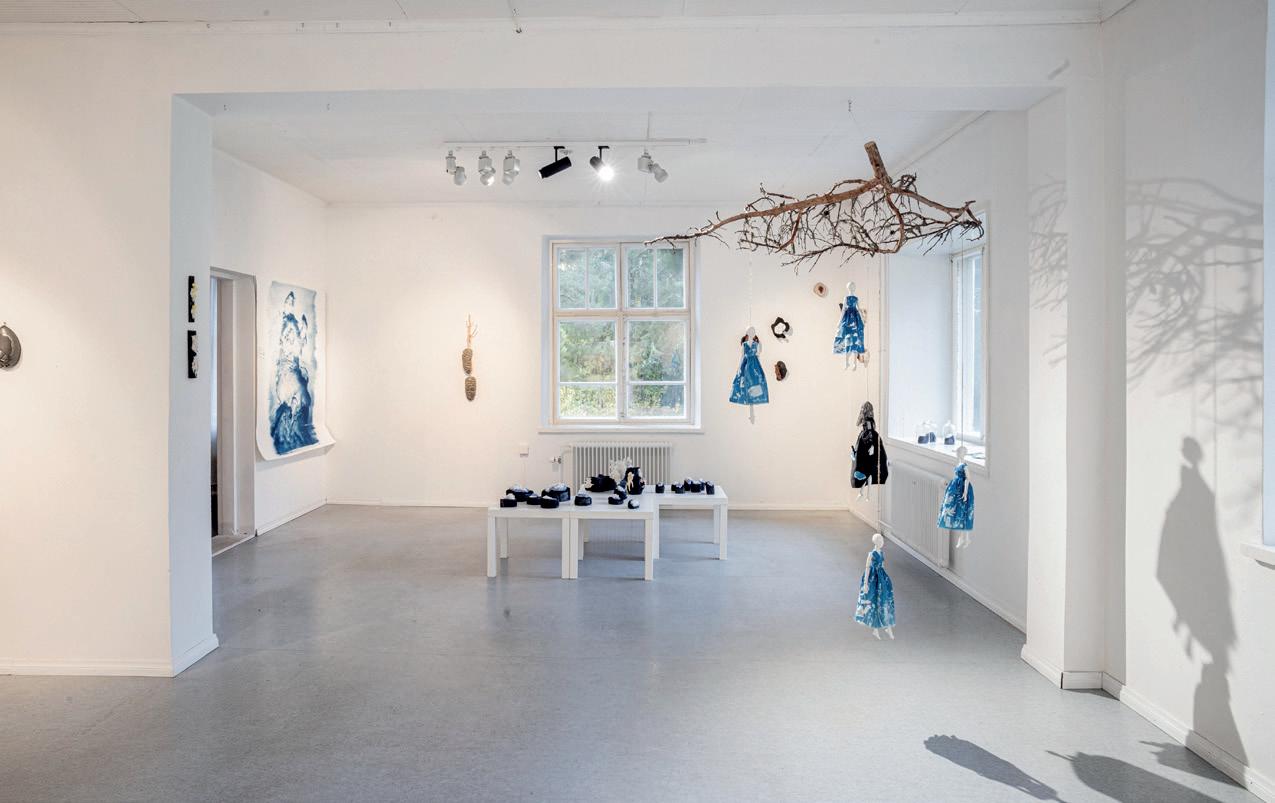
Kubu has given a new lease of life to a historic school, turning it into a vibrant cultural space that draws visitors from across Finland and beyond.
Kulturhus Björkboda – or Kubu – has become a vibrant cultural and communal space on the picturesque island of Kimitoön, off Finland’s southwestern coast. Housed in a 110-year-old school building, Kubu serves as a meeting place where people and culture intertwine, fostering creativity, sustainability and hands-on learning.
By Ndéla Faye | Photos: Kulturhus Björkboda
The island, already a magnet for nature and culture enthusiasts, gained a new addition to its cultural landscape in 2022. Kubu was founded by Sari Kippilä and her husband, Tuomo Tammenpää, today, known as ‘Kubu-mama and Kubupapa’. They saw potential in the old school building and decided to breathe new life into it. The result is an artistled, independent cultural hub, deeply rooted in the principles of community participation and lifelong learning.
Celebrating the island’s 700th anniversary
This summer marks Kimitoön’s 700th anniversary, and Kubu is proudly contributing to the celebrations with a 12-week cultural programme from 5
June to 31 August, themed Earth (soil). The theme will run throughout the year, but during the summer, two major exhibitions will take over the entire
Kubu space, from the yard to the attic. The Garden and the Hedge, curated by Irish-born artist and professor Teresa Dillon, explores the delicate relationship between cultivated and wild landscapes. Meanwhile, Piha, Pyhä, Metsä, Maa, curated by photographer and Norpas festival co-founder Ritva Kovalainen, delves into the sacredness of nature and the urgency of environmental conservation.
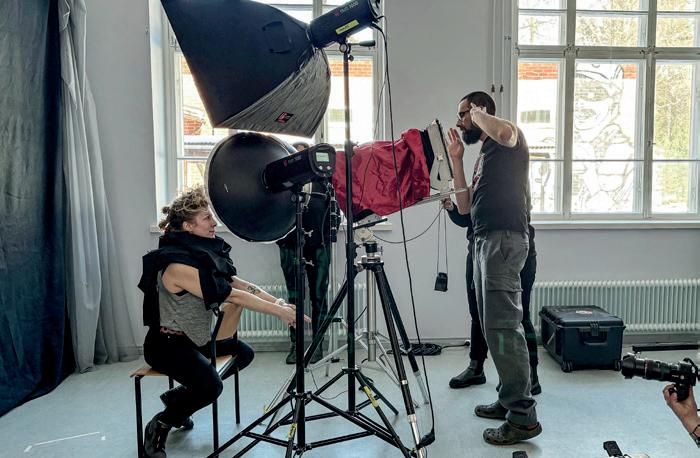

Workshops and interactive sessions will focus on biodiversity and soil health, offering hands-on opportunities to learn about ecological balance. Kubu’s ethos is about equipping people with practical skills, from building a community greenhouse together to fermentation and natural dyeing, to exploring soil with self-made microscopes. True to the island’s bilingual roots, Kubu ensures accessibility by offering exhibitions and workshops in Finnish, Swedish and English. Visitors can book their place to workshop on the Kubu website.
Before Kubu, Kimitoön lacked dedicated gallery spaces. Now, thanks to its presence, the island boasts three exhibition areas showcasing a range of visual arts, sculptures and installations. These spaces double as venues for events and creative workshops, reinforcing Kubu’s role as an important cultural hub.
Culture is doing things together
Managed by a non-profit cooperative, Kubu operates with a commitment to shared governance and participatory
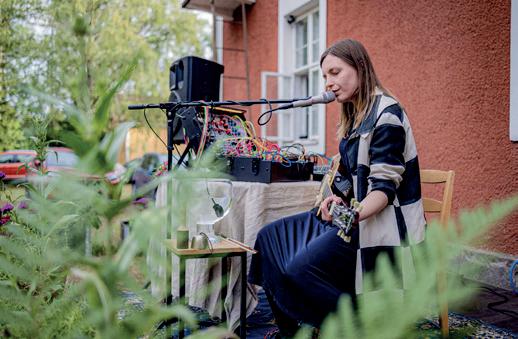
decision-making. The building itself has been preserved in its original form, with classrooms, a gymnasium, a kitchen, and communal spaces left intact, allowing for a seamless blend of history and modern creativity. The space now hosts a craft shop, rotating exhibitions, a hall with a stage and a pop-up café, alongside meeting rooms and collaboration areas.
At its core, Kubu is about unlearning –challenging conventional notions of education and culture. “We want to honour the building’s history and let it continue to serve as a space for lifelong learning. Culture isn’t just about art, it’s about everything people create and experience together,” says Kubu co-founder Tuomo Tammenpää.
Kubu has quickly positioned itself as a key player in Finland’s arts and culture scene. Its collaboration with the Norpas festival, known for an eclectic mix of music, performance, visual arts, circus and film, has further solidified its reputation. Through this partnership, Kubu has
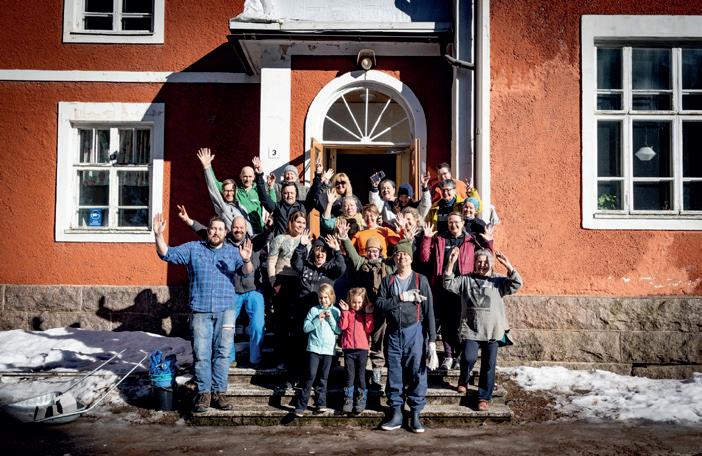
expanded Norpas’ programme, providing a broader platform for workshops, debates and artistic experimentation.
Sustainability is at the heart of Kubu’s mission. The cooperative takes climate challenges seriously, actively engaging in discussions on biodiversity and waste reduction. “Upcycling is evident in almost everything we do. Waste isn’t waste to us – it’s a resource that can be repurposed and reimagined,” Kubu’s co-founder Sari Kippilä explains.
Kubu’s exhibition programme welcomes both professional and emerging artists who push boundaries and think outside the box. With a focus on site-specific projects and community participation, Kubu ensures that no two visits are quite the same.
Kubu has transformed a historic school into a living, breathing cultural space that draws visitors from Finland and beyond. More than just a venue, this is a place of connection, where creativity, sustainability and communal spirit come together. “Visitors are not merely spectators. Everyone who steps through our doors has the opportunity to participate, in whatever way they choose,” Kippilä concludes.
www.kubu.fi
Instagram: @kulturhus_kubu
Facebook: kulturhuskubu
5 June: Grand opening
13 to 15 June: Synth Camp
1 to 3 August: Norpas Festival
29 to 31 August: Closing & Harvest Festival

During the summer months, many travellers traditionally head for the Mediterranean. In recent years, however, uncomfortable heat has pushed some to look for more temperate locations. With long, light days, mild temperatures and a relaxed atmosphere, Finland is an ideal alternative. Turku, the country’s oldest cultural centre and new culinary capital, welcomes visitors to explore Ruissalo Island, the gateway to Turku’s archipelago of over 40,000 islands, offering the perfect combination for a Nordic holiday: proximity to a vibrant city mixed with the calm pleasure of Island life.
By Molly McPharlin
Ruissalo Island is Turku’s urban park, a magnificent green oasis just off the coast of the city. In summer, Ruissalo is a wonderful location to enjoy the outdoors. The temperature stays in the 20s with occasional spikes to 30. The days are long, with spring in April and May transforming into summer weather that remains well into September. “It’s easy to breathe in the warm sea wind,” says Sanna Suomi, part of the destination development team of Ruissalo. “From the end of June and the midsummer holiday, the evenings are so light that you can read a book all night without a light on.”
Much of life in Ruissalo revolves around the sea. At Ruissalon Telakka, or the Old Shipyard, people sailing by can moor in
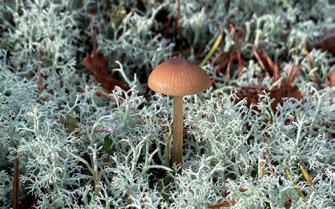
the guest marina, view the large fleet of classic boats on display and enjoy local restaurants such as Zaké Pizzeria & Wine Bar and Tenlén BBQ and Smokery. “The marina is a boating gem located between the Aura River and the archipelago,” says Suomi. “Thousands of boats were built there between 1889 and 1954. But now it’s also a great setting for a party and offers the chance to enjoy leisure time by the sea.” Traditionally specialising in wooden boats, visitors can book a historical tour with Jani Vahto, a local wooden boat aficionado. His Instagram page Classic Boats Finland is followed by over 100,000 people all over the world.
Turun Pursiseura, the Sailing Club of Turku, is also located in Ruissalo. Formed in 1906, this is the oldest sailing club in the region. Situated in the middle of the island, it is within easy reach of the restaurant Alex 1917, housed in what was between 1927 and 1938 the first civil aviation terminal in Finland for
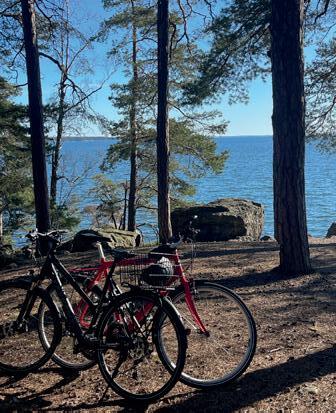
seaplanes. Restaurant Alex focuses on fresh seafood, produce from local farms, combining Nordic cuisine with a touch of Mauritian flavours, found in their curries and tamarind sauce.
Experience a Finnish spa or camping
For those looking for comfortable accommodation, the recently renovated Ruissalo Spa Hotel is located by the water in the Ruissalo Marina. The hotel oversees the marina and all its services, from spa treatments to its popular restaurant Loisto, are available to people travelling by boat. For those wishing to use Ruissalo as their homebase while visiting the popular Moominworld in Naantali (also near Turku) in summer, there is a new private water bus leaving from the city with stops at both Saaronniemi, the farthest tip of Ruissalo, and Naantali.
Ruissalo also has an ideal environment for camping. Combining a peaceful location with the convenience of a metropolitan area, the island provides excellent
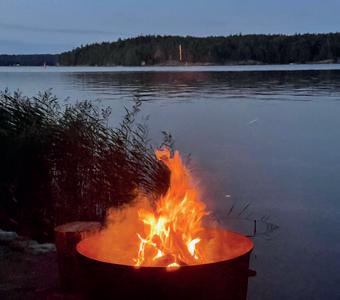
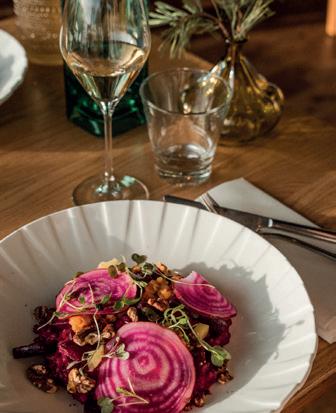
camping facilities with the fun of the city nearby. For those travellers interested in experiencing Finnish foraging, the island holds a forest rich in berries and mushrooms. Finland follows the legal concept of ‘Everyman’s Right’. This means that it is universally acceptable for anyone to collect wild food and enjoy the outdoors, as long as they do not damage or disturb the land. Just make sure to know what varieties are safe to eat.
Two places to stock up on local foods before heading off to camp is the large and varied outdoor famer’s market and the Market Hall in Turku. Stalls and shops offer a wide variety of delicacies. The hall itself is a cultural landmark, the second-oldest market building in Finland. First opened in 1896, it is well worth a visit.
In July, Ruissalo hosts the popular Ruisrock festival, one of the oldest musical festivals in Finland. Other cultural events can be found in the island’s two theatres.

For outdoor fun, the island is popular for swimming, sauna, golf, beaches, and the University of Turku’s botanic gardens. While exploring the environment and Ruissalo’s 20 kilometres of nature trails, visitors should stop by for lunch, coffee and cake at Villa Kuuva, a café housed in one of the island’s famed wooden villas. Guests can relax, enjoy seasonal cooking, and admire the original interiors and glass windows with views of the Baltic Sea.
“Whether you’re hoping to enjoy a relaxing holiday or have some new adventures and experiences, there’s space in Ruissalo for it all,” says Suomi. “Also, you can just sit and enjoy the summer sky. In my opinion, late summer evenings are the most beautiful, still warm but beginning to get dark, and you can see millions of stars in the sky.”
More about Ruissalo: www.visitruissalo.fi
More about Saaristo, Turku’s archipelago: www.saaristo.fi
Instagram: @saaristo_finland, @visitturku
Facebook: Visit Turku
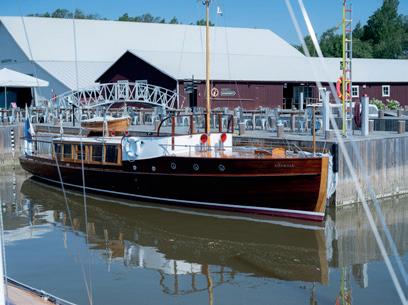
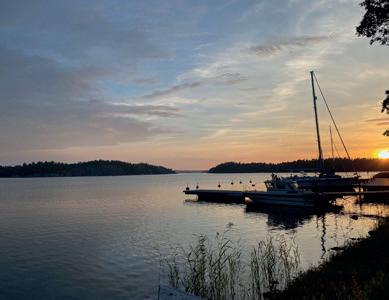
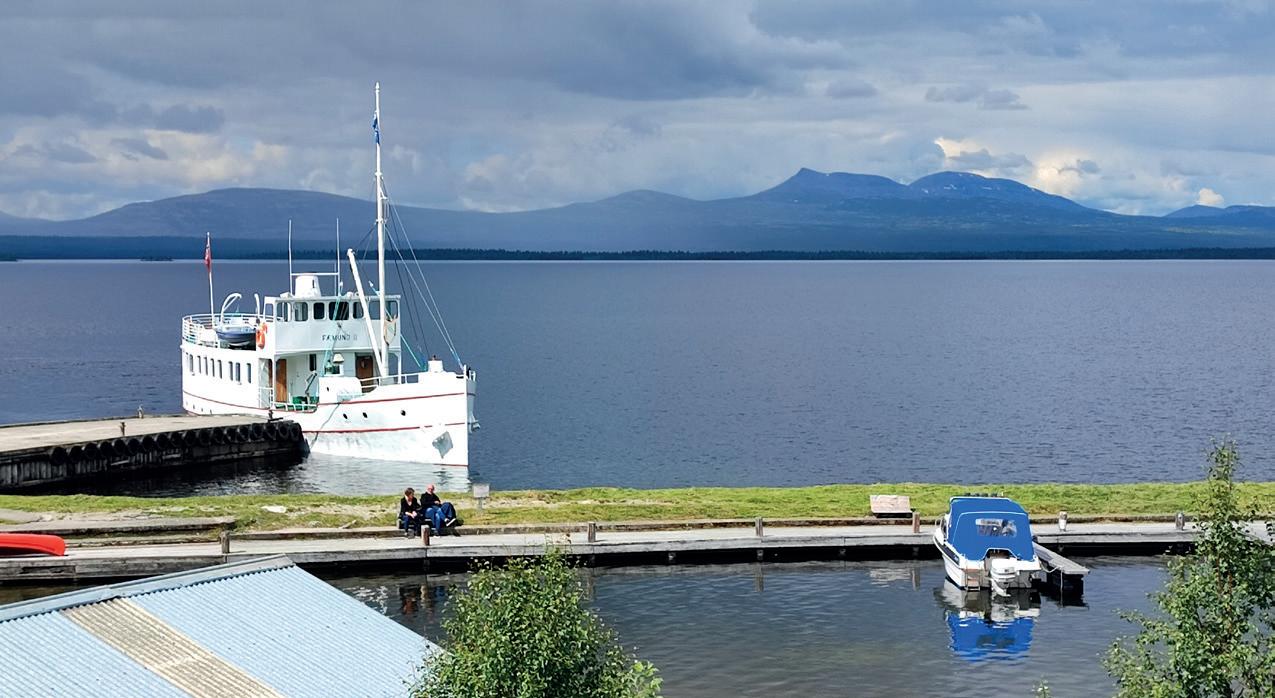
Famed for its dramatic fjords and iconic hiking routes, Norway still hides a few secrets. One of them lies in the heart of the country’s southeastern wilderness: Lake Femunden and its surrounding national park. Here, in an untouched landscape far from the Instagram crowds, Norwegians themselves go to escape. At the centre of it all, the historic MS Fæmund II continues to glide across the lake, just as it has done since 1905. This is the authentic Norway – quiet, raw, and real.
By Signe Hansen | Photos: Noor de Laat
MS Fæmund II is not just a vessel, it’s a time capsule. Built in 1905 and still operating with many of its original components, the boat has transitioned from an industrial lifeline carrying timber and goods across Femunden, Norway’s second largest lake, to a peaceful ferry carrying hikers, anglers, and nature lovers into the wilderness.
“It’s not a crowded experience here,” says Svend-Andreas Schie, captain on Fæmund II. “Most of our passengers are Norwegians, and the route has been kind of their secret. You come here to get away
from the noise – not to stand in line behind busloads of tourists. It’s the real deal.”
While international visitors often head to the Lofoten Islands or the west-

ern fjords, the Femund region lies just outside the spotlight – yet its appeal lies exactly in its secret splendour. Departing from Synnervika, MS Fæmund II criss-crosses the lake, delivering guests into Femundsmarka National Park, a pristine expanse of forest, mountain, and open sky. There are no curated experiences here, no fences or food stalls – just nature, as it has always been.
Norway’s backyard escape
The Femund region is sometimes referred to as “the backyard of Norway,” not because it is secondary but because it feels like home, especially for those who know where to look.
“This is an area where you don’t need a guide to point out the view,” says Schie. “We just bring people into nature. After that, they do what they want; hike, fish, find a quiet cabin, or just breathe.”
Indeed, the region is laced with trails and dotted with both serviced and unstaffed cabins, many of them open to hikers for free or at minimal cost (the cabins, known as hytter, can be found and booked through dnt.no). Locals make use of them for weekend adventures, often combining a boat ride on Fæmund II with a hike between cabins or a few days fishing for trout and whitefish.
Passengers often disembark at Røa, a popular entry point into the national park, or continue to Elgå, a small lakeside village where reindeer wander between houses and the pace of life slows to a near stop. The boat stops in six locations before returning and making the same stops back.
While most people use the boat to access the untouched nature of the area, some also choose to do a day trip around the 60-kilometre-long lake. Once a week, the trip is extended with a small cruise to Buvika, and guests are joined by a guide who provides insights, a great way to enjoy the area for those inexperienced with hiking.
Onboard the boat, passengers can enjoy a nostalgic journey which, despite upgrades, retains much of its original charm. The wooden interior and metal fittings remain largely untouched, offering a sense of place and history. The rhythmic hum of the engine and the gentle sway of the boat create a meditative atmosphere, allowing

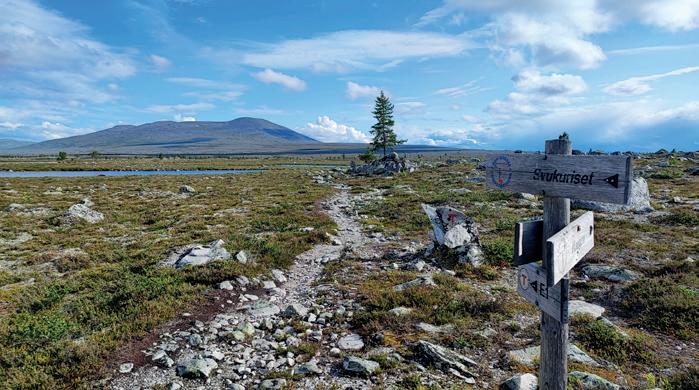
here is untouched. You can get off the boat, walk into the forest, and be completely alone.
“We sail the same route that we’ve sailed for over a hundred years,” Schie explains. “And when you’re on board, you really feel that. You hear the old engine, and you feel the vibration on the floor. It’s part of the experience.”
Onboard MS Fæmund II, a small café offers local delicacies such as smoked sik, traditional cured meats, cheeses, and Fæmund Pils, a locally brewed beer named after the boat itself. However, passengers are also welcome to bring their own food, and many do – enjoying a packed lunch on deck with nothing but water, sky, and fells in sight.
“The boat connects people with nature,” says Schie. “And, the nature we have
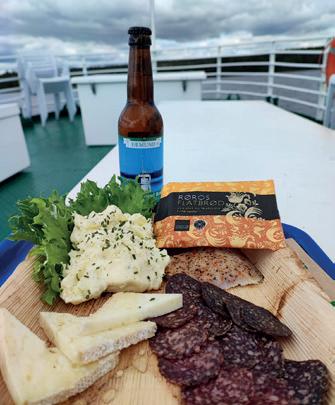
For international travellers looking for an authentic experience far from the beaten track, Femund offers exactly that – a chance to explore Norway not through postcards or travel ads, but on the ground (and water), the way locals do.
“I think that’s what makes this place special,” Schie says. “It hasn’t been made for tourists. It’s still just nature. And the boat, well, it brings you there.”
About Fæmundruta
• M/S Fæmund II has been in operation since 1905.
• It connects six charming locations along Lake Femunden, Norway’s third-largest lake.
• The route offers easy access to the wild landscapes of Femundsmarka National Park.
• Season: summer months (June to September).
• The boat departs from Synnervika at 9am and returns at 3pm, Monday through Friday and Sunday.
• On Saturdays, the boat offers a mini cruise to Buvika, returning at 5.15pm.
To check the full schedule and book tickets online, visit: femund.no For questions, contact: marked@femund.no













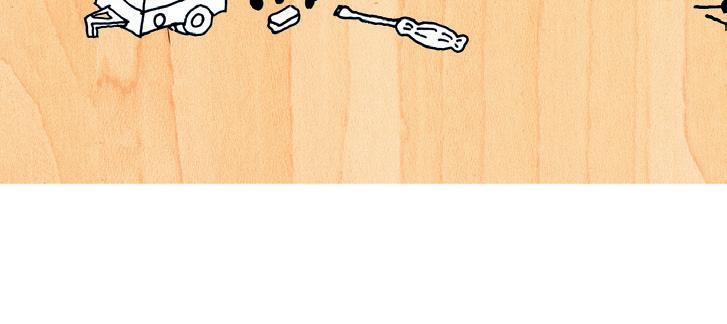



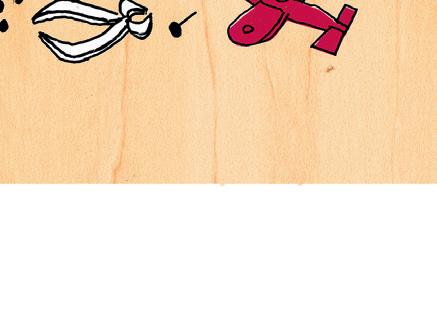
Aquascape Inc. is the world’s largest manufacturer of pond supplies – and the only one to offer one-of-a-kind, custom-built water feature constructions. This has led to 30 years of product design and a global network of over 600 certified Aquascape contractors. Aquascape Norge is both an Aquascape CAC and a Scandinavian distributor.
By Maria Sødal Vole | Photos: Aquascape Inc.
Aquascape Norge delivers ponds, recreational swim ponds, fountains, Pondless Waterfalls® and storm and rainwater solutions, all with an ecosystem approach.
It is well documented that proximity to water reduces stress and promotes mental and physical well-being. Aquascape’s varied features are always designed to blend seamlessly with existing or newly created landscapes, connecting people with nature right outside their own window.
“Acting with Mother Nature, instead of against her, helps create naturally balanced, low-maintenance and beautiful features that also promote biodiversity. We don’t recommend that homeowners
or non-CAC landscapers attempt to build these themselves,” says Joachim Fjeld, manager at Aquascape Norge.
While Aquascape Norge’s Ecosystem fishponds are popular, more customers are looking into recreational swimming ponds. “A lot of people dream of an outdoor
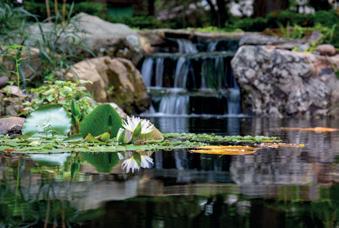
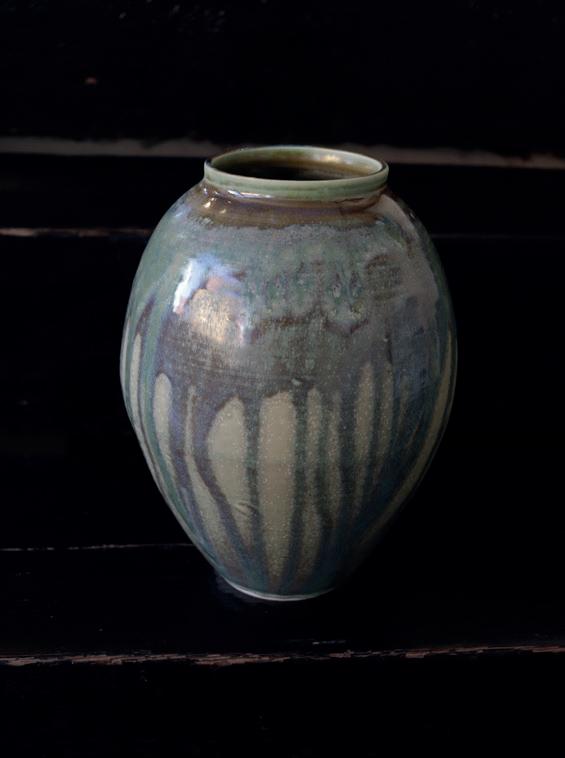
www.cosytimesceramics.dk
Instagram: @cosytimesceramics.kerteminde
swimming pool, but they are expensive to heat and require a lot of upkeep. This is often a dealbreaker, considering the few days of the year they would be used,” Fjeld explains. “Swim ponds are a fantastic alternative; they’re much more attractive to be around than a pool, regardless of the season!”
www.aquascape-rogaland.no
Facebook: Aquascape Norge AS Instagram: @aquascape_norge_as YouTube: Aquascape Norge Aquascape Inc: www.aquascapeinc.com


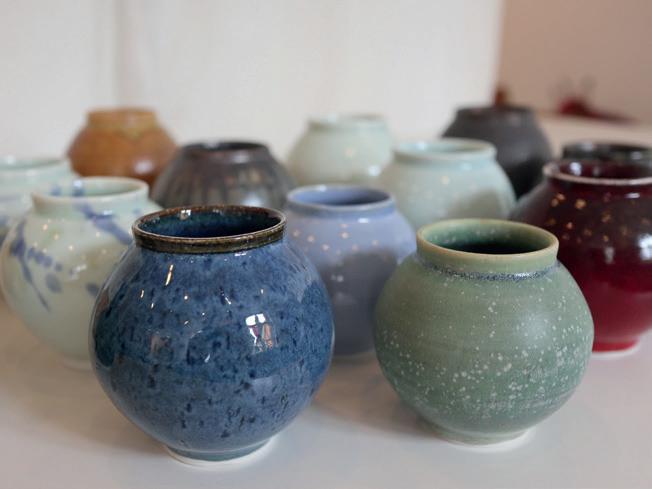
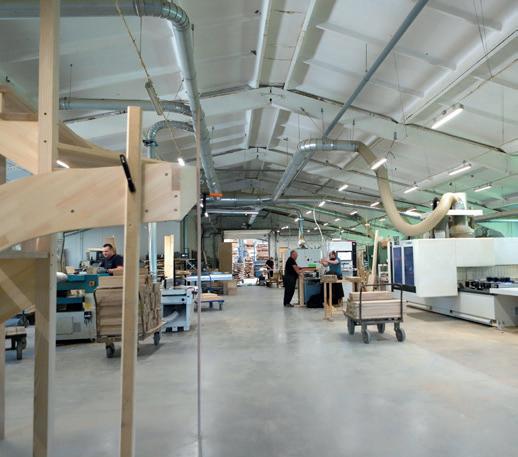

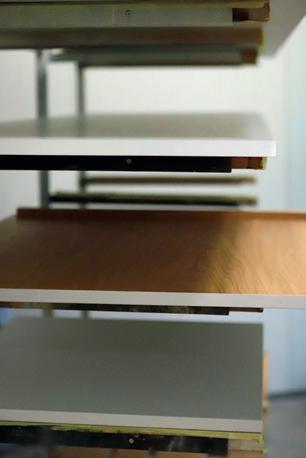
Antvita is a small woodworking factory, known for its impeccable craftsmanship, precision, and passion for all things wood. This family-run business is redefining what it means to invest in bespoke quality furniture.
By Ndéla Faye | Photos: ErikaMaja Photography
Antvita’s factory is located in Lithuania, and with a team made up of expert carpenters, it offers a full-scale service –from sketch to shipping. The company’s flexible approach means that they can work from scratch or bring a customer’s own drawings to life. “Whether it’s a large-scale production run for a design company or a custom kitchen unit tailored to a private client’s home, no project is too small or too ambitious,” says Justina Pariokaitė, the owner’s daughter, who is managing all customer orders.
From its workshop in Lithuania, Antvita provides fast international shipping throughout Europe, delivering bespoke wooden pieces to satisfied customers across the continent.
At the heart of this family-owned business stands Vytautas Pariokas, Antvita’s founder. A master carpenter with over three decades of hands-on experience. His deep knowledge of woodcraft and
meticulous attention to detail have laid the foundation for the company’s success. As the visionary behind the operation, Pariokas combines traditional techniques and a forward-thinking approach to production, ensuring that each piece is not only expertly made, but thoughtfully designed to last a lifetime.
Antvita initially built a reputation for its exceptional log cabins, carving out a niche in the industry through dedication to quality and craftsmanship. Over the years, however, the company has evolved, expanding its operations to include a state-of-the-art woodworking factory.
What sets the company apart is the combination of skilled artisanship with the use of advanced woodworking machinery. This modern edge allows for efficient, high-quality production, ensuring that each piece meets rigorous standards without compromising on detail or durability. “Our modern machinery also enables us to efficiently process large
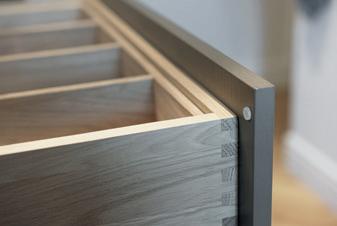
bulk orders, so that we can accommodate all types of requests,” says Pariokaitė.
“Wooden products are timeless and built to last through generations. They’re a sustainable choice, and there’s something special about owning a handmade piece, full of creativity and designed to last,” Pariokaitė concludes.
www.antvita.com
Facebook: Antvita

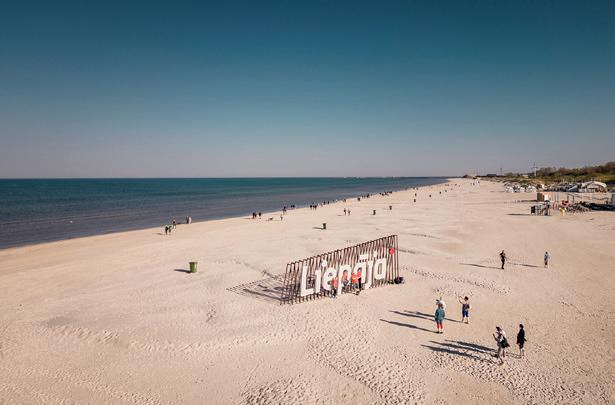
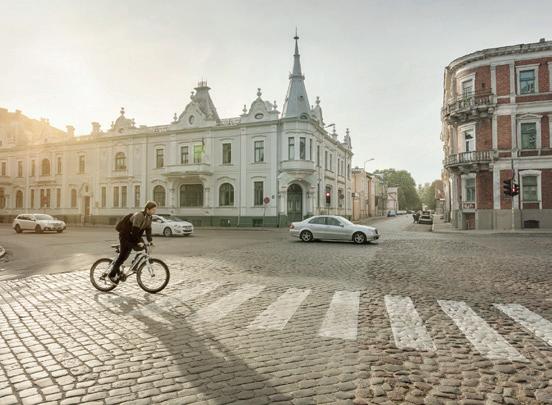
Nestled between Lake Liepāja and the Baltic Sea, the vibrant city of Liepāja is fast becoming one of Eastern Europe's most inspiring summer destinations. Already beloved for its long, white-sand beaches, rich musical traditions, and striking architecture, the city is taking things up a notch as it prepares to be the European Capital of Culture in 2027.
By Signe Hansen | Photos: liepaja Travel
When deciding to grant Liepāja the status of European Capital of Culture in 2027, the European Union’s evaluation jury highlighted the city’s compelling vision for the future. "The concept of the Liepāja bid speaks into a new reality in Europe where cultural competences must play an even bigger role in seeking solutions to societal 'rest and unrest'," the jury noted. This commitment to culture as a force for community and renewal is what makes a visit to Liepāja not just enjoyable, but inspiring.
In summer, the city and its surroundings offer a perfect mix of nature, relaxation and adventure. You may spend a day basking on the famously pristine Blue Flag beach or stroll through the city’s charming streets lined with beautifully restored Art Nouveau and wooden buildings. Music lovers, too, will find themselves at home in the city known as the birthplace of Latvian rock music, with live performances filling the air with music during the long, light evenings.
For those seeking something out of the ordinary, Karosta, the city’s former secret military town, offers fascinating experiences, with its dramatic sea fortifications and haunting Northern Forts.
As Liepāja prepares for its year as the European Capital of Culture, visitors can
already feel the creative energy building in its galleries, festivals, and public spaces. The city is home to Latvia’s oldest professional theatre, the country's only professional symphony orchestra outside of Riga, a puppet theatre, several folklore groups, and – not least – a seemingly endless number of choirs.
Whether you come for the beach, the music, the history, or the emerging cultural scene, Liepāja promises a refreshing break – and a glimpse into the future of European culture.
www.liepaja.travel/en
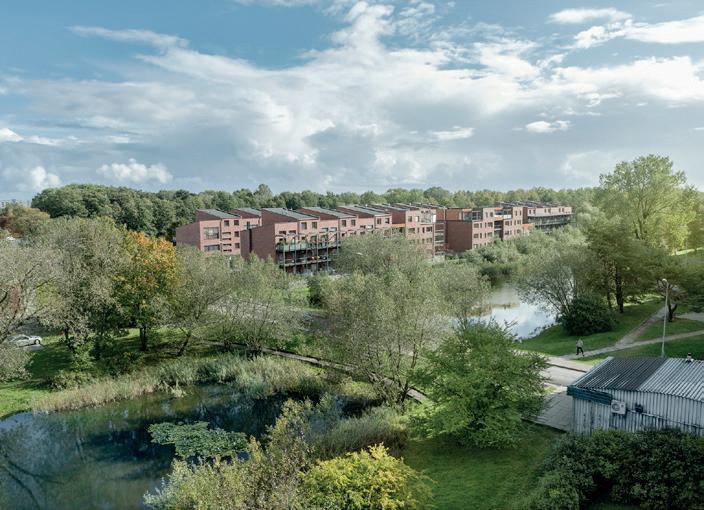

As travellers search for European destinations off the beaten path, many are discovering smaller cities away from the rising summer temperatures of southern Europe. One such destination is Latvia. Located on the country’s west coast, Liepaja offers an appealing blend of unspoilt landscapes, historic charm, and rich culture. For a place to relax while exploring the region, Hotel Amrita combines warm Latvian hospitality with Swedish elegance.
By Molly McPharlin
Hotel Amrita, a four-star establishment owned by a Swedish family who fell in love with Liepaja and its many attractions, opened in 1997. Since then, it has been a cornerstone of hospitality in the region, offering high-quality services to both tourists and business travellers.
The hotel has built a reputation as a welcoming destination, providing comfort, quality, and tailored services, ensuring that every guest not only enjoys a memorable stay but also leaves with a desire to return. Daiga Jansone, general manager
at Hotel Amrita, says; “The hotel strives to create an atmosphere where customers feel valued and cared for.” Jansone, who has worked in the hospitality industry for
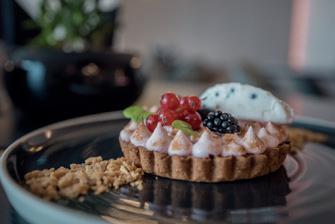
years, feels that an atmosphere of warmth and professionalism defines Hotel Amrita. “We have a genuine passion for ensuring guests’ needs are met and everyone’s experience at the hotel is positive.”
Creating a relaxing space for all to enjoy
In the last few years, Hotel Amrita has embraced a dynamic vision of continuous improvement, undergoing significant renovations to enhance its facilities. These upgrades include 83 fully renovated rooms, the restaurant Oskars, a lively bar called Bruno, and versatile spaces for conferences and celebrations.
Interiors boast custom-made furniture, soothing colour schemes, and stylish lighting, all designed for elegance and practicality. “Rooms offer a diverse range of options, including comfortable spaces for families and those travelling for both business and leisure,” says Jansone.
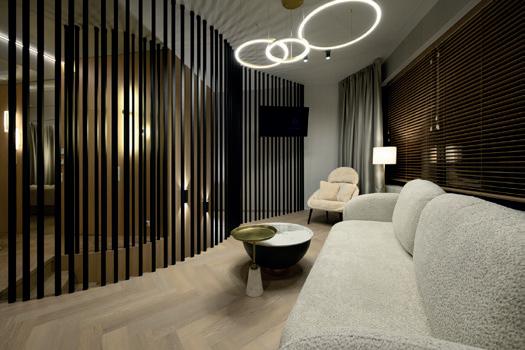
The Penthouse Suites, completed at the end of 2024, feature additional luxurious touches and an elevated, contemporary look.
Restaurant Oskars offers a sophisticated yet cosy ambiance. Its interior combines modern design with inviting details, providing the perfect setting for enjoying anything from a romantic meal for two, a family celebration, or an evening out with friends. Its menu offers fresh cuisine embracing local ingredients with nods to Italian, South American and local Latvian culinary traditions.
Meanwhile, Bruno Bar's welcoming atmosphere makes it a great spot for relaxing and socialising. The bar is family-friendly and children are welcome. The diverse menu combines traditional Latvian cuisine with popular international dishes and with full meals, snacks, and desserts, is suitable for anything from casual dining to a quick bite. Bruno Bar is also the perfect place to try Latvian beer and other regional drinks while playing board games with friends or watching live sports on the big screen. “There is something for everyone, and everyone is welcome,” says Jansone.
An ideal location to explore
Hotel Amrita is conveniently located close to Liepaja’s centre, providing an ideal base to explore the city and its environs on foot or by bicycle. Close to the hotel, visitors can experience the original wooden buildings and art nouveau architecture, Liepaja’s museum and theatre, one of
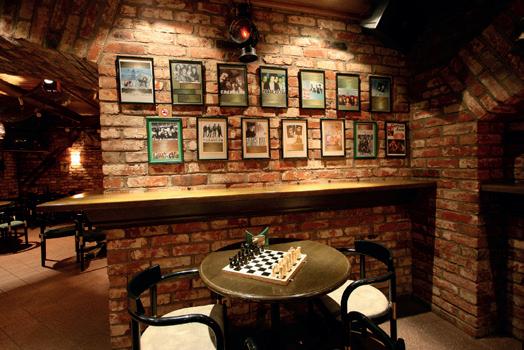
the oldest in Latvia, and the Great Amber concert hall, home to world-class musical performances. The city is also a foodie haven, with charming cafés and stylish restaurants serving traditional Latvian dishes and exquisite European fare.
Close by, Liepaja’s beaches tempt with relaxation and stunning sunsets. Liepaja, often called the city where the wind is born, offers visitors a wide range of activities. Nature lovers can explore Jurmala Park or head to Berberlini Park, where they can try wakeboarding, a treetop adventure course, and more. On rainy days, Liepaja Olympic Centre offers swimming and spa treatments.
One of Liepaja's distinctive neighbourhoods is Karosta, originally built as a military base. This area features imposing Tsarist-era buildings and Soviet-style architecture, starkly contrasting the rest of the city. The Orthodox Cathedral of Saint Nicholas, with its golden domes, is a testament
to the city’s diverse influences. History enthusiasts will find Karosta Prison particularly intriguing – a Soviet-era relic that provides interactive history tours and an immersive glimpse into the past.
A European cultural centre
Hotel Amrita is eagerly anticipating Liepaja 2027, when the city will proudly host the title of European Capital of Culture. This prestigious event promises vibrant cultural activities, performances, and exhibitions, highlighting Liepaja’s rich heritage and artistic spirit.
“Liepaja is a hidden gem,” adds Jansone. “We hope travellers from all over will come to explore the region and enjoy its tranquil beaches, rich history, and exciting adventure opportunities, with Hotel Amrita providing a place to feel at home.”
www.amrita.lv
Facebook: Hotel Amrita, Oskars, Bruno Bar Instagram: @hotel_amrita, @oskars_ restaurants, @brunobar_liepaja

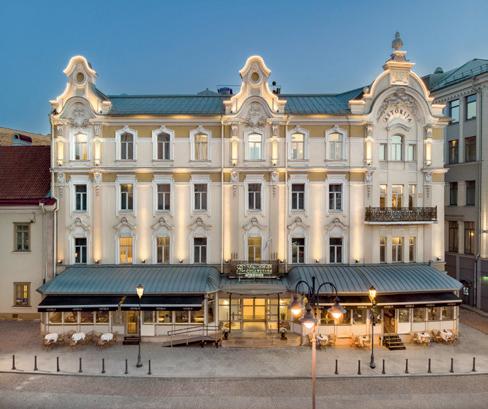
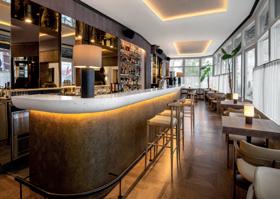
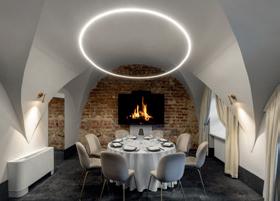
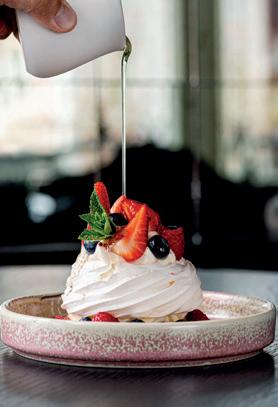
Set against the backdrop of Vilnius’ UNESCO listed Old Town, Radisson Collection Astorija is more than just a luxury hotel – it is a gateway to the city’s rich history and vibrant culture.
By Ndéla Faye | Photos: Radisson Collection Astorija
The hotel building was originally built in 1901, and Radisson Collection Astorija has long been a cornerstone of Vilnius’ hospitality scene. Over the years, it has welcomed royalty, world leaders, and other high-profile figures. With Lithuania named the second-best country to visit in 2025 by Lonely Planet, Vilnius is the perfect place to start exploring the country.
The hotel’s prime location places guests within walking distance of historic streets, shops, independent cafés, and renowned restaurants. Just one kilometre from the train station and a short

drive from Vilnius International Airport, it offers both convenience and immersion in the city’s unique atmosphere.
A glimpse into the past
Each of the 119 rooms and suites at Radisson Collection Astorija blends contemporary comfort with history. Some rooms boast original frescoes, while others feature replicas of the tapestries displayed in the Palace of the Grand Dukes of Lithuania. Many of the rooms have stunning views of Vilnius’ Old Town, making for a picturesque wake-up call each morning.
The recent renovation of its conference centre makes the hotel a top choice for both business and leisure travellers seeking high-end amenities in an elegant setting.
One of the hotel’s most remarkable features is its 16th century wine cellar, a hidden gem rediscovered in 2019. This historic space adds another dimension to the hotel’s character, offering an atmospheric
setting for intimate gatherings, wine tastings, or simply an escape into Vilnius’ past.
Culinary experiences and rooftop views
For those seeking a refined culinary experience, Astorija Brasserie delivers an elegant presentation of classic French cuisine with a modern twist. With an à la carte menu that changes seasonally and signature brunches for special occasions, the restaurant is a favourite among both visitors and locals.
Meanwhile, the much-anticipated reopening of Astorija Aperitivo Bar introduces a sophisticated aperitif culture to Vilnius. Inspired by Southern European traditions, the newly renovated space offers an inviting atmosphere, perfect for everything from a morning coffee to expertly crafted evening cocktails, all with a view of the city’s historic architecture.
Surrounded by charming streets, shops, and cultural landmarks, Radisson Collection Astorija offers effortless access to Vilnius’ many attractions while maintaining a tranquil retreat from the city’s vibrant energy.
www.radissonhotels.com/en-us/hotels/ radisson-collection-vilnius-astorija Instagram: @radissoncollectionvilnius

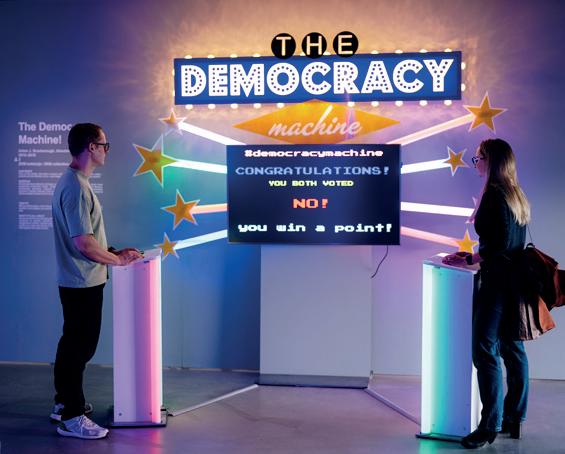
MO Museum in Vilnius, Lithuania, continues to redefine what an art museum can be – this time by turning its attention to video games. With GamePlay, the museum presents Lithuania’s first large-scale exhibition on video games as an art form, inviting visitors to interact, reflect, and play their way through 22 striking and unconventional titles.
By Signe Hansen | Photos: Domas Rimeika, MO Museum
Since opening in 2018, MO Museum in Vilnius, the home of Lithuania’s largest private collection of modern and contemporary art, has been taking on big questions like democracy, inclusion, and stereotypes through unconventional and bold exhibitions.
Organised in collaboration with the ZKM Center for Art and Media in Karlsruhe, GamePlay continues the conversation, exploring video games as a powerful medium of visual culture. Through the exhibition, independent developers and artists challenge familiar gaming conventions – experimenting with design, narrative, and aesthetics to address themes ranging from politics to identity, memory, and mental health.
“Video games are among the most influential media of our time,” says Agnė Kuprytė, one of the exhibition’s curators. “Yet they’re still often dismissed as mere entertainment. With this exhibition, we want to shift that perspective and show how games can inspire empathy, fuel imagination, and provoke change.”
The exhibition highlights three central approaches: games that push creative and aesthetic boundaries, games that respond to current social and political
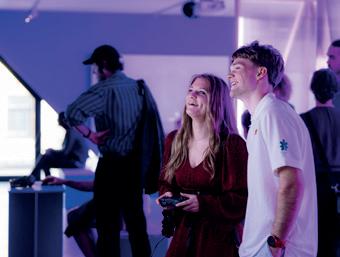
issues, and games that foster empathy through personal storytelling. From a game that explores the experience of dementia to one that simulates democratic decision-making, each work invites visitors to see – and play –differently. Whether you are a gamer, an art lover, or simply curious about how digital media is shaping contemporary life, GamePlay offers an engaging and thought-provoking entry point into one of today’s most dynamic cultural forms.
On top of this, it offers the perfect excuse to visit Vilnius and the MO Museum, which is known not just for its bold exhibitions but also for its warm inclusive atmosphere. In fact, it has been named Europe’s Most Friendly and Welcoming Museum so even if museums are not usually your thing, nothing should hold you back.
GamePlay
On display until 16 November 2025
MO Museum Pylimo str. 17, LT-01141
Vilnius, Lithuania
Hours: Wednesday–Monday 10am–8pm
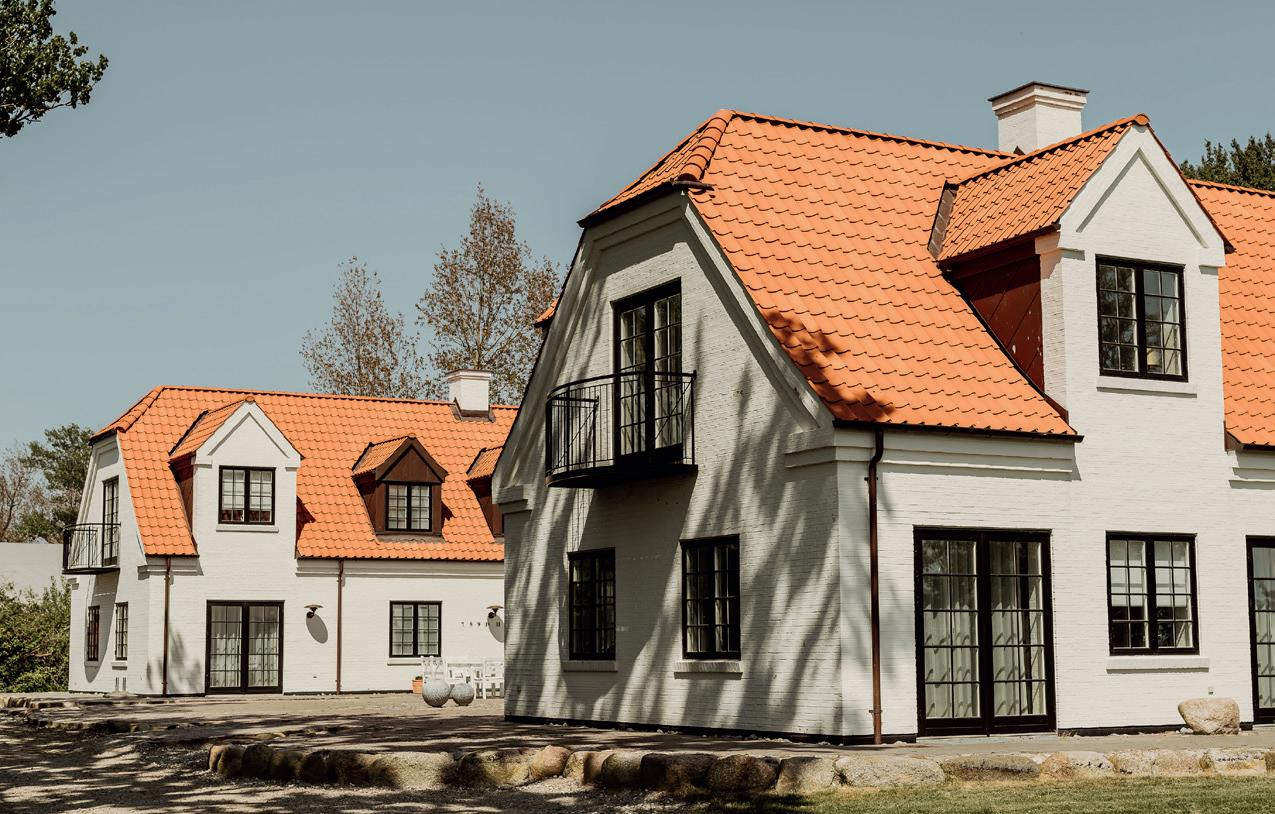
Many might associate a private island getaway with long flights, unsustainable practises and over-the-top luxury, but it can be quite the opposite. In Southern Denmark, Vejrø Island, previously a depopulated island, has been turned into an exclusive island resort with beautiful nature, charming restored buildings and regenerative farming. Here, guests can live, breathe and taste the true luxuries of island life – peace, nature and time.
By Signe Hansen | Photos: Vejrø Resort
Previously the home of a small agricultural community, Vejrø Island, a 155-hectare island north of Lolland, has been turned into a one-of-a-kind island resort with a hotel, luxury guest houses, a marina, conference facilities, a restaurant and a seaside café.
“The real luxury of our island is its beautiful, varied nature and animal life, the peaceful vibe, and the versatile options for making a stay exceptionally memorable. Whether you come here to treat your loved one to a getaway, are looking for a spectacular wedding scene, or scouting for an unusual yet perfect meeting setup, Vejrø has something
unique to offer. Also, the island is a popular destination for hunting and fly-in," CEO of Vejrø Resort, Charlotte Cederbye, states.
The island has its own sustainable energy and water supply, and a biological microtreatment plant. In other words, this small,

organic destination is like nothing else in Denmark, combining green innovation with subtle luxury and the distinct laidback charm of an island hideaway.
Last year, the fine-dining restaurant Gaia opened, adding another dimension to the island’s serene nature and charm. The restaurant is created as a celebration of the beauty and diversity of the island’s landscape and centres on a farm to table concept.
Originally the home of about 60 people, Vejrø’s original structures include not just homes but also a school, church, grocery store, and lighthouse. However, as the island was depopulated, the buildings were left to decay, and it was not until 2005 when Kim Fournais, founder and CEO of Saxo bank, bought the island and it was brought back to life.
Still, for a long time, Vejrø was an island for sailors and others in the know, but
with a landing strip for small flights, a helicopter pad and a flexible boat transport from Kragenæs Harbour, it has gradually been opening up to the public and is now fully in business.
Today, the island’s original buildings are turned into exclusive guest accommodations named after their previous use. The agricultural production has also been brought back to life and now provides the island’s restaurants with most of their produce. This means guests can see what they find on their plates when walking around the island, from the fruit and vegetables grown in the resort’s large conservatories to the endearing Galloway cattle enjoying the joy of regenerative agriculture and the game living its best life in the island’s forest.
Soon, a new boat transfer will make it even more accessible for guests from Copenhagen and the rest of Zealand to enjoy Vejrø. “Sailing from the port of Karrebæksminde, our new boat is a hydrofoil boat, 100 per cent powered by electricity from the island. It will be the first of its kind in Denmark,” Cederbye says.
A unique treat for your employees
Vejrø Resort is open for individual guests in summer, but it is also possible to book the entire island for private parties, meetings and teambuilding events throughout the year. Many companies take advantage of the island’s setup to create memorable teambuilding events, combining wild experiences such as hunting or clay-pigeon
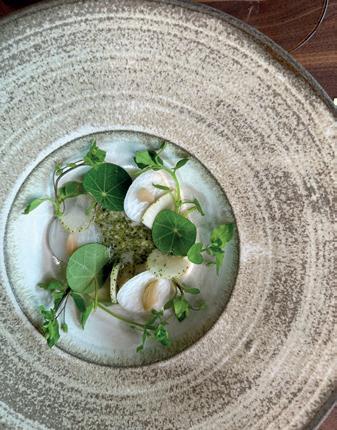
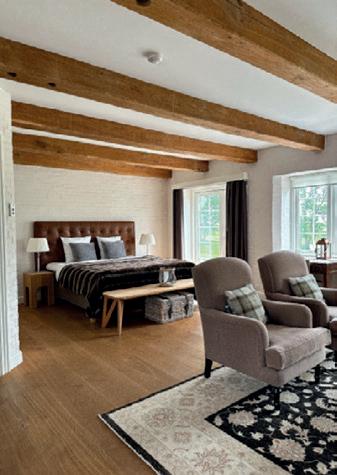
shooting with a gourmet dinner and a night in a luxury hotel room. “Our island provides a completely different experience.
The small size of the island, the wild nature and informal atmosphere mean that you relate to each other in a different way. At the same time, the undisturbed surroundings, sea, and open sky ensure that everyone feels at peace and in no rush to get back home,” explains Cederbye.
On top of the individually arranged activities, guests can explore the island on foot or by bicycle and enjoy leisure activities such as pétanque, swimming and yoga.
www.vejroe.dk
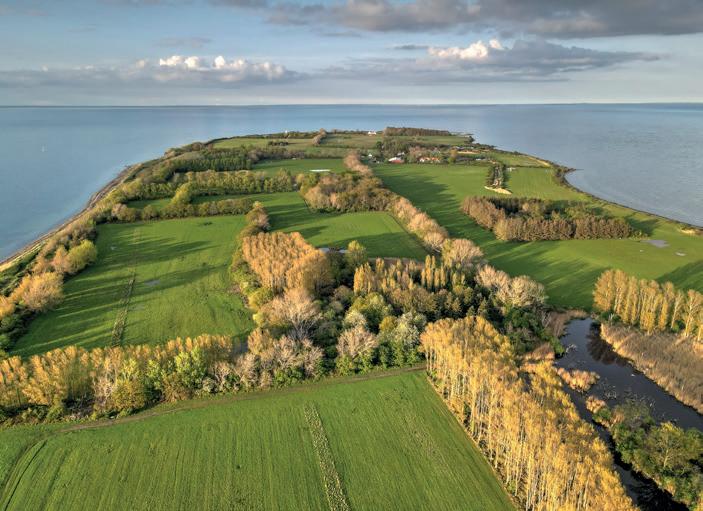
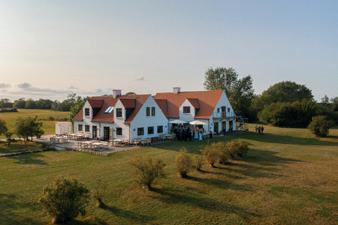
Facts:
• On Vejrø Island, you will find Hotel Blæsenborg, Karlekammeret, four guesthouses, Restaurant Skipperly, which transforms into the fine dining restaurant Gaia in the evening, a regenerative farming operation, hunting grounds, an airstrip, a helipad, a beautiful marina, and a seaside café (Provianten).
• The hotel and guesthouses can house up to 80 overnight guests. Glamping accommodation can be added for bigger events.
• Boat transfers are arranged from Kragenæs on Lolland and (soon) Karrebæksminde on Zealand.
• Transport on the island is by foot or bicycle. The resort’s bus can transport guests and their luggage to and from the harbour and the restaurant.
• The resort is open for individual bookings from April to October and for meeting and conferences, events, and private parties all year.

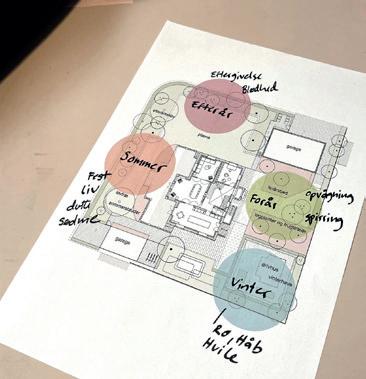
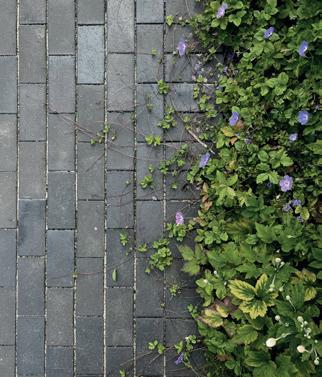
Rooted in creativity, aesthetics, and connection, Living Landscape brings a thoughtful approach to outdoor design and architecture. From playful public spaces to poetic private gardens, every project is shaped by intuition, beauty, and a deep respect for nature’s natural rhythm.
By Heidi Kokborg | Photos: Living Landscape
After more than 20 years in the architecture industry, founder of Living Landscape, Karen Iversen, took a leap and started her own business. She wanted to work more freely and intuitively, and more in tune with what truly matters. “I needed to create something that reflected not just what I do, but how I see the world,” explains Karen Iversen, founder and owner of Living Landscape.
Iversen works across multiple different projects, but her work always begins and ends with three core values. The first is natural play – designing spaces that spark imagination and movement in children and adults alike. “We all know how to play. It just needs to be invited back into our lives,” says Karen Iversen.
The second is building for nature. “Some projects are more about helping nature thrive than creating something new. With
careful material choices and a respect for ecosystems, these projects focus on restoration, not just design.”
The third is creating unique outdoor spaces – places that leave an impression. Karen Iversen explains; “I love when someone tells me that they started walking a different route, just to pass through a space I’ve worked on. That is when I know it’s working, and I’m making a positive impact.”
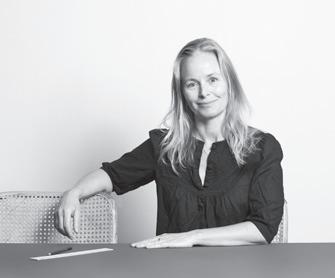
Aesthetic connection and mutual care
At the heart of Karen Iversen’s work is a belief that people and nature can exist in a mutually enriching relationship. Through aesthetic connectedness, she seeks to deepen our bond with the world around us. “For me, aesthetics is a form of spacious care. It allows us to connect more fully, to ourselves, each other, and our surroundings. This is the foundation of all my work,” says the founder.
Every project is guided by a sense of time and seasonality. A garden that the company designed in Gentofte includes four distinct areas, each reflecting a season; lush and buzzing in summer, golden and soft in autumn, alive with blossoms in spring, and quiet and reflective in winter with an orangery. “I want to create spaces that bring people closer to nature, and in turn, closer to themselves. Places with a soul. When design comes from a place of presence and care, it does not just change how a place looks, it changes how the space and we feel,” smiles Karen Iversen.
www.living-landscape.dk Instagram: @_livinglandscape_
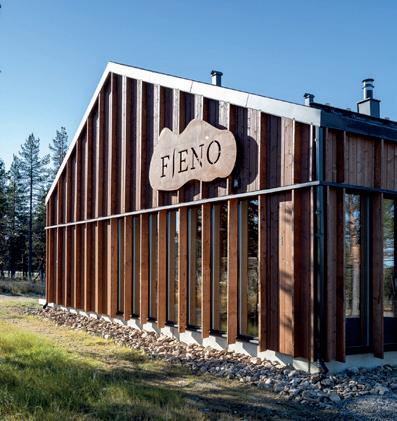

Studio Tuula Y’s founder, Tuula Ylinenpää, is a designer who has always had an innate eye for beauty. She has turned a lifelong passion into a career built on craftsmanship, soft aesthetics and a deep respect for materials, light and space.
By Ndéla Faye
Each of Ylinenpää’s projects is infused with a sense of calm and cohesion, marked by earthy palettes, natural textures and a thoughtful serenity that seems to breathe through the walls. “Each project begins with listening to the client, the space, and how it can best serve its users,” she explains.
With offices in both the Rovaniemi region in Northern Finland and in Helsinki, Studio Tuula Y operates across a diverse range of projects, from private homes to cafés, workspaces, restaurants, boutique hotels, and public spaces.
A holistic and personal approach
For Studio Tuula Y, user-friendliness is essential, and designing is a collaborative process. A prime example is Fieno, a pizzeria in Saariselkä, where Ylinenpää and her team worked closely with the client to create the best possible design for the space and bring warmth and intimacy.
In several projects, Ylinenpää also designs the staff uniforms and curates the wall art herself, showcasing her versatile and hands-on approach. A good example of this is the popular Arktikum Café, located in the museum and science centre in Rovaniemi.
Material choices are made with care – not only for aesthetic impact but also for their environmental and health implications, including air quality. No detail is too small; from lighting placement to textures, Ylinenpää believes that every element plays a role in elevating the space.
Sustainability is not just a guiding principle; it is woven into every stage of the process. “Creating interiors that can evolve with time and changing needs is essential, and we design with longevity in mind,” the founder says.
Ylinenpää assesses each project holistically and often works with clients
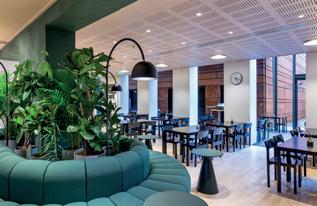
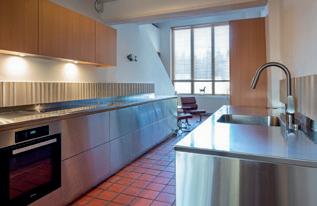
throughout the entire process, from the first sketch to the finishing touches. The holistic service also includes budget planning and cost estimates as part of the design process. In addition, Ylinenpää often collaborates with local artisans and custom furniture makers to create spaces that are personal and deeply rooted in Finnish design traditions.
Whether a cosy café or a sleek workspace, Studio Tuula Y brings a human-centred and detail-oriented approach to every project. With a blend of warmth, practicality and thoughtful design, the studio continues to create spaces that not only look beautiful but truly feel like they belong.
www.ylinenpaa.fi
Facebook: Ylinenpää Oy
Instagram: @studiotuulay
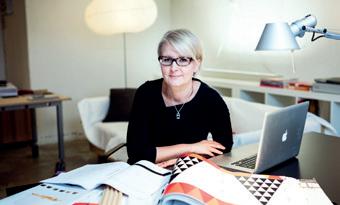


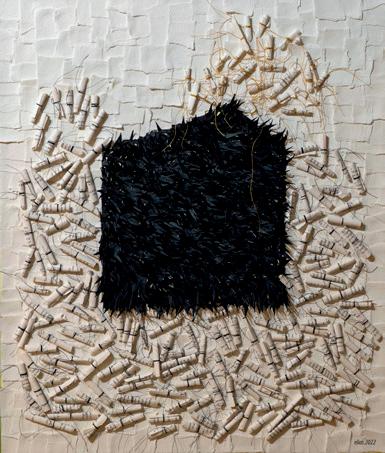
When Heidi Glattre starts working on a piece of art, she spends a lot of time thinking of what texts to use. “Most people describe their experience with art in words. I use art to experience words,” Glattre says.
By Eva-Kristin U. Pedersen
With a degree in Literature, it is perhaps not surprising that Glattre puts such emphasis on the written word. The connection between the written word and the art she produces runs like a red thread through most of her work. “I’m interested in how language influences the way we perceive of the world around us,” Glattre says.
Glattre’s path to life as a working artist was winding, with a couple of sudden turns along the way. “When I became a mother, I started taking classes in painting. I also studied religious art and dedicated a lot of time to learning iconography – an art form where the rules of what you can and cannot do are very strict,” Glattre explains.
Another turn of events took Glattre and her family to London. The change of scenery presented her with a chance to develop her artistic profile. “I had my own atelier and I started experimenting, mix-
ing religious art with what I’d learned at the art school – it was exhilarating,” she says.
Art as a process
Back in Norway, Glattre decided to pursue a degree at Nydalen Art School in Oslo. “Spending that much time in an artistic environment made me appreciate the importance of the process of making art, not only the outcome,” Glattre says.
To her that process usually involves texts – quite literally. For one of her religious pieces, This is the Dream, she mixed gold-leaf, handmade paper and silk paper from old psalm books. And in an installation to honour female literary pioneers, she used texts of female writers Amalie Skram, Emily Bronte and others, she used parts of their texts as décor in handmade silk dresses. “I wanted to show that it was their words, their texts that liberated them as women,” Glattre says.
Because the process by which Glattre makes art is so mentally and physically demanding, it can even be painful. “Sometimes my hands and back hurt after working,” she says, but adds that the pain is both a gift and a punishment. “The physical pain makes us ask the question: why do we do what we do every day? There is always a reason, there is passion that drives us.”
Facebook: heidi.glattre
Instagram: @hglattrekunst


ALL OUR PRODUCTS ARE NOW VEGAN




VITAMUN og BØRNEVITAMUN:
• Bidrager til en normal funktion af immunforsvaret (Folat, Jern, Kobber, Vitamin A, Vitamin B6, Vitamin B12, Vitamin C, Vitamin D, Selen, Zink)
• Bidrager til et normalt energistofskifte
(Biotin, Calcium, Jern, Jod, Kobber, Magnesium, Mangan, Niacin, Pantothensyre, Thiamin, Riboflavin, Vitamin B6, Vitamin B12, Vitamin C)
MIDTVEJSPILLEN:
• Bidrager til at mindske træthed og udmattelse
(Folat, Jern, Magnesium, Niacin, Pantothensyre, Riboflavin, Vitamin B6, Vitamin B12, Vitamin C)
• Bidrager til at vedligeholde normale slimhinder (Biotin, Niacin, Vitamin A, Riboflavin)
VITAMINS & CHILDREN’S VITAMINS:
• Contributes to a normal function of the immune system
(Folate, Iron, Copper, Vitamin A, Vitamin B6, Vitamin B12, Vitamin C, Vitamin D, Selenium, Zinc)
• Contributes to a normal metabolism
(Biotin, Calcium, Iron, Iodine, Copper, Magnesium, Manganese,Niacin, Pantothenic Acid, Thiamin, Riboflavin, Vitamin B6, Vitamin B12, Vitamin C)
THE MID-LIFE TABLET:
• Contributes to minimised tiredness and exhaustion (Folate, Iron, Magnesium, Niacin, Pantothenic Acid, Riboflavin, Vitamin B6, Vitamin B12, Vitamin C)
• Contributes to the maintenance of normal mucous membranes (Biotin, Niacin, Vitamin A, Riboflavin)
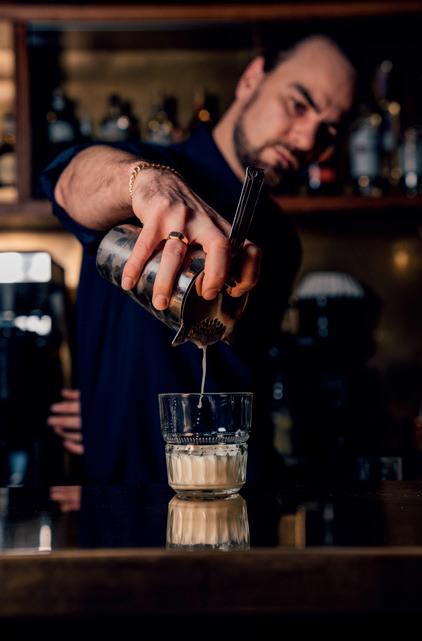
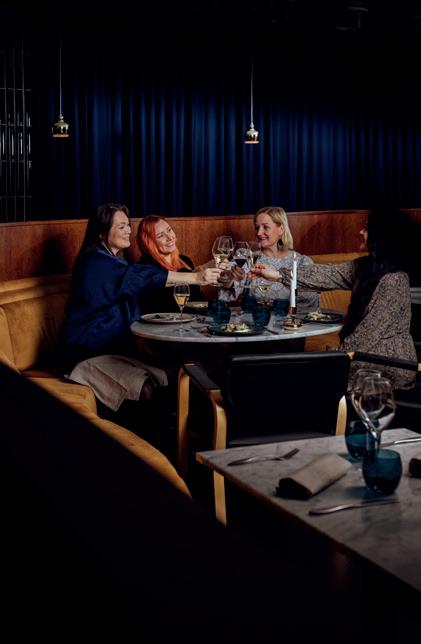
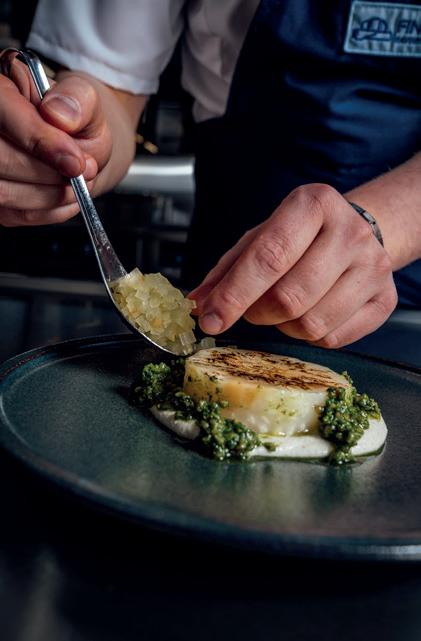
Located within one of Helsinki’s most iconic landmarks, Finlandia Bistro delivers more than just a meal. Here, history and modern Finnish gastronomy come together, creating a setting as unforgettable as the food itself.
By Ndéla Faye | Photos: Finlandia Hall, Riikka Kantinkoski, Mikko Uosukainen
Originally completed in the 1970s, Finlandia Hall is one of Finland’s most treasured buildings. Designed by renowned architect Alvar Aalto, the space reflects his signature style: flowing lines, natural materials, and an intuitive sense of harmony between structure and surroundings.
Today, the recently renovated Finlandia Hall’s crisp white marble exterior and the building’s elegant interior details stand as a testament to modernist ideals. Finlandia Hall is a multipurpose space with conference halls, an art exhibition space, a shop, hotel rooms, a wine café, a panoramic terrace – and the newly-opened Finlandia Bistro, a 64-seat restaurant.
manship and Finnish ingredients. It is the perfect place to explore the flavours of
dition meets creativity, and every meal is rooted in a deep respect for local produce
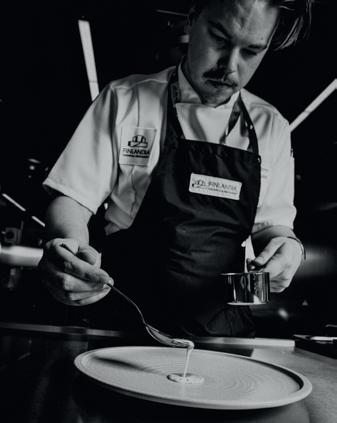
At the core of Finlandia Bistro’s culinary vision is executive chef Mikko Puuronen, whose impressive résumé includes a number of stints at Michelin-starred restaurants across Europe. Puuronen has crafted a unifying food philosophy for Finlandia Bistro, which champions Finnish ingredients and recipes while also drawing inspiration from the culinary traditions of Italy, France, and Spain.
Whether you are a culture-hungry traveller, a conference guest, or a local popping in for a small bite to eat, the bistro offers an unpretentious dining experience. With original Alvar Aalto design details, Finnish art, and a warm, relaxed atmosphere, the bistro blends culture and gastronomy. “We wanted to make the bistro easily approachable. Everyone is greeted with open arms, whether stopping by for a drink, sampling a dish, or sitting down
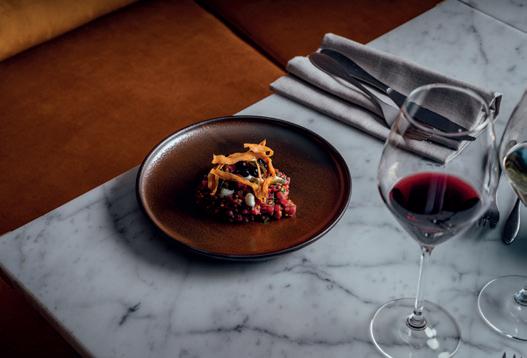
for our carefully thought-out six-course menu,” says head chef Juho Lindström.
The menu is rooted in seasonality, precision and creativity. It mirrors the changing seasons, with fresh, locally sourced ingredients guiding the kitchen’s direction. Traditional Finnish recipes form the backbone of the offerings, but they are always served with a modern, inventive twist. “Nordic cuisine and Finnish food are all about pure flavours, and we let the ingredients lead the way. There’s also a touch of playfulness on the menu. Expect unique takes on traditional Finnish dishes, exciting flavour combinations and exquisite presentation,” Lindström says.
Joining Lindström at the helm is restaurant manager Mirva Heino, who in addition to overseeing the front-of-
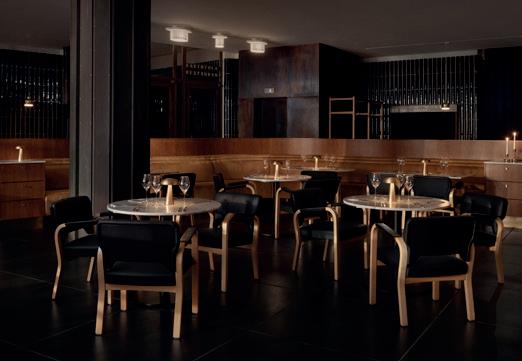
house operations is responsible for curating the bistro’s thoughtfully selected wine list with Mediterranean influences.
“Alvar Aalto was a great fan of Italy and drew inspiration from the country for his designs. He was particularly fond of Chianti, so our wine menu includes several kinds. Our wine list is Italy-focused, but also features a number of wines from across Europe,” Heino says.
Visitors can also explore the building’s aesthetic roots through a permanent exhibition housed within Finlandia Hall, which offers insight into the architecture and artistic vision of Alvar Aalto, Aino Aalto, and Elissa Aalto. The exhibition adds an enriching layer to any visit, making a stop at Finlandia Bistro not just a culinary moment, but a cultural one, too.

The bistro is also available for hire for private functions, for an intimate lunch or a stylish dinner event. The space offers a unique setting at the heart of one of Helsinki’s most iconic buildings.
What truly sets Finlandia Bistro apart is the combination of its prime location, stunning surroundings, and the warm, attentive service of its dedicated staff. The bistro invites guests to slow down and savour the moment. “We want people to feel that they can just walk in, sit down, and enjoy themselves. It’s all about great food, great company, and making everyone feel welcome,” the restaurant manager concludes.
www.finlandiatalo.fi
Instagram: @finlandiabistro
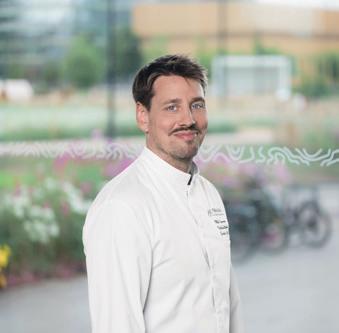
Opening hours: Thursday 17-23
Friday 17-24
Saturday 15-24
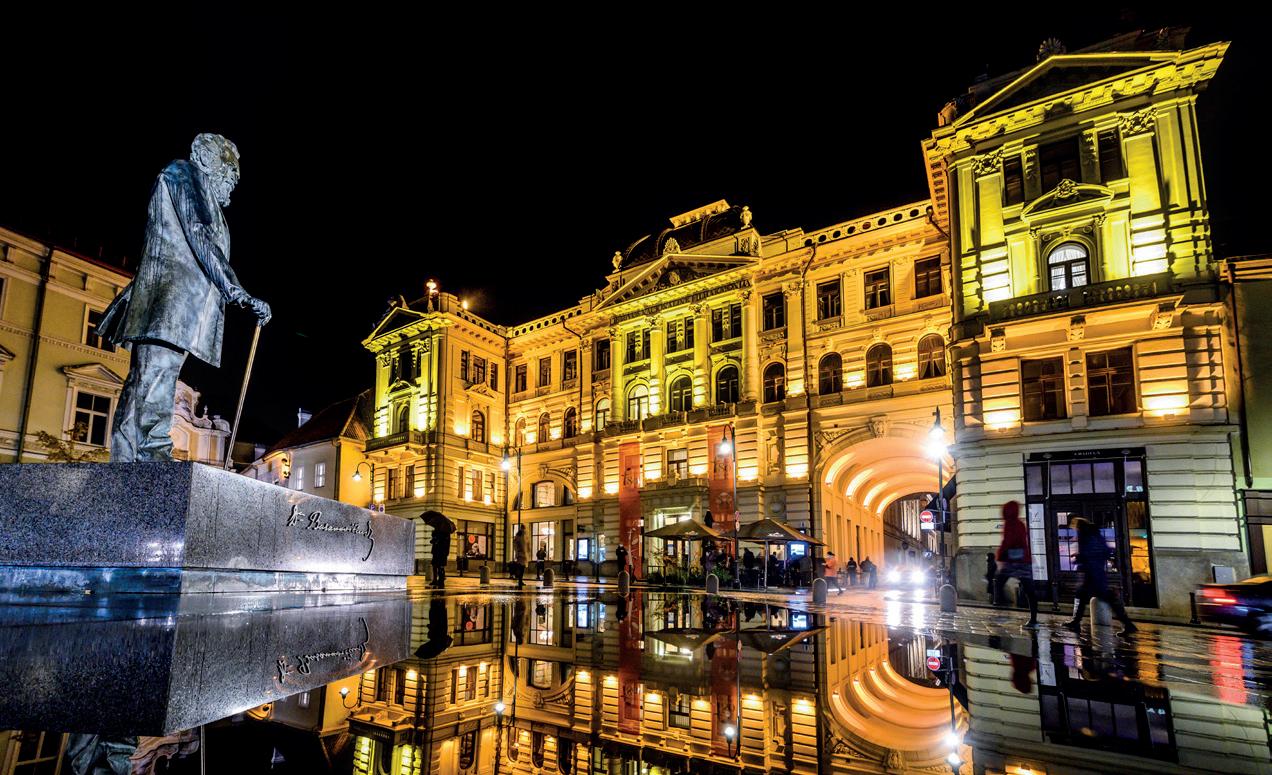
In the heart of Vilnius’ historic Old Town, tradition meets world-class artistry as the Lithuanian National Philharmonic Society brings together the country’s finest musical talents and welcomes celebrated international performers. With a history spanning over eight decades, the striking building remains a vibrant hub for orchestral excellence, chamber music, and internationally acclaimed festivals.
By Signe Hansen | Photos: Dmitrij Matvejev
Founded in 1940, the Lithuanian National Philharmonic Society holds a special place in the country’s cultural history. Through decades, the society has gathered Lithuania’s most accomplished music forces under its roof. In 1909, Vilnius-born Jascha Heifetz – one of the most prominent violinists of the 20th century – gave his debut performance here, setting the standard for the musical legacy that followed.
“It’s incredible how clearly the birth, growth and maturity of large music
institutions reflect the structure of our planet,” says Rūta Prusevičienė, director.
“The most prominent Lithuanian orchestras and chamber ensembles represented by the National Philharmonic Society of Lithuania were created and nurtured as complex ecosystems that can provide long-term artistic, cultural, creative and social benefits. Over time, the orchestras became a nourishing medium for the modern Lithuanian school of composition, a link between the academic and scientific community in the fields of performing art and musicology,
a creator of various forms of support and patronage, and leaders of cultural diplomacy and artistic innovation.”
A proud legacy, a vibrant present Today, Lithuania’s largest concert organisation – now in its 84th season – serves as the proud home of the Lithuanian National Symphony Orchestra, led by the internationally acclaimed maestro Modestas Pitrėnas. The orchestra maintains a strong artistic partnership with its principal guest conductor, French maestro Victorien Vanoosten, and fosters close professional relationships with musicians and institutions worldwide.
Also resident at the Lithuanian National Philharmonic Society is the Lithuanian Chamber Orchestra, renowned for its rich history. Its artistic director, the celebrated violin virtuoso Sergej Krylov, is a regular
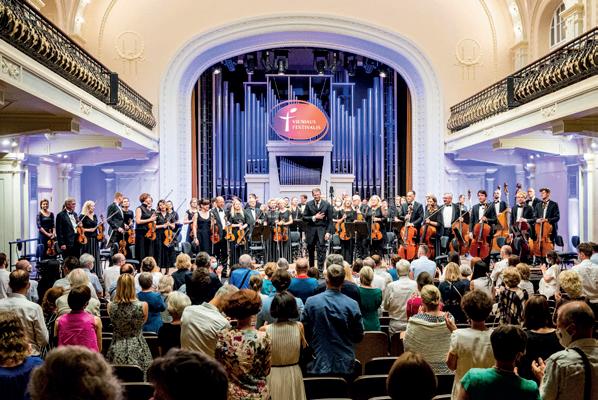
presence on the stages of Europe, the Americas, and Asia. The society is also home to several distinguished chamber groups: Musica Humana, the Vilnius String Quartet, and the Čiurlionis Quartet – each of which performs extensively both in Lithuania and internationally.
“We have already demonstrated and proven to the world the skill of our ensembles, our discerning audiences, and the perfect acoustics of our concert hall. Our international achievements contribute to the positive image of Lithuania,” says Prusevičienė.
A global stage in Vilnius
Every season, the philharmonic hosts over 200 concerts, spanning a broad range of genres to satisfy diverse musical tastes. Each concert is a one-of-akind experience, rarely repeated.
“Based in one of the most beautiful buildings in the historic Old Town of Vilnius, we have the perfect setting for a wide range of musical experiences,” says Prusevičienė. “Our orchestral concerts take place in the 700-seat Concert Hall, which was renovated a few years ago and boasts extraordinary acoustics. The smaller Chamber Hall, on the other hand, is perfectly suited for chamber music.”
The stage has welcomed an impressive list of global talent, including American baritone Thomas Hampson, conducting legend Christoph Eschenbach, acclaimed conductor Mirga Gražinytė-Tyla, mezzo-
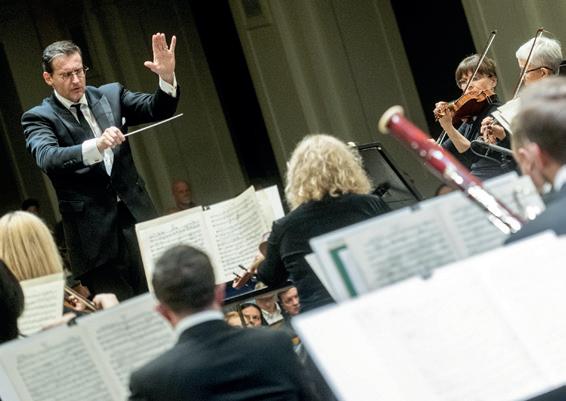
soprano Violeta Urmanavičiūtė-Urmana, tenor Edgaras Montvidas, pianists Lucas and Arthur Jussen, the Camerata Salzburg, and the Luxembourg Philharmonic Orchestra.
Experience the magic live or online
A highlight for music lovers is the festivals organised by the society; the annual Vilnius Festival and the biannual Vilnius Piano Festival. Since its founding in 1997, the Vilnius Festival has become one of Lithuania’s premier cultural events, presenting both classic and contemporary works, including premières and commissioned pieces in collaboration with world-renowned artists and European festivals.
The society’s concert season typically runs from September to May in Vilnius, and during the summer months in other locations. But, even if you are not in Lithuania, you can still experience the magic. The Digital Philharmonic (www. nationalphilharmonic.tv), launched in 2017, offers a growing library of over 200 high-quality concert recordings available online. Simply choose a performance, click, and let the music transport you.
www.filharmonija.lt
Facebook: filharmonija
Instagram: @nacionaline.filharmonija
YouTube: @lietuvosnacionalinefilharm232
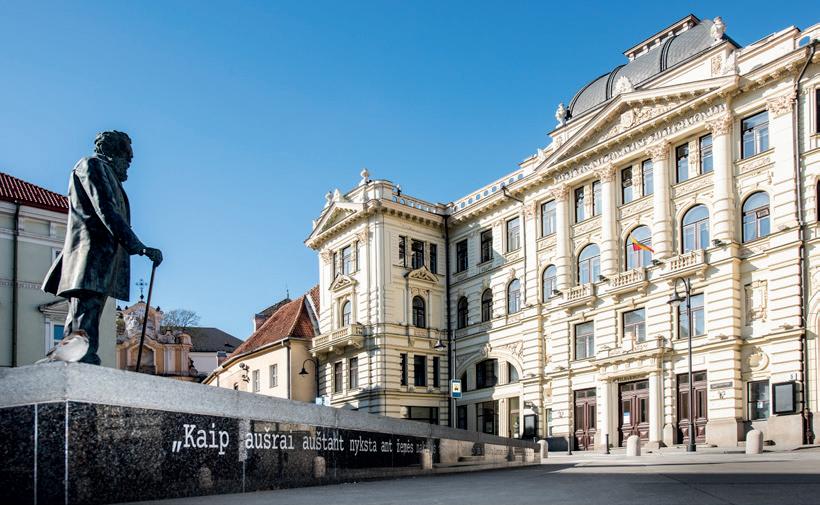
Every year for the last three decades, Estonia’s unofficial cultural capital has hosted a four-day-long celebration of culture, tradition and music. With more than 75 concerts by over 50 artists from across the globe, look to Viljandi Folk Music Festival for an unforgettable summer.
Normally, the quaint town of Viljandi exists as a dreamy and quiet pause in time. At the end of July, however, the town awakens with a loud buzz. With music and dance, the summer marks the annual Viljandi Folk Music Festival. This year’s lineup sees a range of Estonian and international acts, including performances by Trad.Attack! (Estonia), Ímar (Scotland), NOËP (Estonia), Haydamaky (Ukraine), Natig Rhythm Group (Azerbaijan), and more.
“This year, Viljandi welcomes artists from 13 different countries from all over the world, and looks to explore fascinating cultures, charismatic performers, virtuosos, village traditions, young artists,
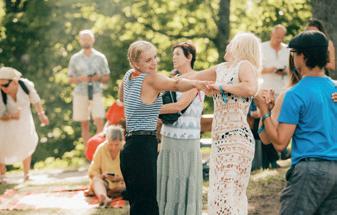
new performances, and special projects,” says the festival’s programme manager Tarmo Noormaa.
“You’ll hear traditional folk, folk rock, chamber folk, and folktronica. Each artist’s journey to the festival is unique – for example, I discovered the Natig Rhythm Group at a festival in Kazakhstan and was
By Celina Tran

so impressed that I invited them to Viljandi on the spot.”
Set to last from 24 to 27 July this year, the festival is the perfect way to explore the world from one place, touching upon everything from Livonian and Latgalian cultural heritage to modern African folk.
www.viljandifolk.com
Instagram: @viljandifolk
Facebook: Viljandi pärimusmuusika festival / Viljandi Folk Music Festival


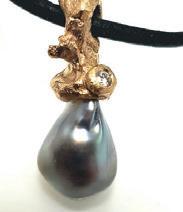
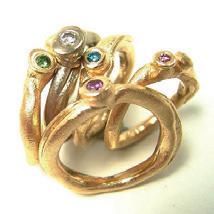
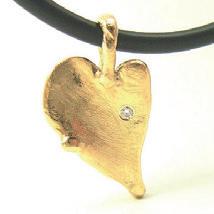
Guld omsmeltes


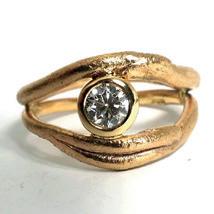
- Lisbeth Warming er guldsmed med særlig flair for at skabe smykker, der udstråler stor personlighed.
Lisbeth Warming is a goldsmith with a flair for creating jewellery that exudes personality. Through her handiwork, a fascinating universe of golden organic shapes and glistening organisms opens up. She uses precious stones and plays with diamonds and pearls in all shapes and sizes.
- Lisbeth Warming er guldsmed med særlig flair for at skabe smykker, der udstråler stor personlighed.
I hendes hænder udfolder der sig et fascinerende univers af gyldne, organiske former og strålende organismer.
I hendes hænder udfolder der sig et fascinerende univers af gyldne, organiske former og strålende organismer. Materialerne er ædle og hun leger med brillanter og barokke perler i alle farve og størrelser. Men i Lisbeth Warmings design bliver resultatet hverken prangende eller prætentiøst.
Materialerne er ædle og hun leger med brillanter og barokke perler i alle farve og størrelser. Men i Lisbeth Warmings design bliver resultatet hverken prangende eller prætentiøst.
Lisbeth Warming’s designs are, however, never flamboyant or pretentious. The jewellery instead appears as natural and charming pieces of art, which will continue to surprise and fascinate throughout the use of them. All pieces created are one of a kind.
Smykkerne fremtræder som små naturlige og charmerende kunstværker, så eventyrlig iscenesat, at man kan blive ved med at gå på opdagelse i dem. Alle smykker er unikastykker.
Smykkerne fremtræder som små naturlige og charmerende kunstværker, så eventyrlig iscenesat, at man kan blive ved med at gå på opdagelse i dem. Alle smykker er unikastykker.
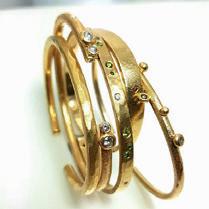

- Lisbeth Warming er guldsmed med særlig flair for at skabe smykker, der udstråler stor personlighed. I hendes hænder udfolder der sig et fascinerende univers af gyldne, organiske former og strålende organismer. Materialerne er ædle og hun leger med brillanter og barokke perler i alle farve og størrelser. Men i Lisbeth Warmings design bliver resul tatet hverken prangende eller prætentiøst. Smykkerne fremtræder som små naturlige og charmerende kunstværker, så eventyrlig iscenesat, at man kan blive ved med at gå på opdagelse i dem. Alle smykker er unikastykker. Åbningstider:
Lisbeth Warming also melts down old gold jewellery to create new, modern pieces, which retain their history.
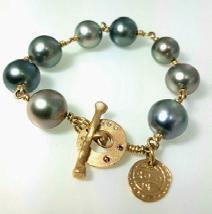
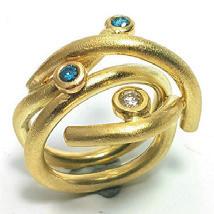

OPENING HOURS: WED - THU - FRI: 12-18
fre. 12-18
12-18
10-13
10-13

Mindphoto.dk
From exciting newcomers to culinary-themed comebacks, here are some recommended playlist additions for the month of May.
Swedish artist ORKID is back with her first new music since last year’s Where Flowers Grow EP, and she’s still got her mind on that life-giving earth – this time trilling about “the garden of Eden”! Pleasingly, she’s also maintained the quality control of that EP, which helped her pick up a Grammy nomination this year; new single EDEN is some truly beautiful Scandi synthpoppery.
There’s a lot to be said for the simplistic charms that lie within a jaunty pop song, and the new release from Finland’s Behm has got bags of them! Plus, not only is Kaiken Arvoinen unlike anything else out there right now in the melodical sense, it also manages to pull off what’s a rare feat in the streaming age we’re in these days; it clocks in at almost four minutes in length.
On a recent flight to Stockholm, I got chatting to another passenger who had the haunted look of an Englishman freshly persuaded to move to the north of Sweden, which is exactly what he was. “My wife is from there,” he explained. “She suggested we try living up there for a bit.” I felt a pang of pity for this man, imagining that the ‘for a bit’ would likely mean ‘forever’.
In my experience, when a Swede chooses to move back to the north, it’s because their soul is irretrievably bound to that place. My sister is one of those people. Occasionally, and especially if we are on holiday in some lovely, warm country, she will question her choice to return to the north. This is until I remind her that she would not be able to drive the huskies that she keeps acquiring, down the streets of Rome in a dogsled.
10,000 Tuntii is the debut single from Finnish newcomer KAUKUA. Written, produced and performed entirely by the man himself, it’s an incredibly strong first-showing for the artist. The song’s melody is dripping with enough melancholia that it’s placed him right at the top of my list of new acts to listen out for in 2025.
Another Finnish newcomer to keep your eyes and ears on is 19-year-old Eino, who has just released his debut Haamuja. It’s a one-listen-and-you’re-hooked kind of affair, and so he’s ticked that box of strong first-impression with aplomb!
Finally, almost 40 years after it became one of the signature Swedish hits of the ’80s, Lasse Holm’s Canelloni Macaroni is back on the table! With a soupedup production from Swedish producer Nause and newly recorded vocals from
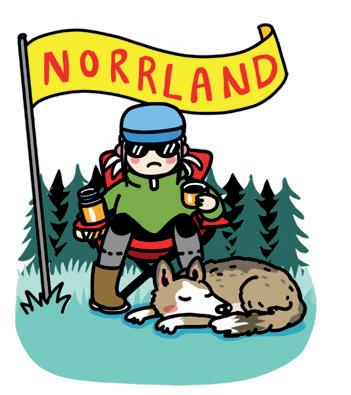
I, on the other hand, have grown too soft for the north, and it shows. On one of my last visits, my sister’s friend, upon inspecting my British outfit, remarked to my sister as if I was not even there: “Make sure this little one wears real clothes.”
Back to the Englishman on the plane, who nervously confessed; “The winter wasn’t good. Do you know what happens
By Karl Batterbee
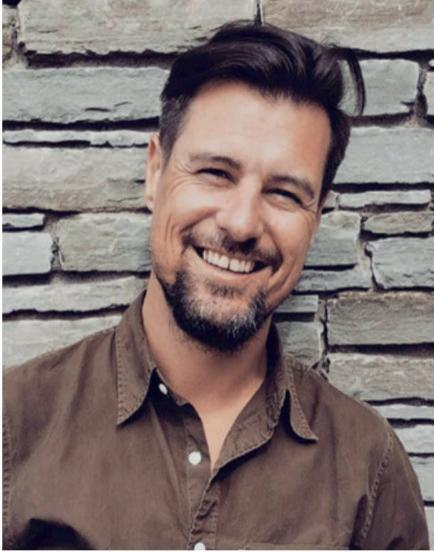
across Sweden this summer.
www.scandipop.co.uk
By Maria Smedstad
when snow melts and turns to ice and then it snows on top of that?” I nodded, familiar with this special hell. “But,” he continued, more brightly, “I look forward to seeing what the rest of the seasons are like!” I wished him good luck, which he probably took to mean him catching his connecting flight, but which in fact was in reference to him finding out that there are only two seasons in the north; winter and mosquito.
Maria Smedstad moved to the UK from Sweden in 1994. She received a degree in Illustration in 2001, before settling in the capital as a freelance cartoonist, creating the autobiographical cartoon Em. Maria writes a column on the trials and tribulations of life as a Swede in the UK.


In this month's column, we highlight some exciting and acclaimed developments in the Scandinavian film and television industry.
By Anders Lorenzen
Familier som vores (Families like Ours), which has garnered several internal accolades, has been picked up by BBC Drama. The Danish drama series focuses on a life-changing extreme weather event that forces the Danish population to migrate due to an unprecedented flood. Sue Deeks, head of BBC Programme Acquisition, says; “Families Like Ours is a beautifully constructed, thoughtprovoking drama about what happens when people are confronted by the inconceivable, and forced to make seemingly impossible choices…” BBC has not yet announced a broadcasting date.
Elsewhere, a new ambitious crosscountry Scandinavian creative partnership has been established. The broadcasters TV 2 Danmark, TV 2 Norge and TV4 Sverige have announced
a collaboration for the high-hitting drama series Blåt Blod (Royal Blood). It tells the story of the power struggle between the Nordic royal families in the 17th century, a struggle that has shaped today’s geopolitical situation. It is expected to reach the Nordic TV screens in 2027. Royal Blood is the first project in this collaboration, with hopes to lead to future projects.
On Netflix, a couple of new Scandinavian releases will become available this month. Directed by Per Fly, Reservatet (The Reserve) is a six-part Danish drama series released globally on Netflix on 15 May. The plot centres around the young Filipino au pair Ruby, who disappears from one of Denmark's most affluent neighbourhoods north of Copenhagen.
Also on 15 May, the fifth series of the Norwegian comedy drama series Pørni (Pernille) premieres. Featuring a mixture of heartfelt storytelling, humour, and real-life struggles, it remains one of the most beloved series in Norway.

The month of May promises plenty of enticing things to get out there and see, hear and do across Scandinavia. Read on for our pick of cultural highlights, whether you’re a metalhead or a Manolo Blahnik enthusiast.
By Karl Batterbee



Swedish band Dead By April have planned their biggest headline concert to date in Norway, at the Rockefeller in the country’s capital. With over 250 million streams on Spotify, 70 million streams on YouTube, multiple platinum and gold certifications and Swedish Grammy awards to their name, these chaps are one of Sweden's biggest electronic rock exports in modern times. They have previously toured with world-renowned bands such as Linkin Park, Avenged Sevenfold and My Passion, played some of Europe's biggest festivals such as Sonisphere, Pier Pressure, Download Festival and Metaltown, and even crossed over to family-friendly Swedish TV; in the form of Melodifestivalen, Allsång på Skansen and Sommarkrysset. Needless to say, concert-goers will be in good hands!
Rockefeller, Oslo www.rockefeller.no

Candace Bushnell; True Tales of Sex and the City (5 and 7 May)
With all the old episodes of Sex and the City having arrived to Netflix in 2024 and the trailer for the third season of its spinoff And Just Like That having dropped in April, Carrie Bradshaw is in vogue once more. Now, the show’s creator (and the woman that Carrie herself is based on) is heading out on a world tour and taking it to the Nordics in May. Billed as an unforgettable girls’ night out, Candace regales audiences with tales of her time as a New York girl-about-town that went on to inspire a generation-defining TV show across the globe. And she also lets the crowd in on everything that has happened to the original Carrie Bradshaw since! Bremen Theatre, Copenhagen (5 May) Vulkan Arena, Oslo (7 May) www.candacebushnell.com

May)
An annual highlight for country-music enthusiasts, the West Coast Country Festival is heading to the huge Scandinavium Arena in Gothenburg for its 2025 edition. Kicking off at lunchtime, organisers have lined up a whole day’s (and night’s) worth of entertainment. Attendees can look forward to a largescale celebration of country music, with plenty of live performances and activities. On stage, visitors will see both established artists and promising new talents, from Jill Johnson and Jay Smith, to Lucinda Williams and Jackson Dean. Emcee for the event is Mattias Hansson, known from P4 Country radio and one of Sweden's most influential in the genre.
Scandinavium, Gothenburg www.wccf.se


May)
If you’re in the Finnish capital this month, you’re invited to peruse some of the more interesting architectural gems around.
Open House Helsinki is an annual urban event which unconfines spaces that are normally restricted to the public. There are guided tours to buildings, interiors, landmarks, interesting neighbourhoods, old and new architectural sites, parks and private spaces. In addition, there are exhibitions, lectures and workshops on offer for the whole family. On the tours, you will even get to hear insider information and background stories; the guides are often the designers of the sites. The tours are open to everyone and admission is free.
Various locations, Helsinki www.openhousehelsinki.fi
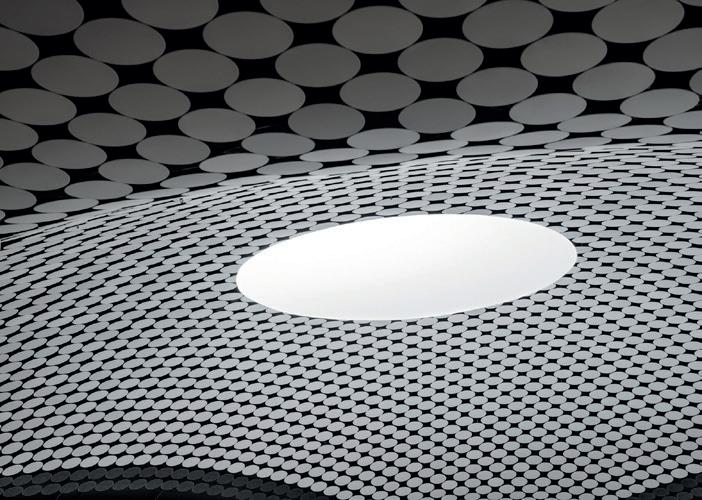
Shirley Valentine (16-17 May)
After a critically-acclaimed first run that saw over 100,000 people buy tickets, Shirley Valentine returns, by demand, to Oscarsteatern in Stockholm for two nights only in May, with Maria Lundqvist once again playing the titular role. The multiple award-winning actress won universal praise for her portrayal of the character first-time round, thanks in no small part to the funny and stylish direction by Edward Af Sillén. The Swedish-language play is a production of the iconic British film of the ‘80s, which follows a middle-aged housewife through a journey of rediscovery.
Oscarsteatern, Stockholm www.oscarsteatern.se
at Gröna Lund (24 May)
The musical comedy trio KAJ are taking Eurovision fans by storm in Sweden, their native Finland and all throughout Europe. The day after they won Melodifestivalen in March, their winning song Bara Bada Bastu broke the record on Spotify Sweden for the most streams in one day. And the song has now (at the time of writing) spent eight weeks at number one in the singles charts of both Sweden and Finland. Bara Bada Bastu will represent Sweden at the Eurovision Song Contest on 17 May, and has been the bookies’ favourite to take the win in the run up to the contest. Will the Gröna Lund concert in Stockholm serve as the trio’s victory lap?
Gröna Lund, Sweden www.gronalund.com

(throughout May)
Swedish band GHOST are set for their biggest world tour yet, and during the second half of May, the group is making a few stops across the Nordics. Known for their spectacular live performances, this is a night that metal fans won’t want to miss; after these Scandinavian stops, the next date on their tour will see the Swedes make their highly anticipated debut at the legendary Madison Square Garden in New York. At the end of April, the Grammywinning, theatrical rock icons released their sixth album SKELETÁ, which saw critics reaffirm their status as one of the genre’s most esteemed creative forces. Copenhagen (17 May), Tampere (20), Linköping (22), Sandviken (23), Oslo (24) www.ghost-official.com

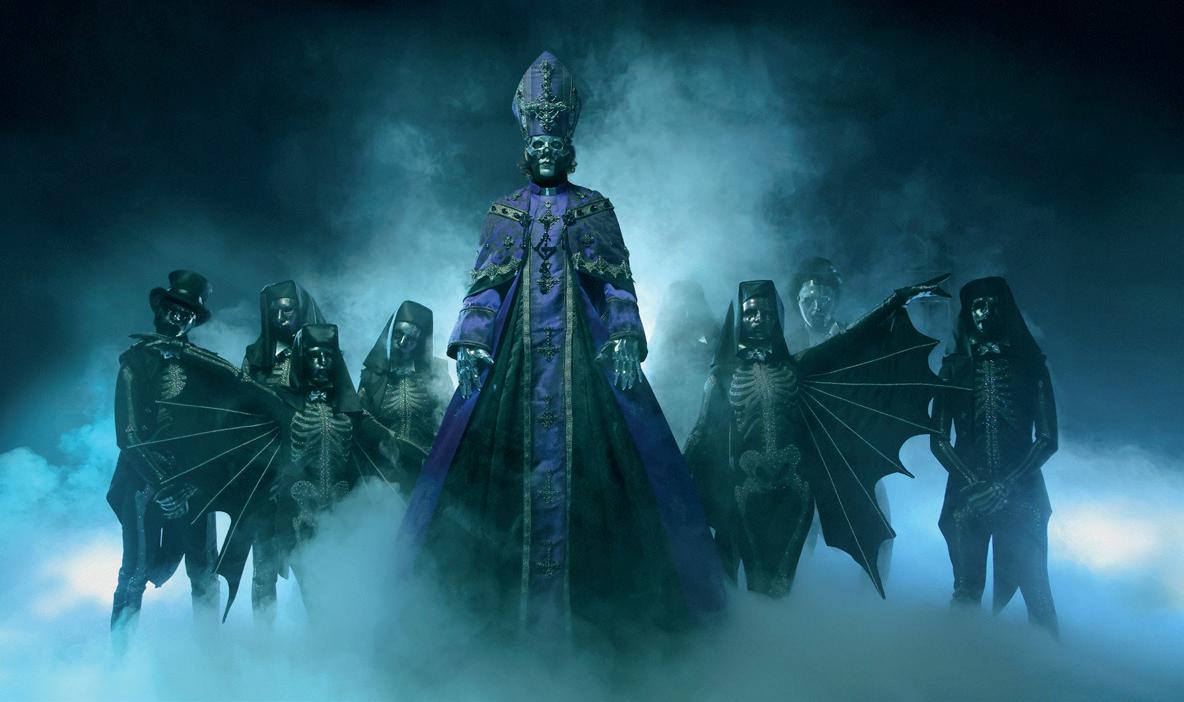
Scan Magazine Issue 178 May 2025
Published 05.2025
ISSN 1757-9589
Published by
Scan Client Publishing
Stibo Complete
Executive Editor
Thomas Winther
Creative Director
Mads E. Petersen
Editor
Signe Hansen
Copy-editor
Malin Norman
Graphic Designers
Mercedes Moulia
Mauro Salerno
Cover Photo
Stanley Reagh
Contributors
Anders Lorenzen
Celina Tran
Emma Rödin
Heidi Kokborg
Karl Batterbea
Katharina Kjeldgaard
Malin Norman
Maria Smedstad
Maria Sødal Vole
Molly McPharlin
Ndéla Faye
Teja Lele
Sales & Key Account Managers
Emma Fabritius Nørregaard
Johan Enelycke Mette Tonnessen
Advertising marketing@scanmagazine.co.uk
To Subscribe scanmagazine.co.uk/subscribe
Scan Magazine Ltd
3rd floor, News Building, 3 London Bridge Street, London SE1 9SG, United Kingdom www.scanclientpublishing.com info@scanmagazine.co.uk www.scanmagazine.co.uk
© All rights reserved. Material contained in this publication may not be reproduced, in whole or in part, without prior permission of Scan Magazine Ltd.
Scan Magazine® is a registered trademark of Scan Magazine Ltd.
This magazine contains advertorials/promotional articles
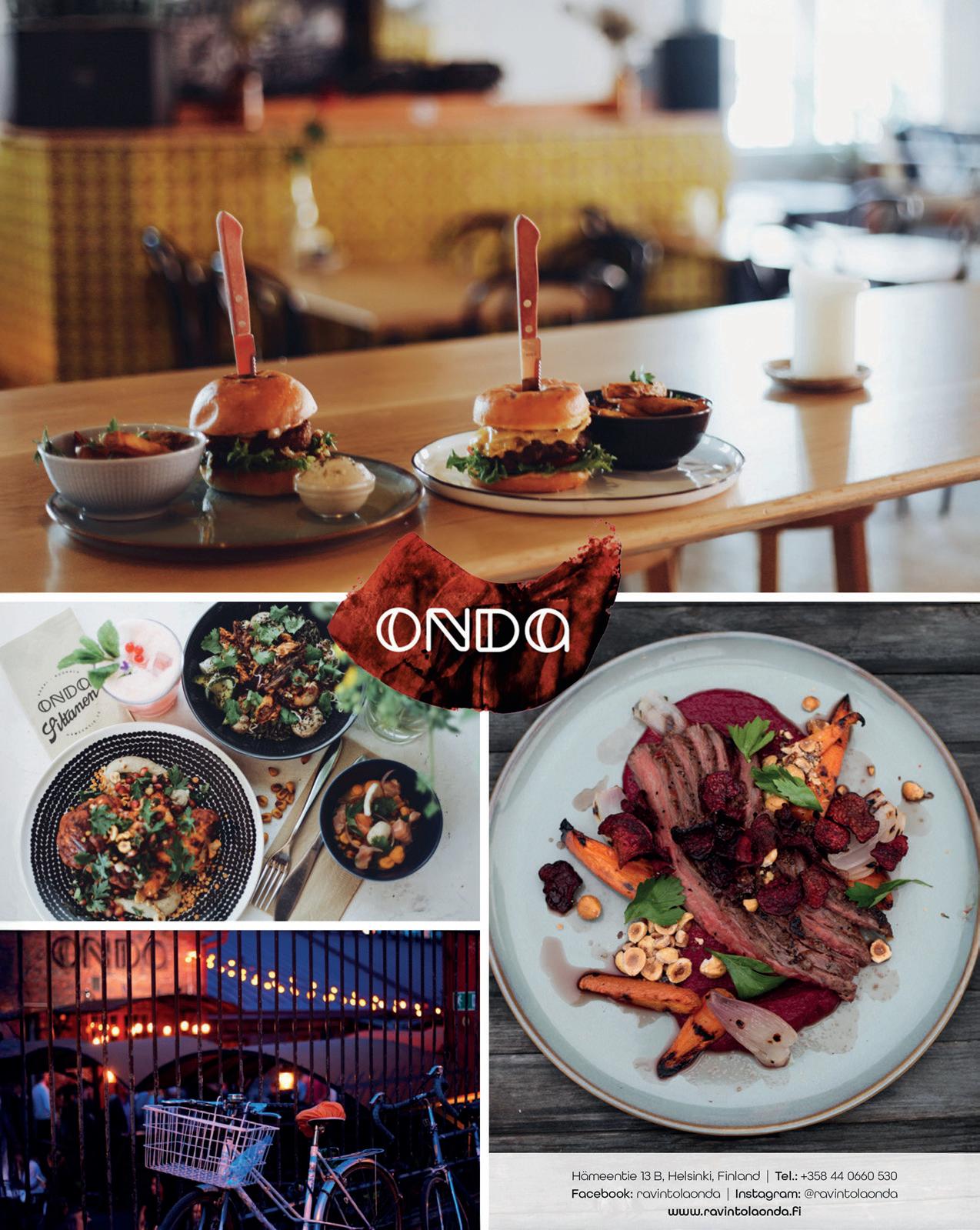



VISIT OUR BEAUTIFUL BAR SMIL FOR A NICE LUNCH IN THE SUMMER


WE HAVE THE ROOMS FOR YOUR PRIVATE PARTY, BUSINESS MEETINGS AND FAMILY OCCASIONS
